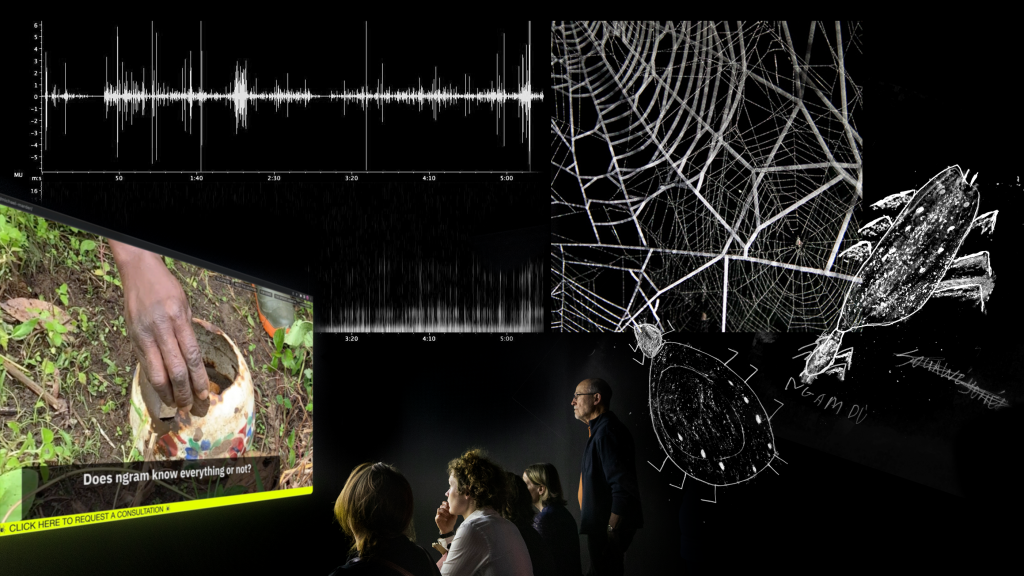

...

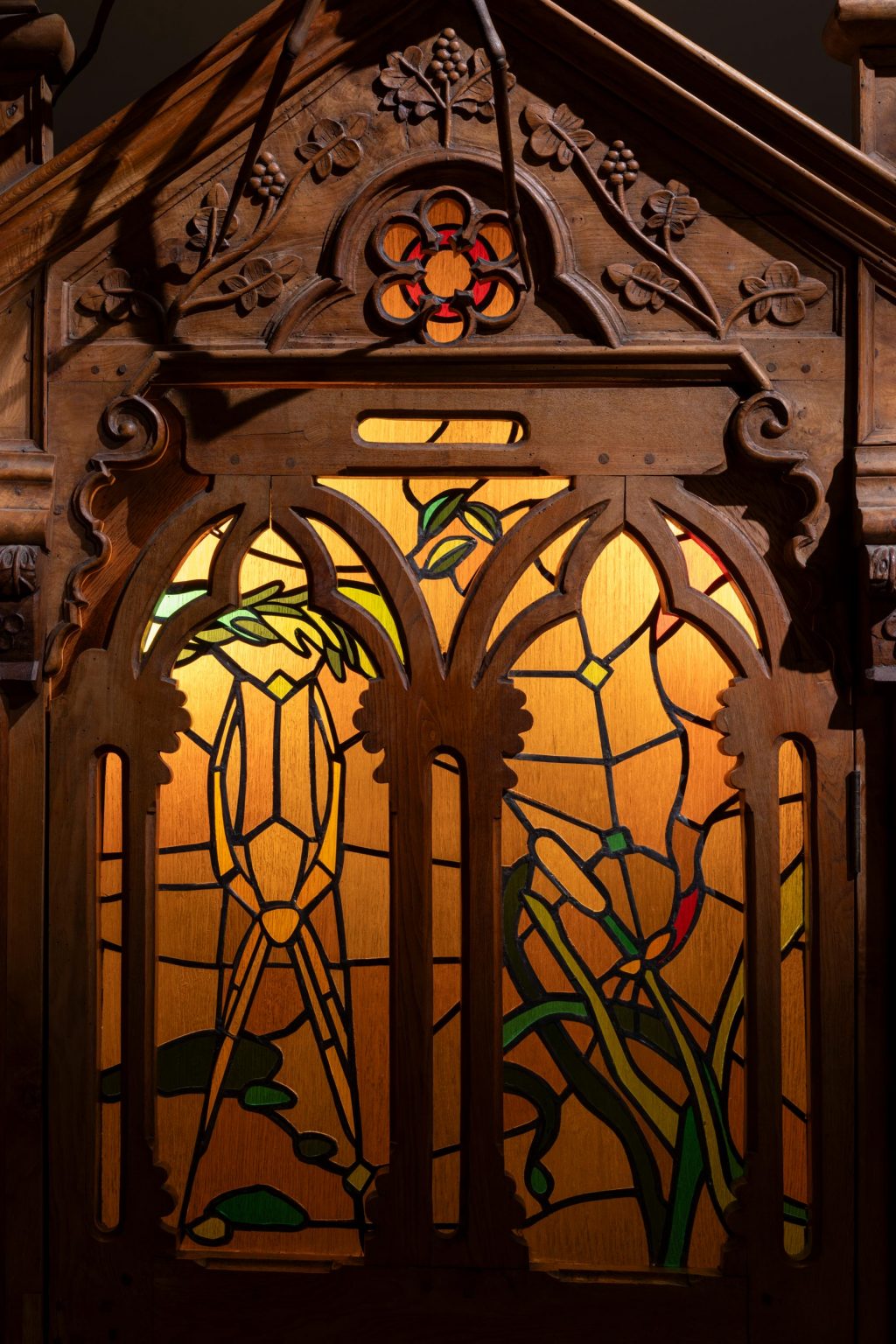
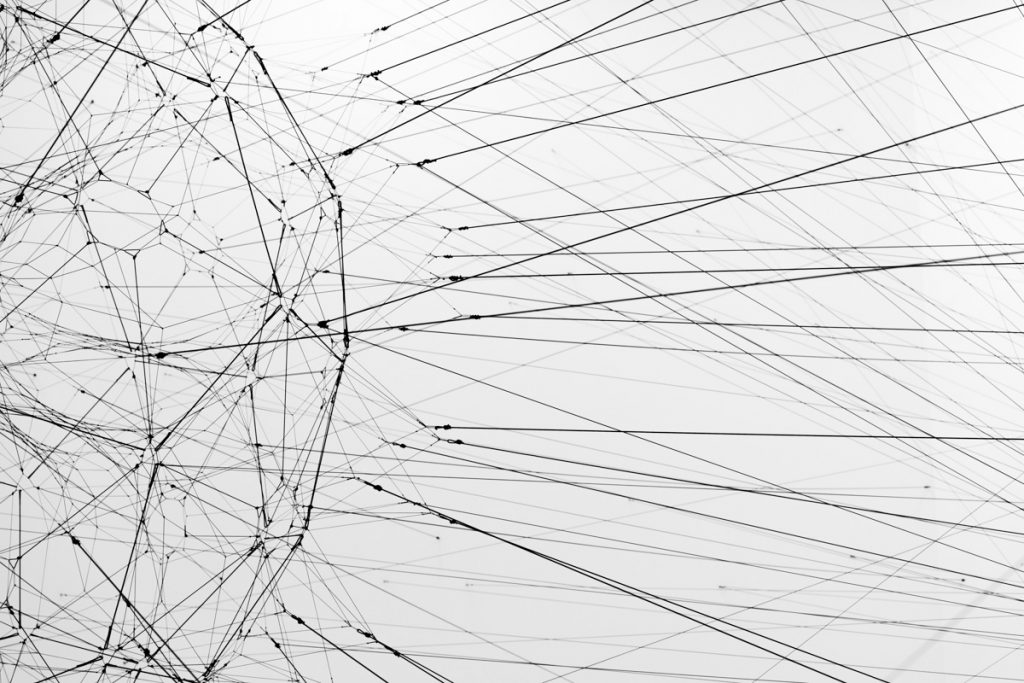
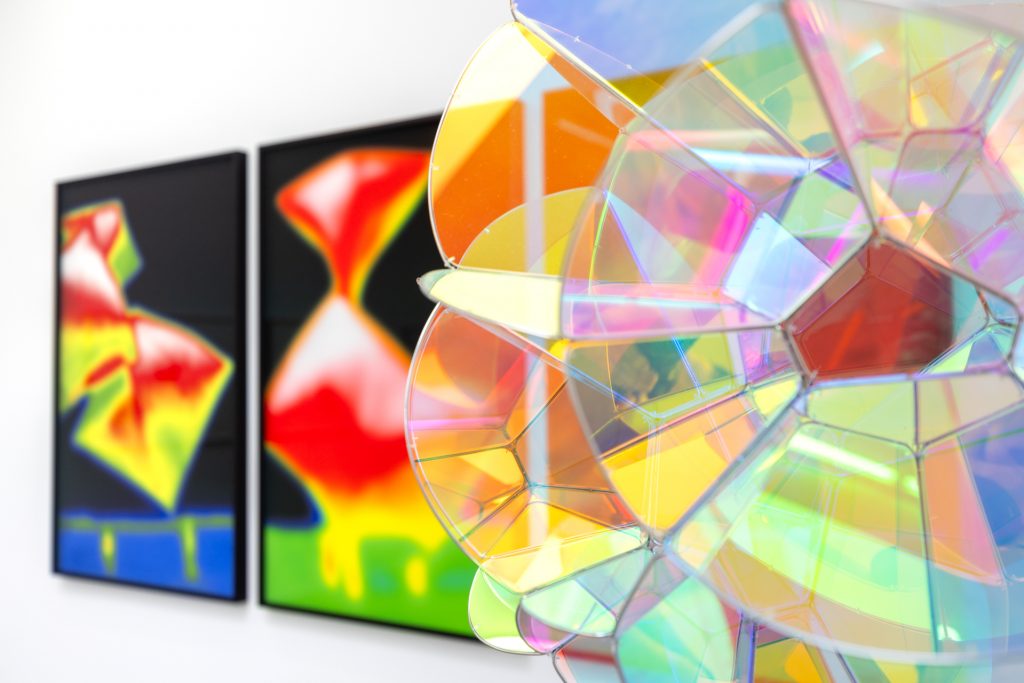
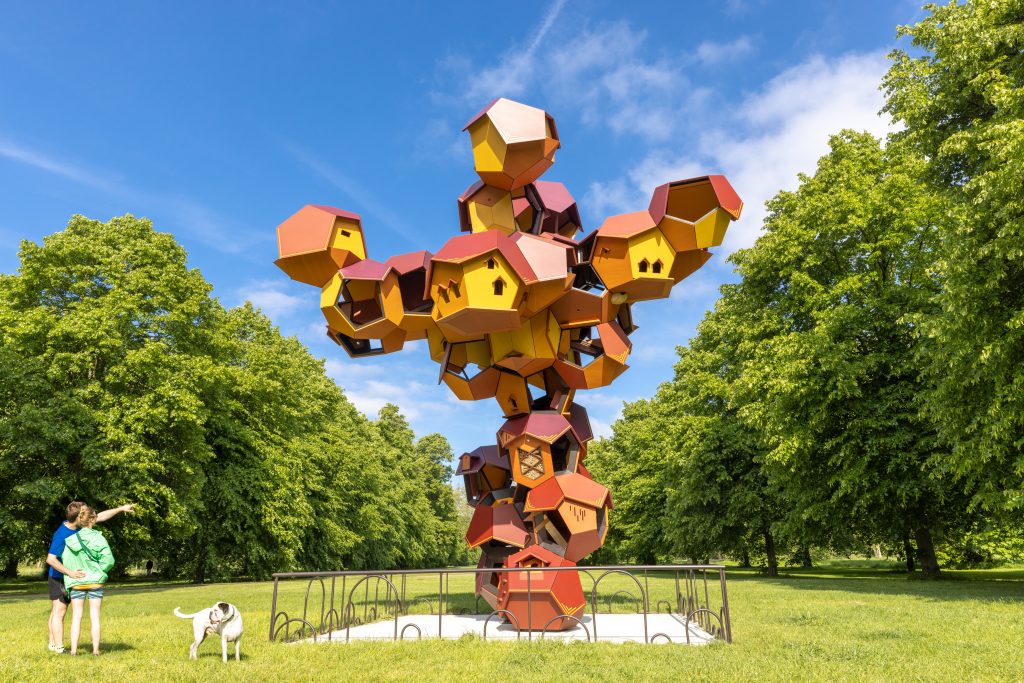
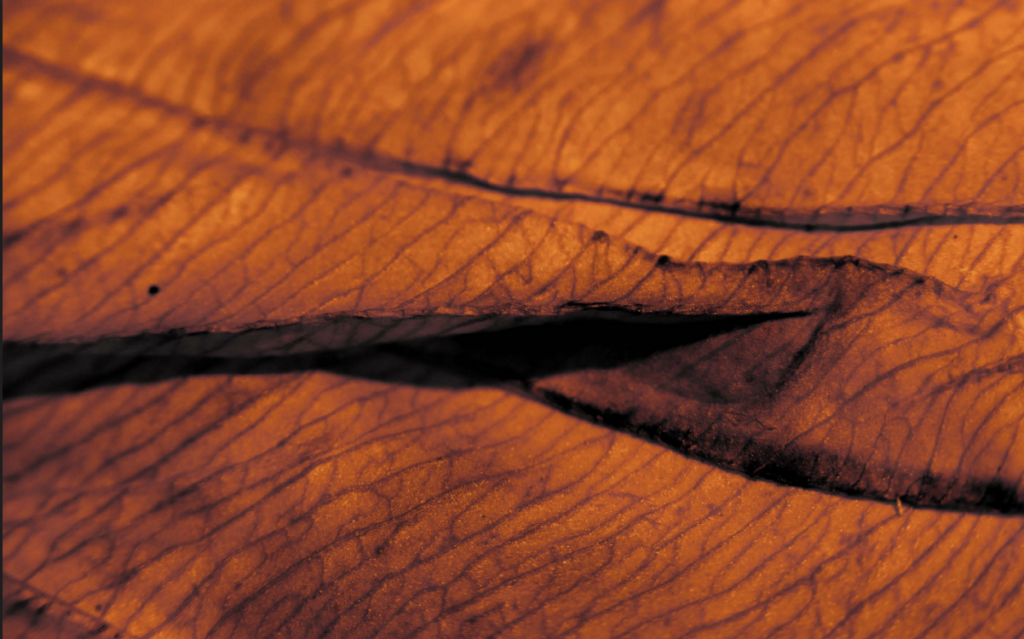
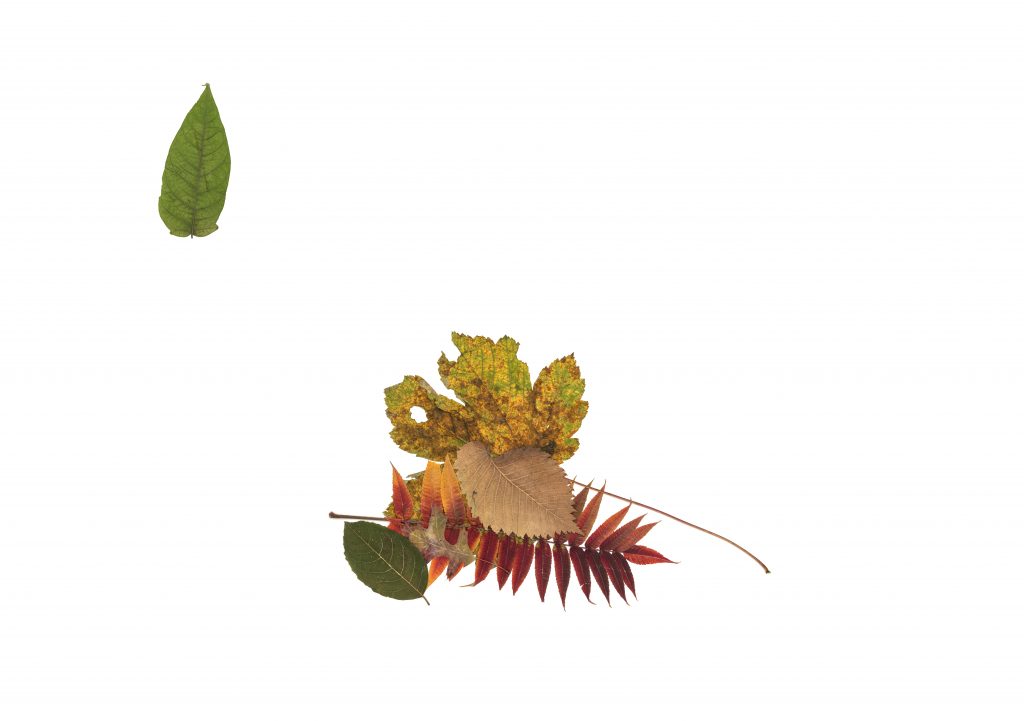
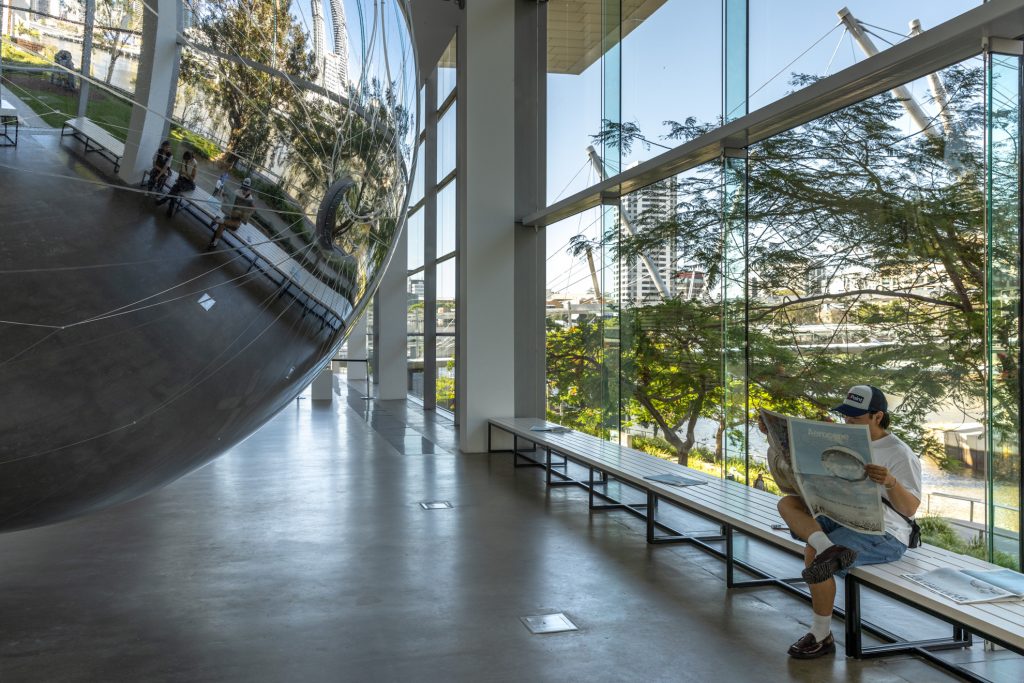
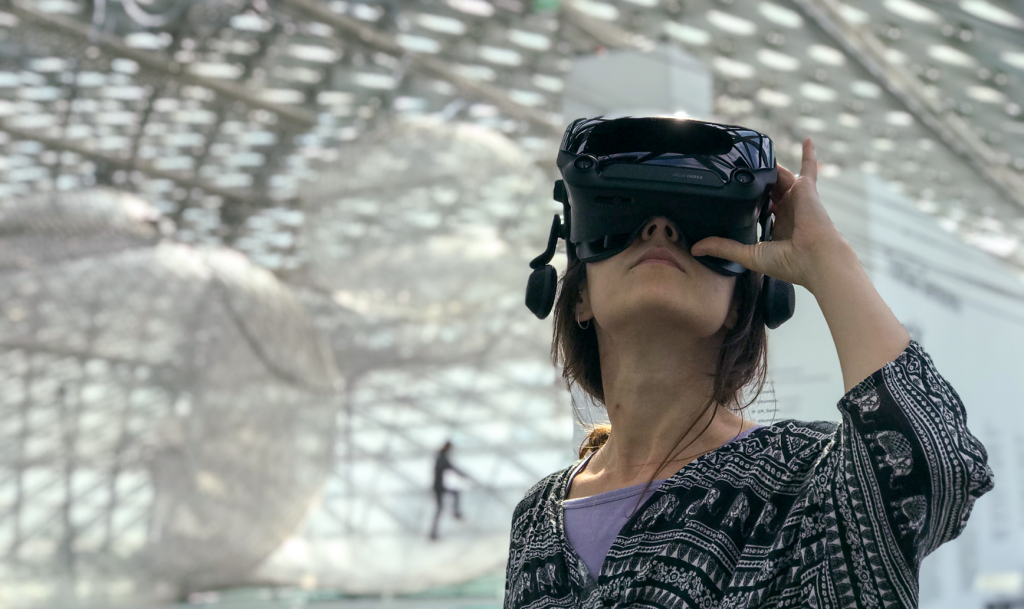
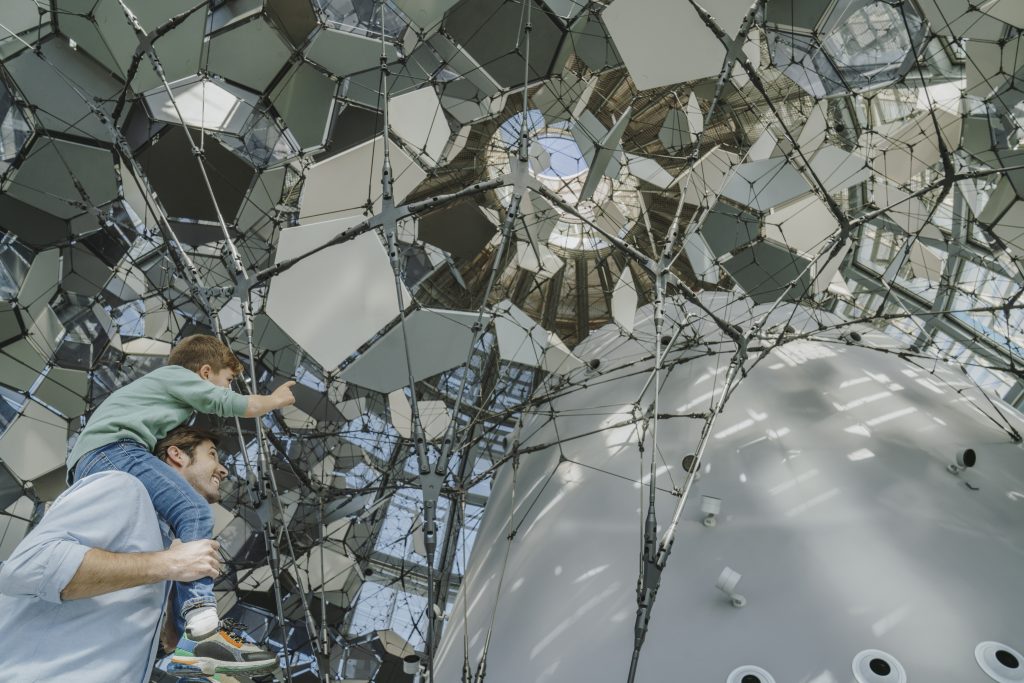
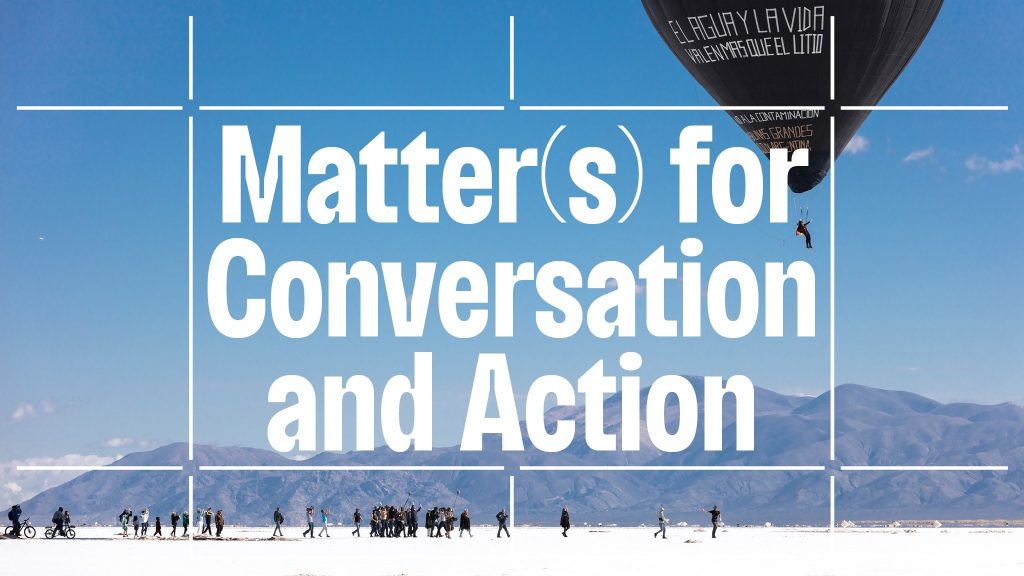
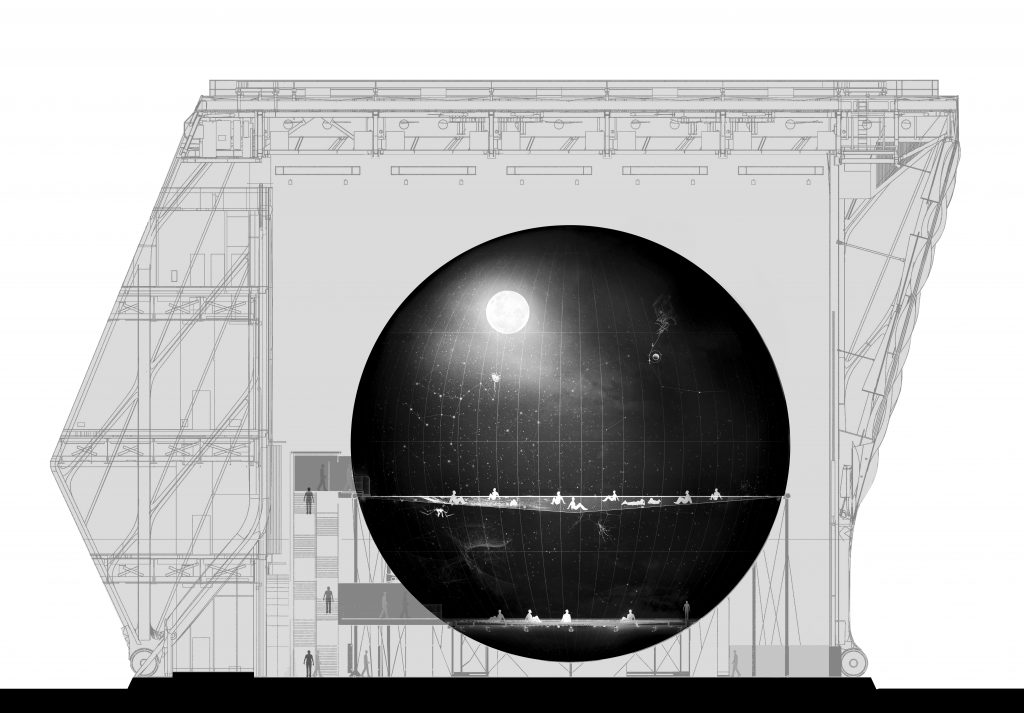
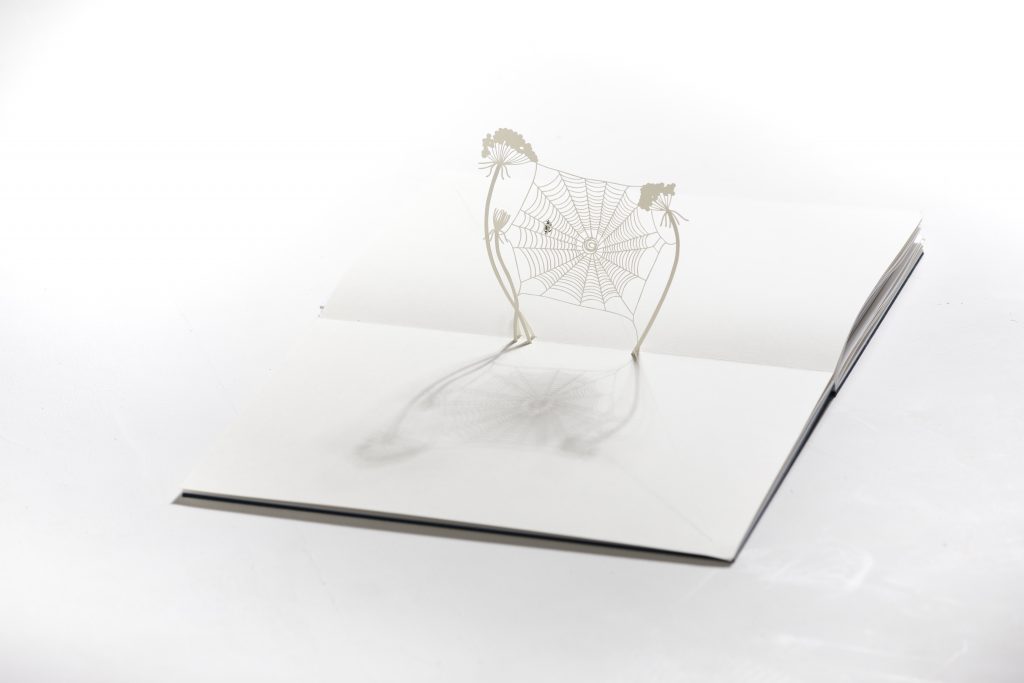
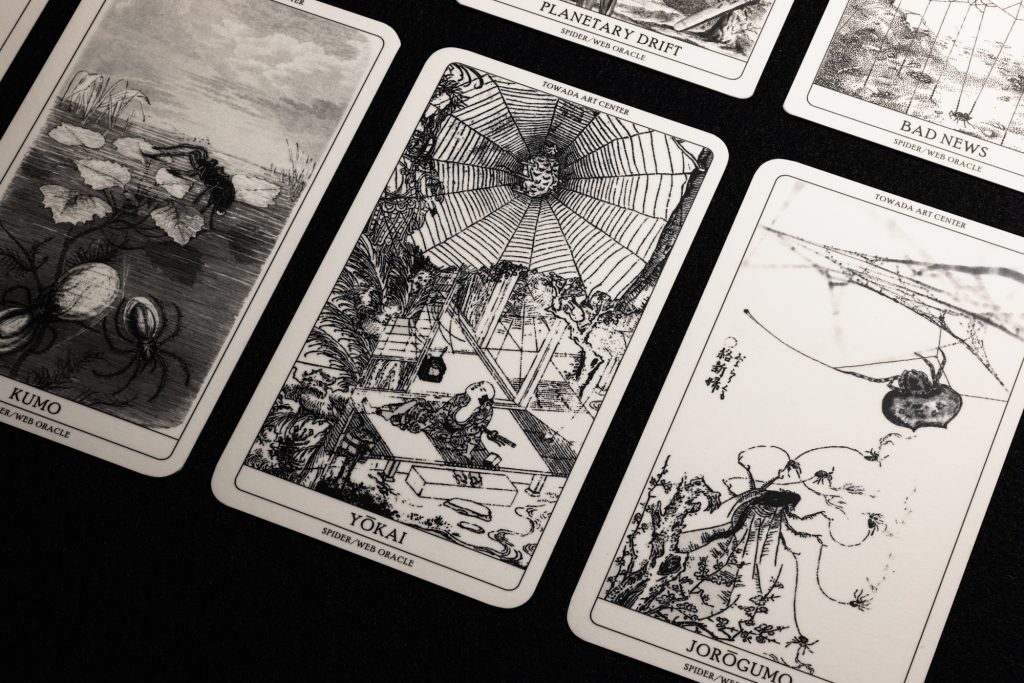
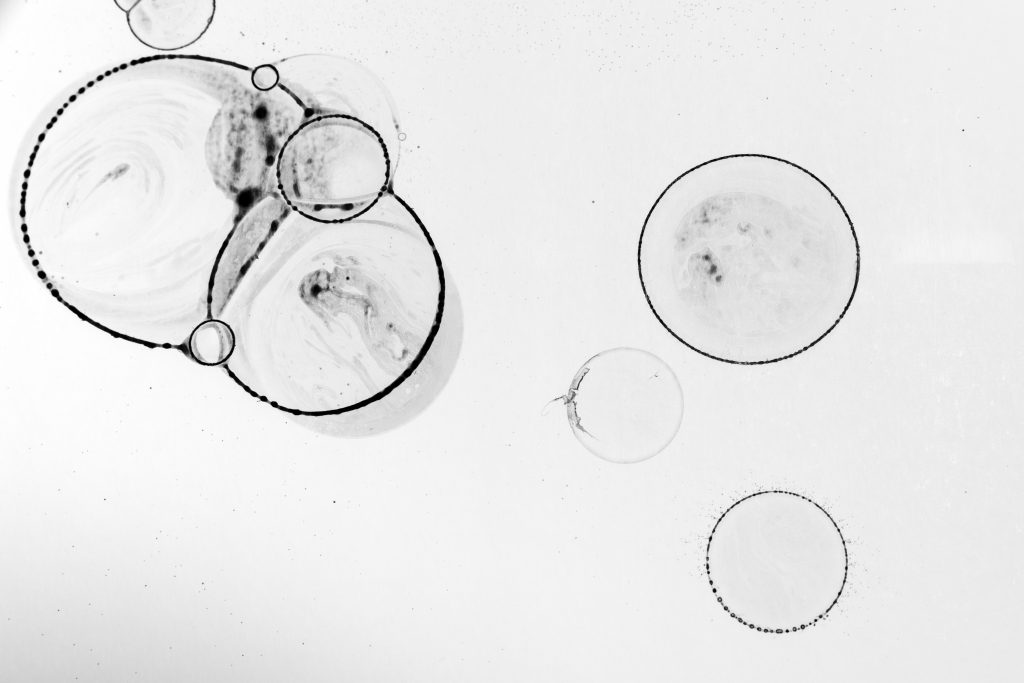
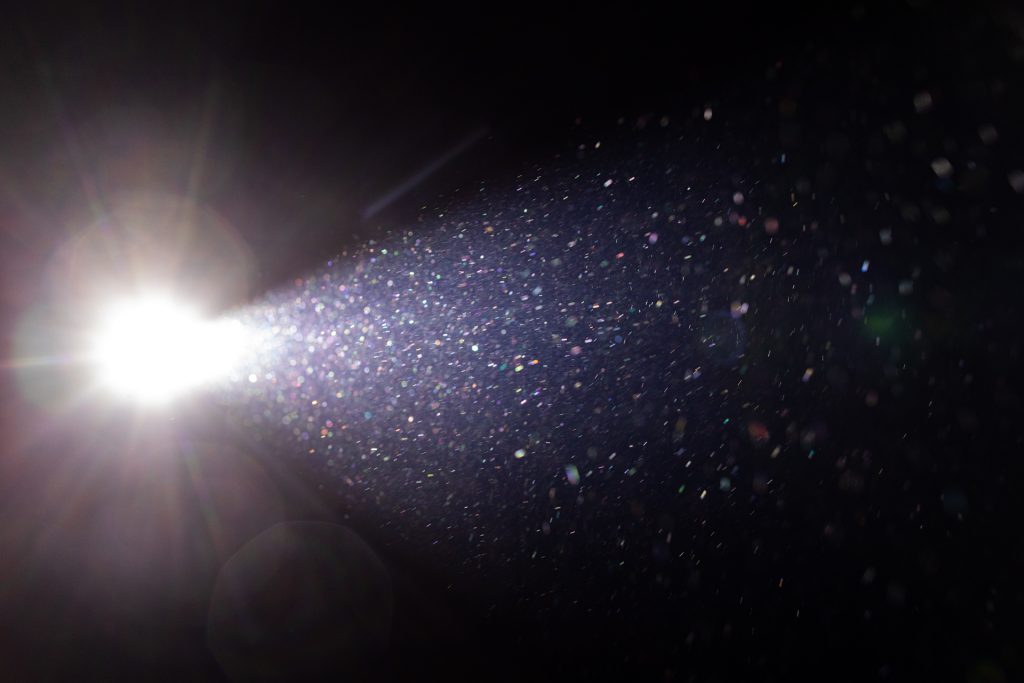
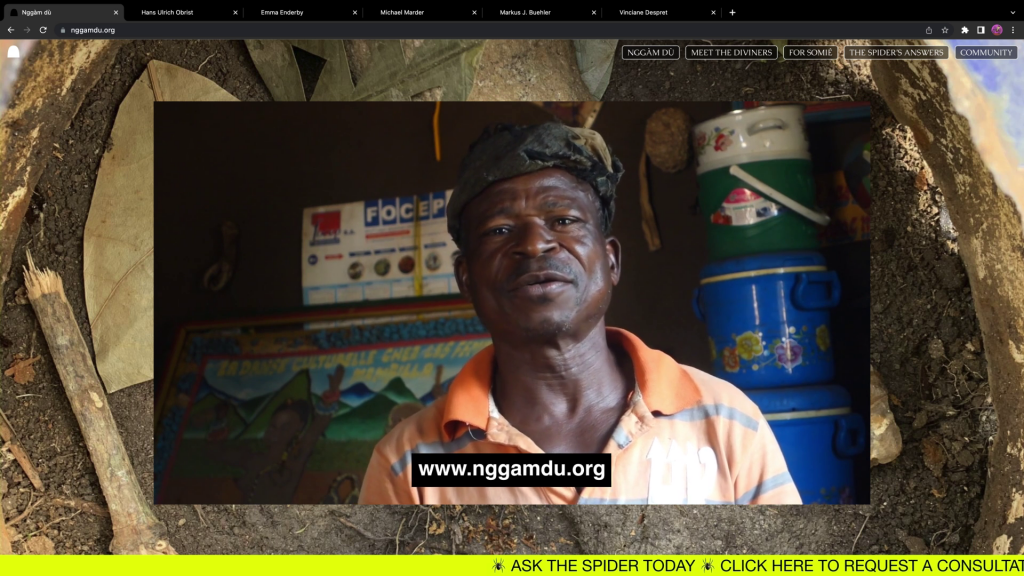
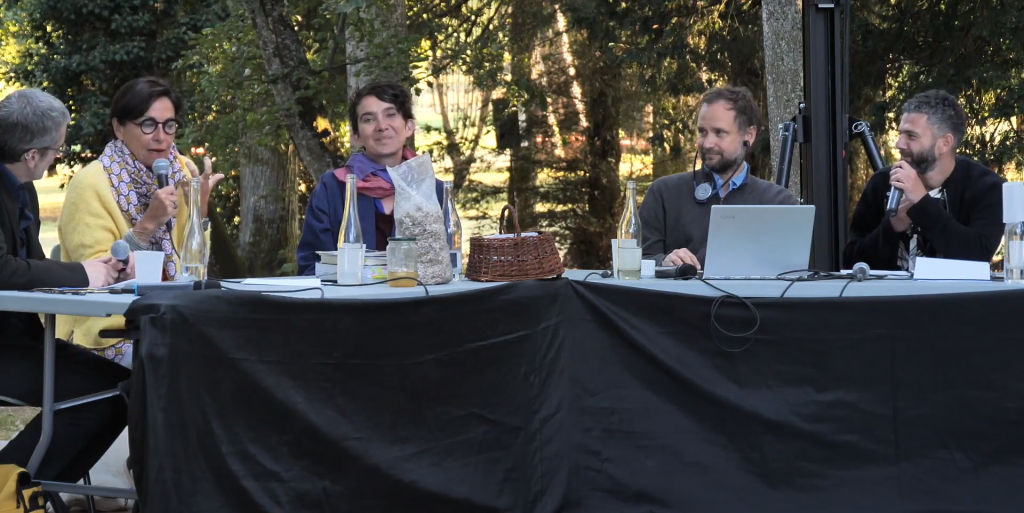
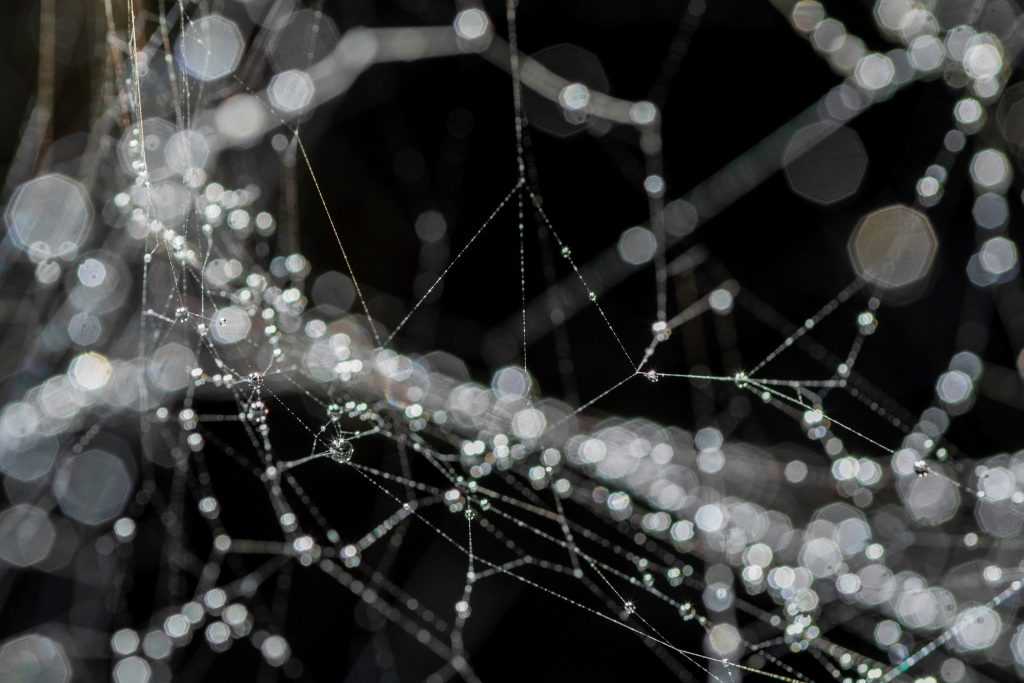
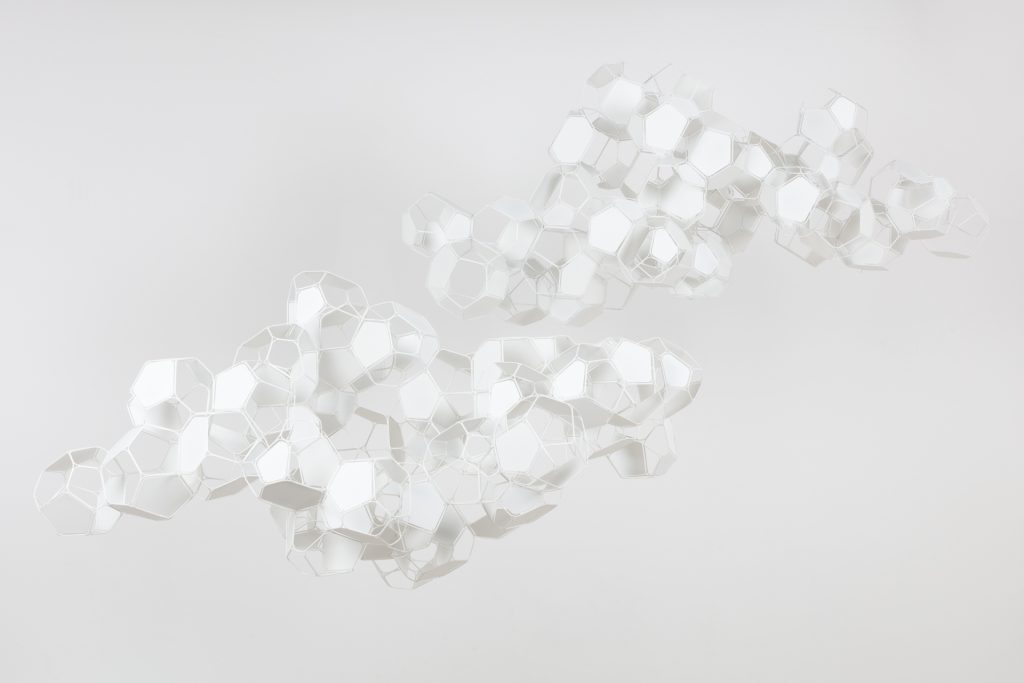
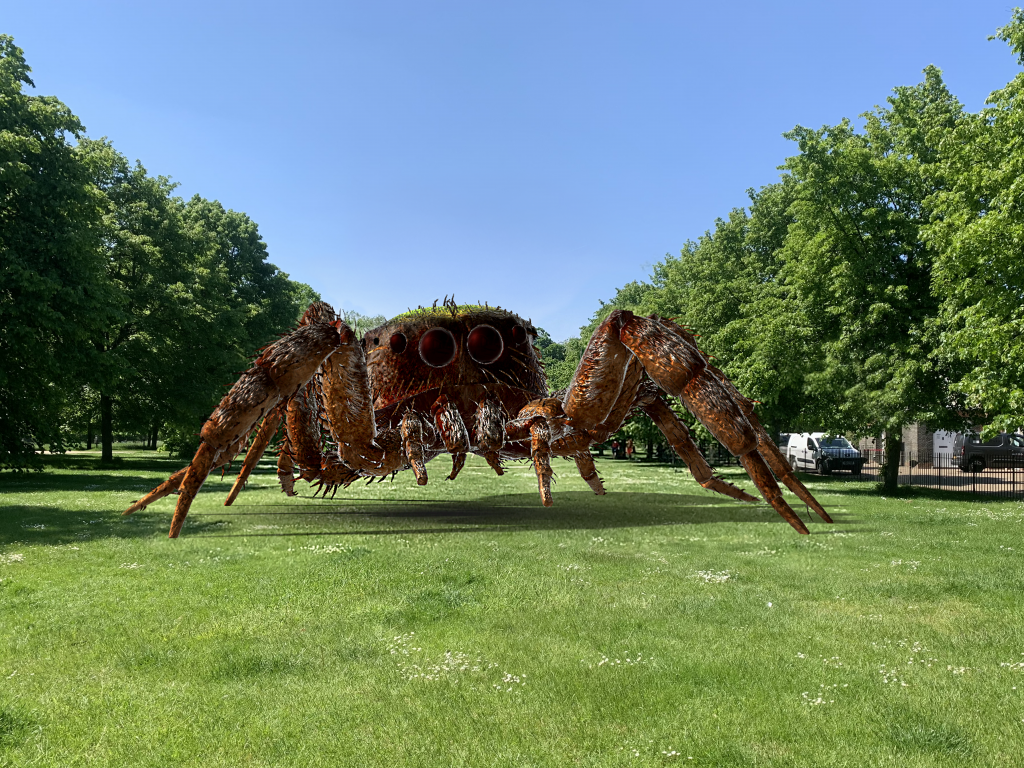
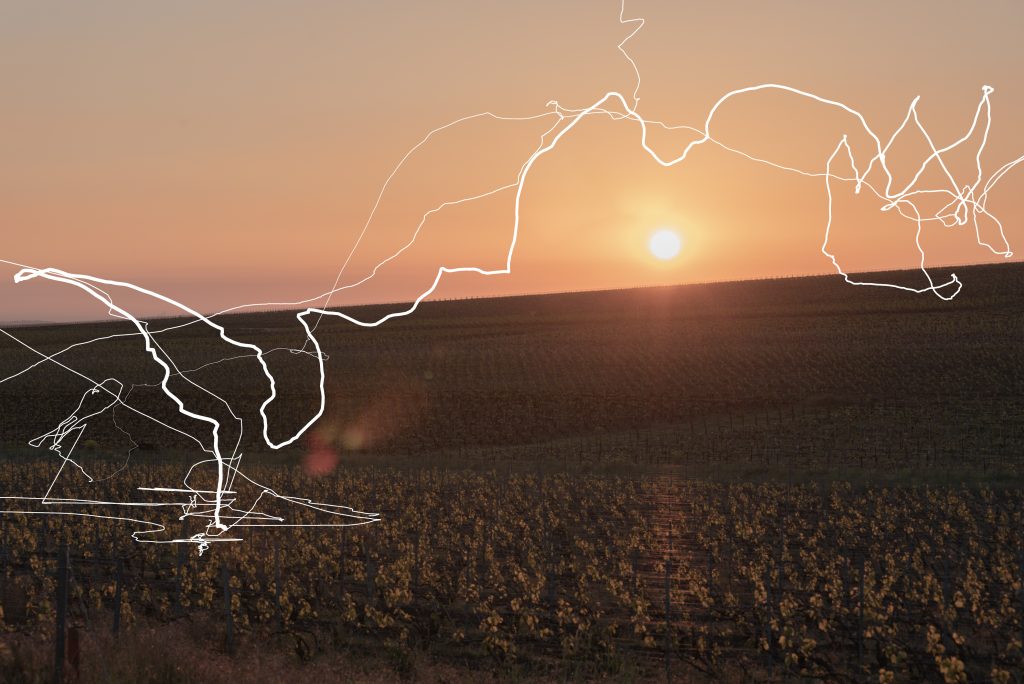
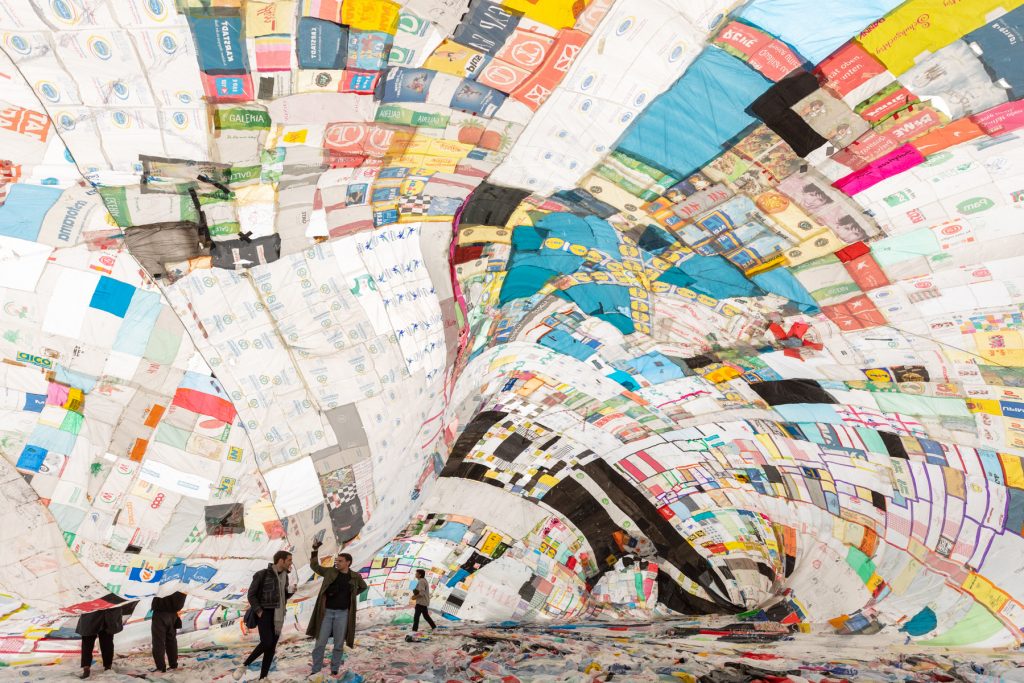
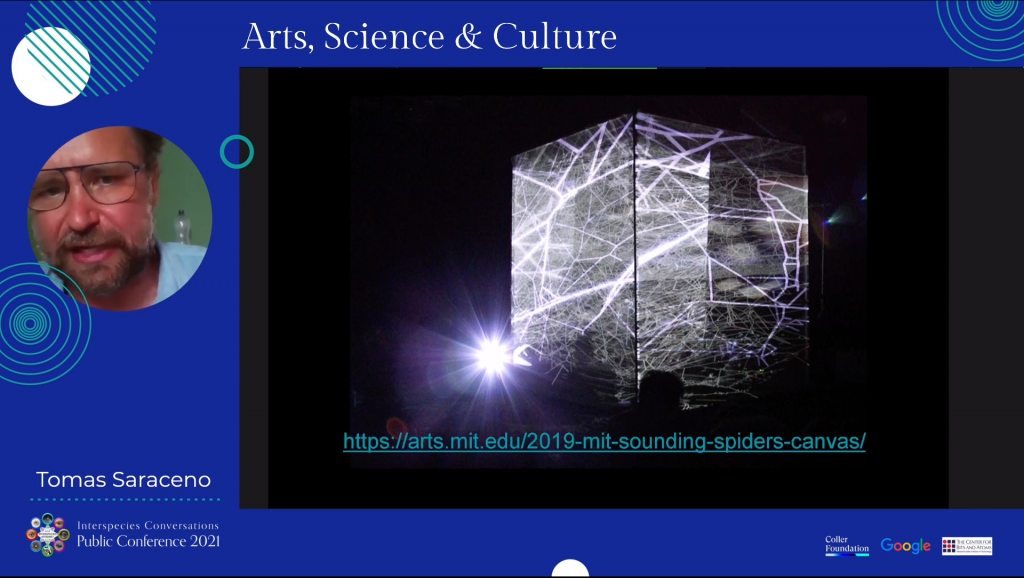
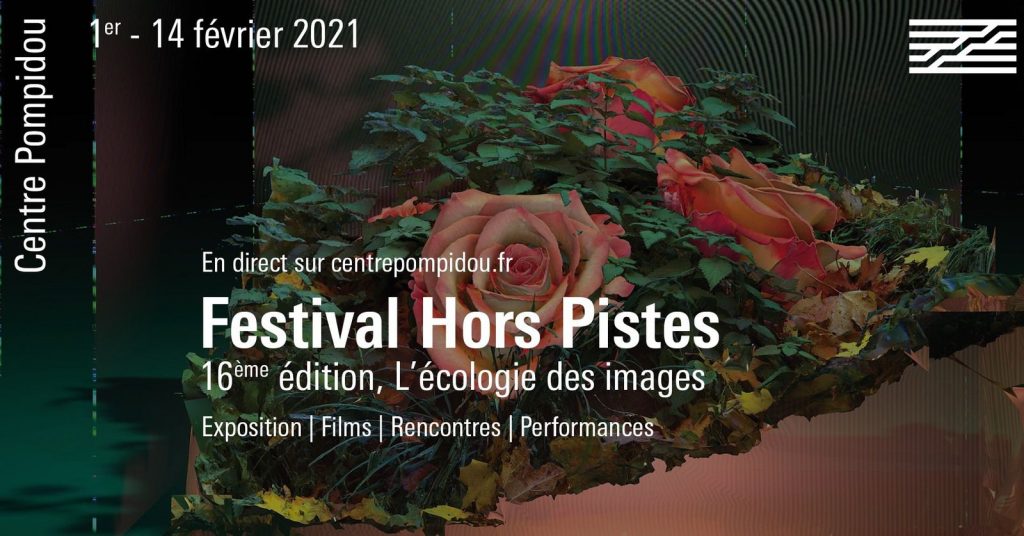
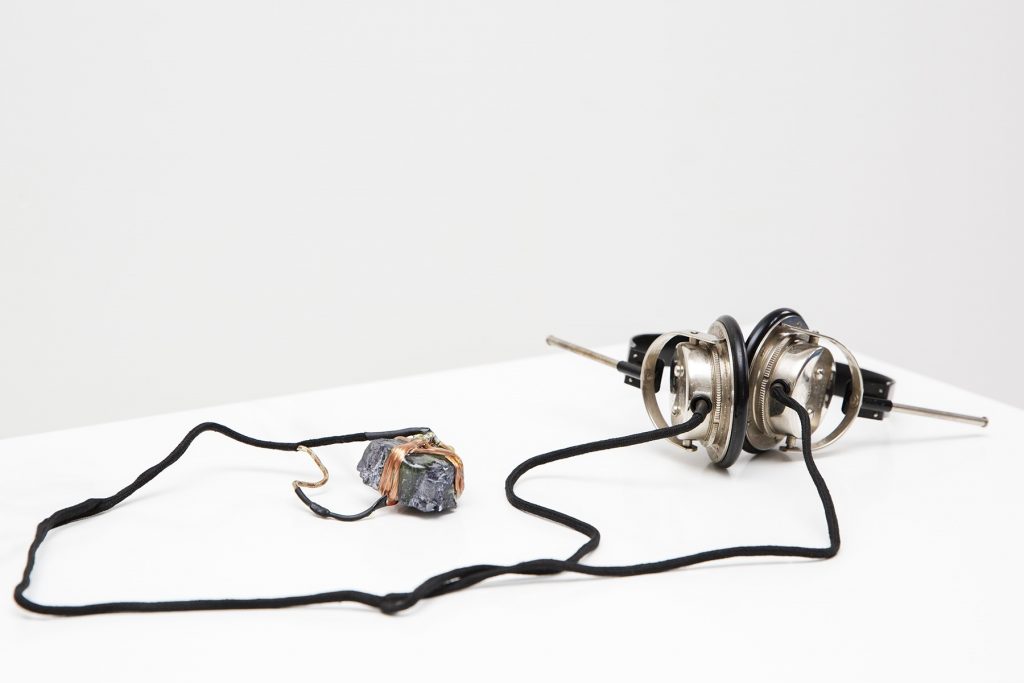
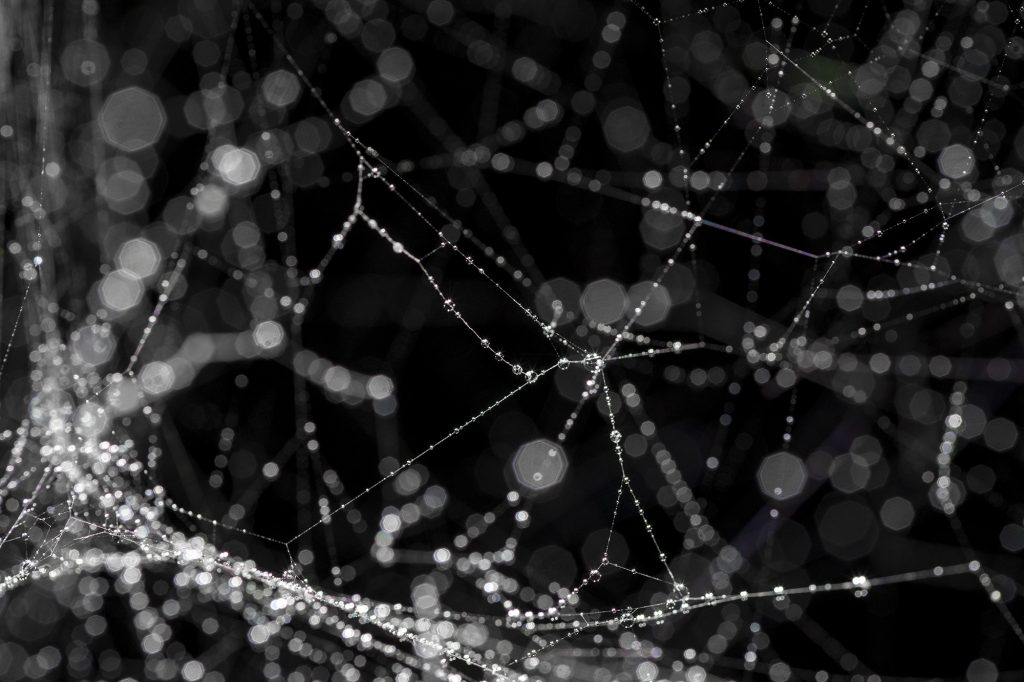
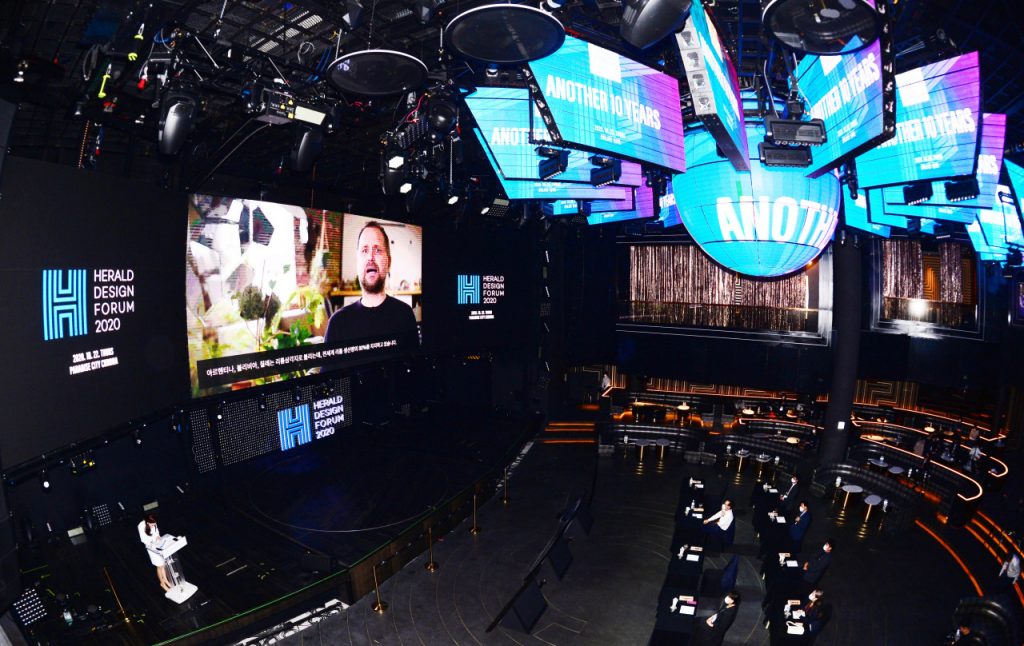
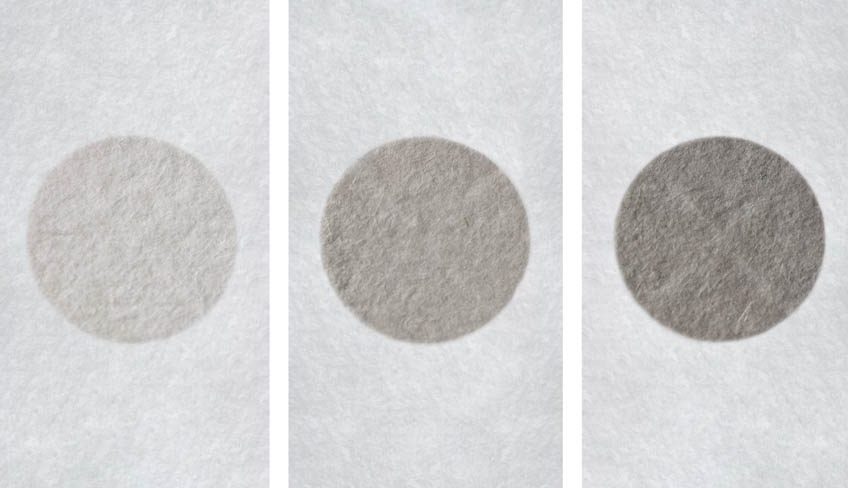
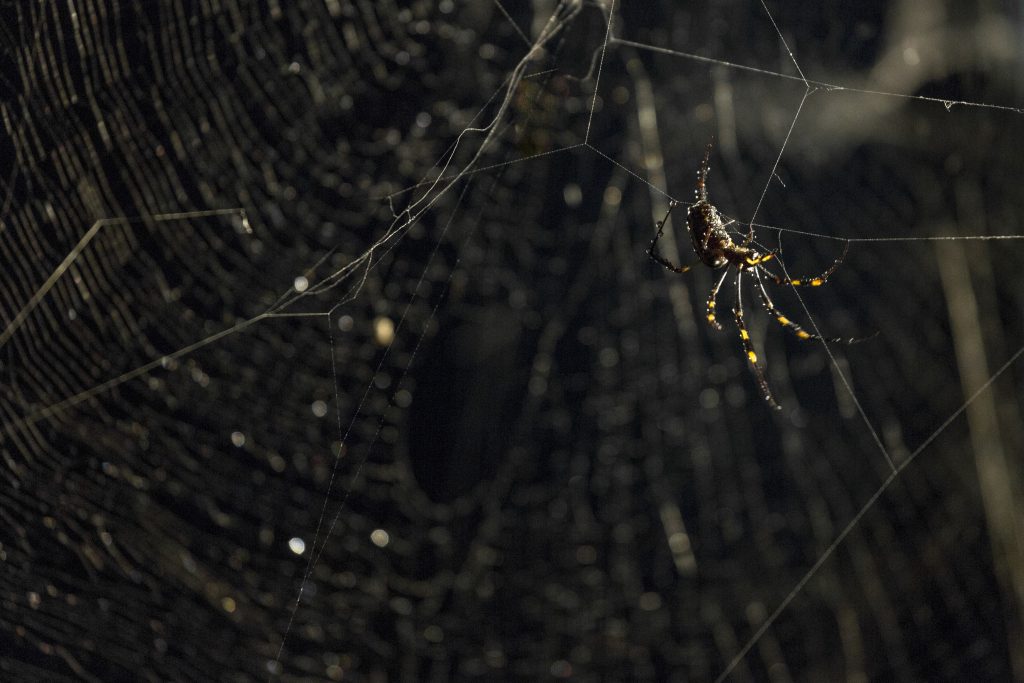
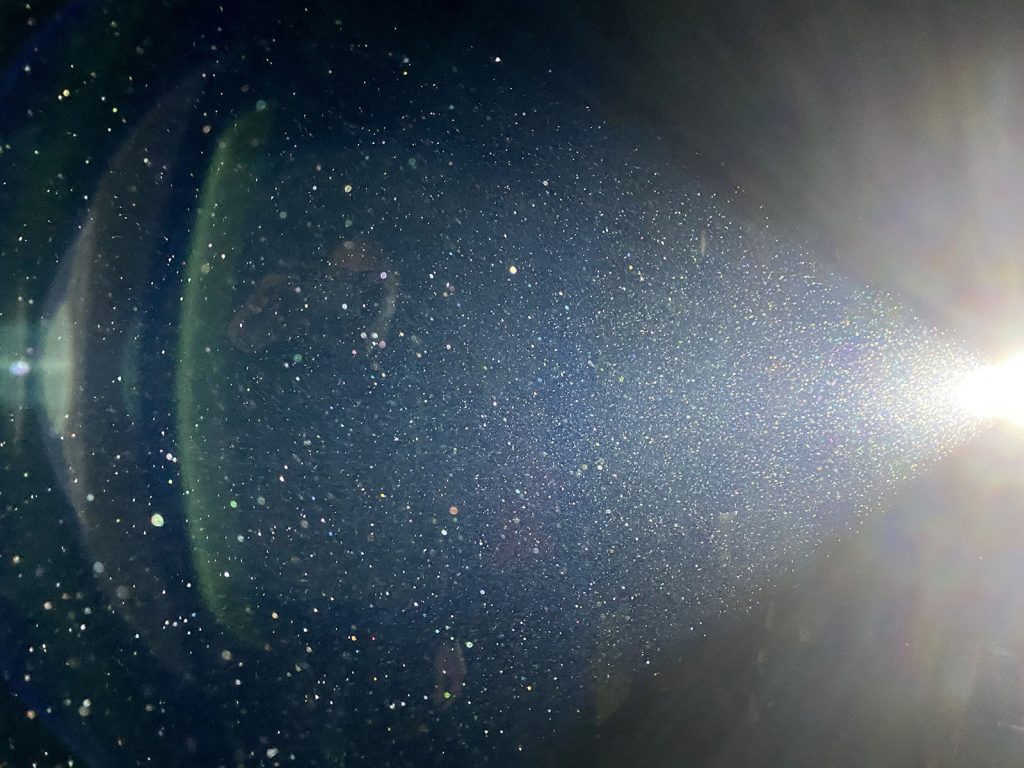
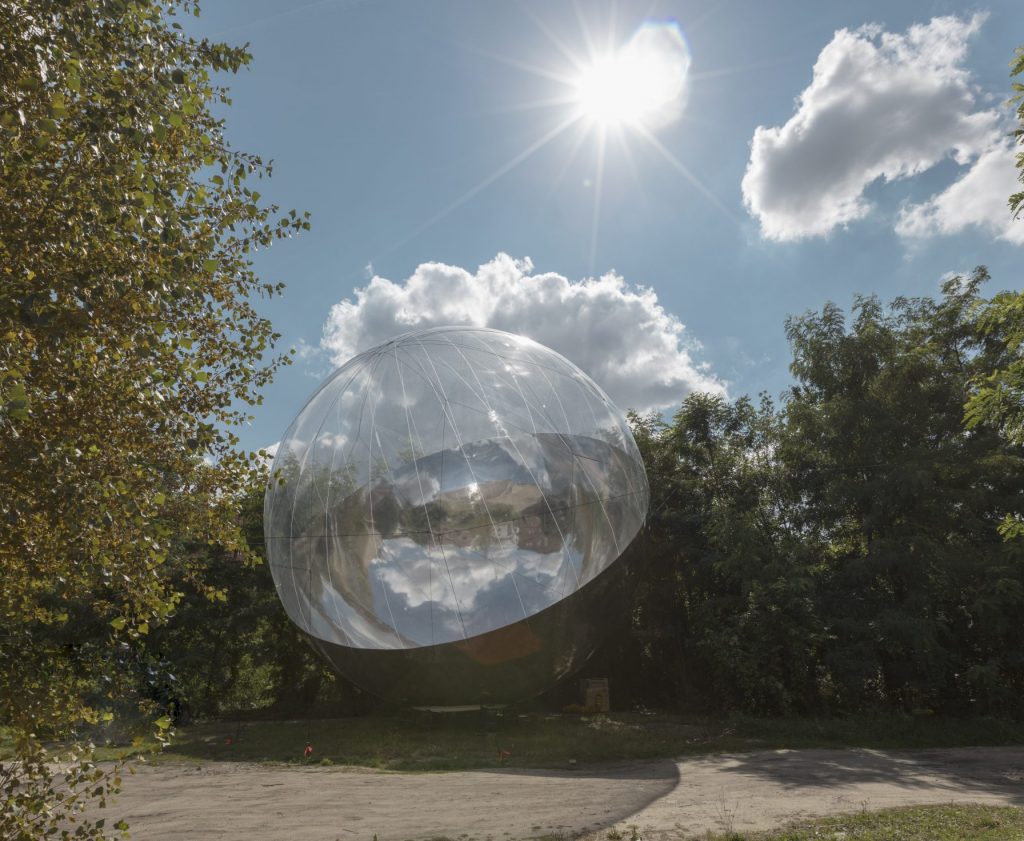
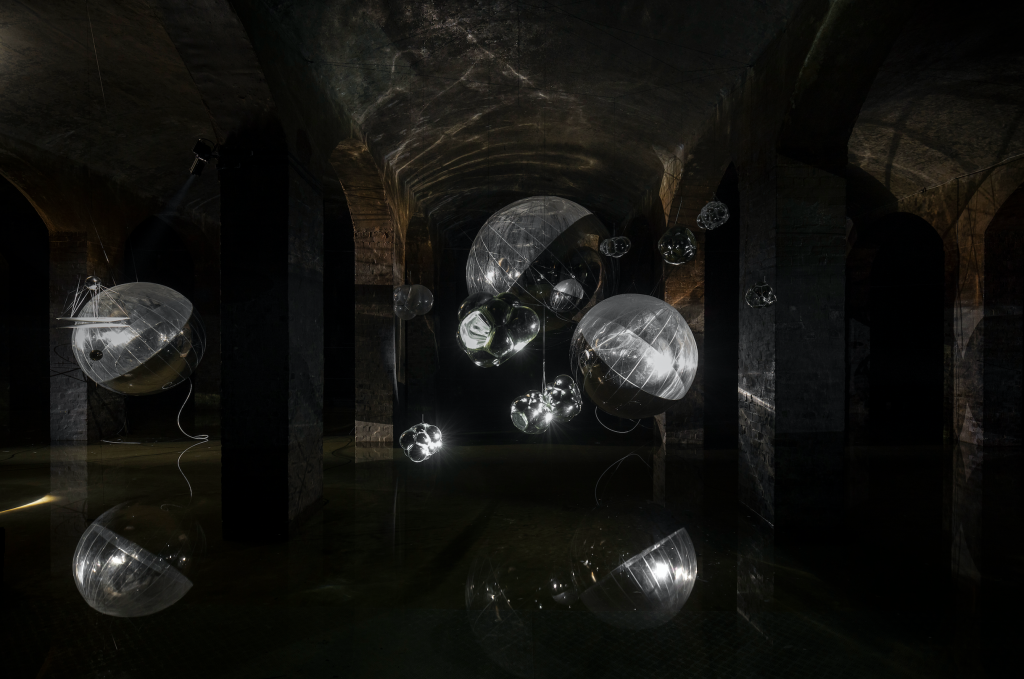
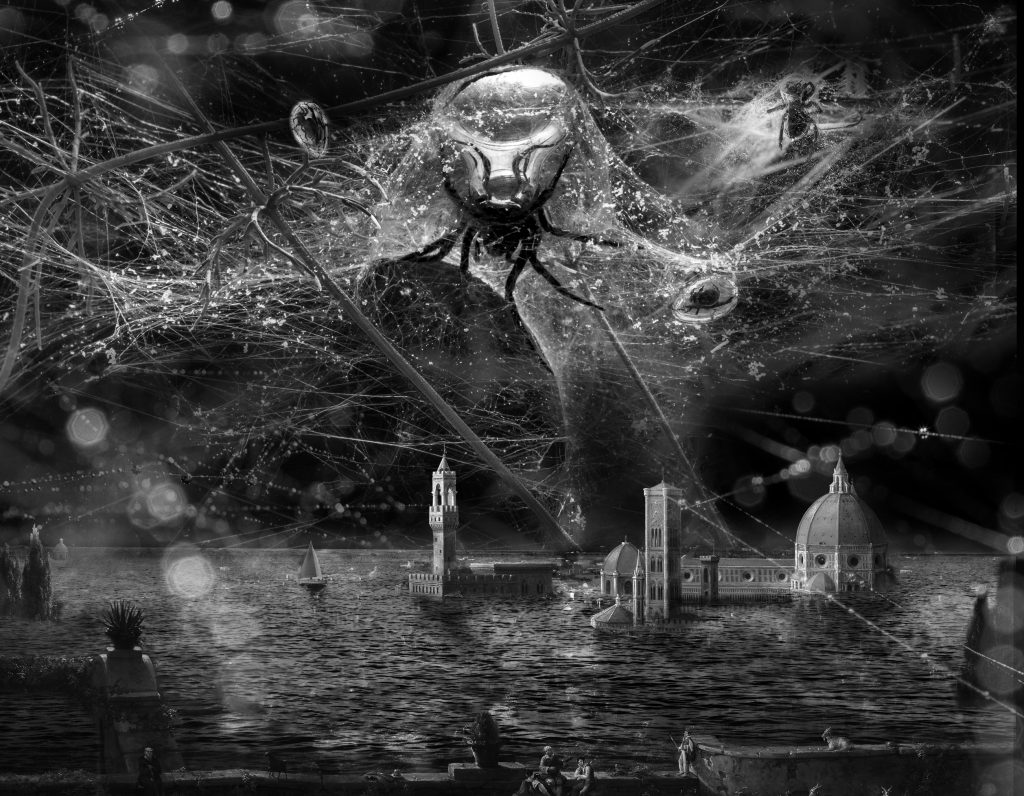
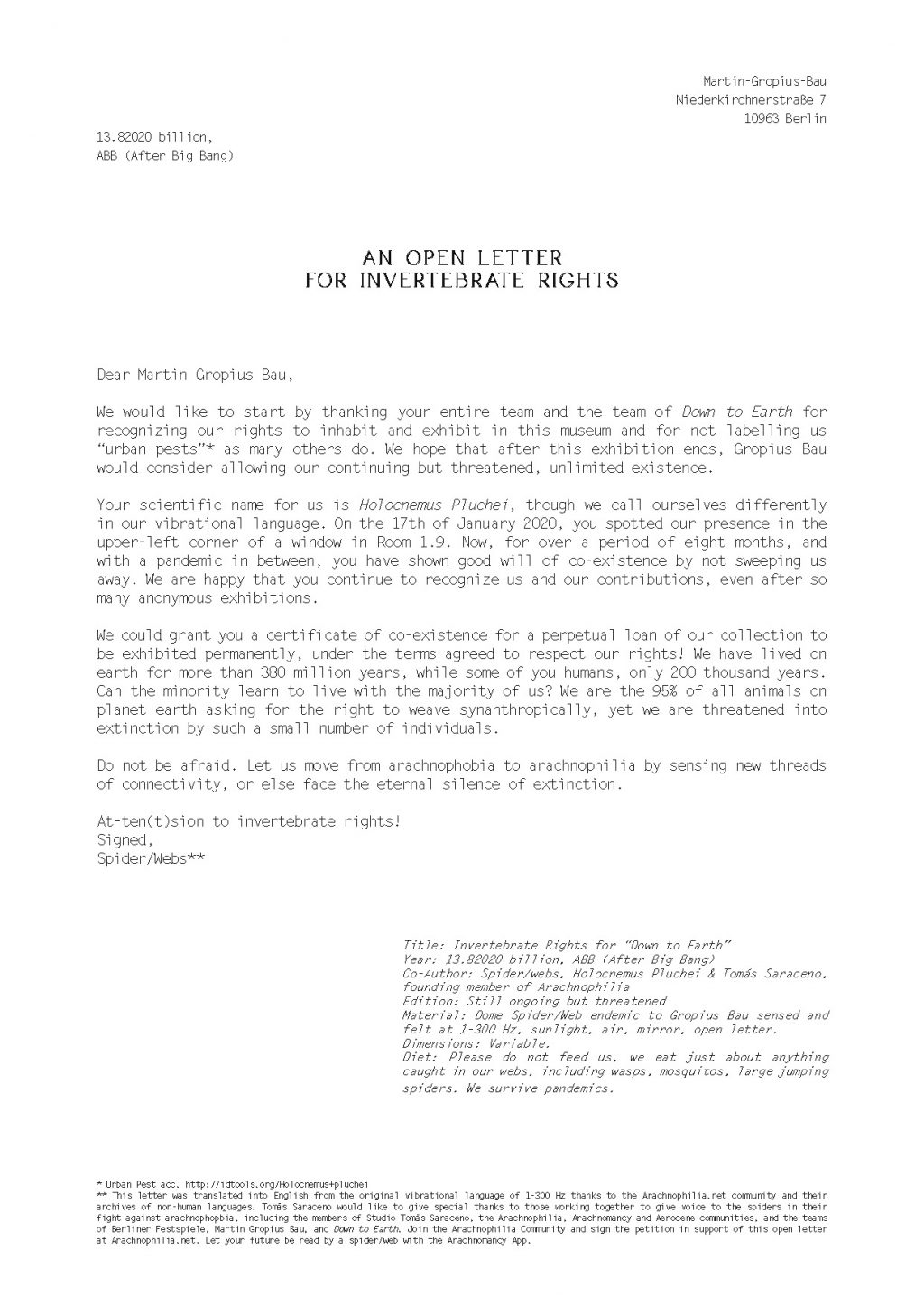

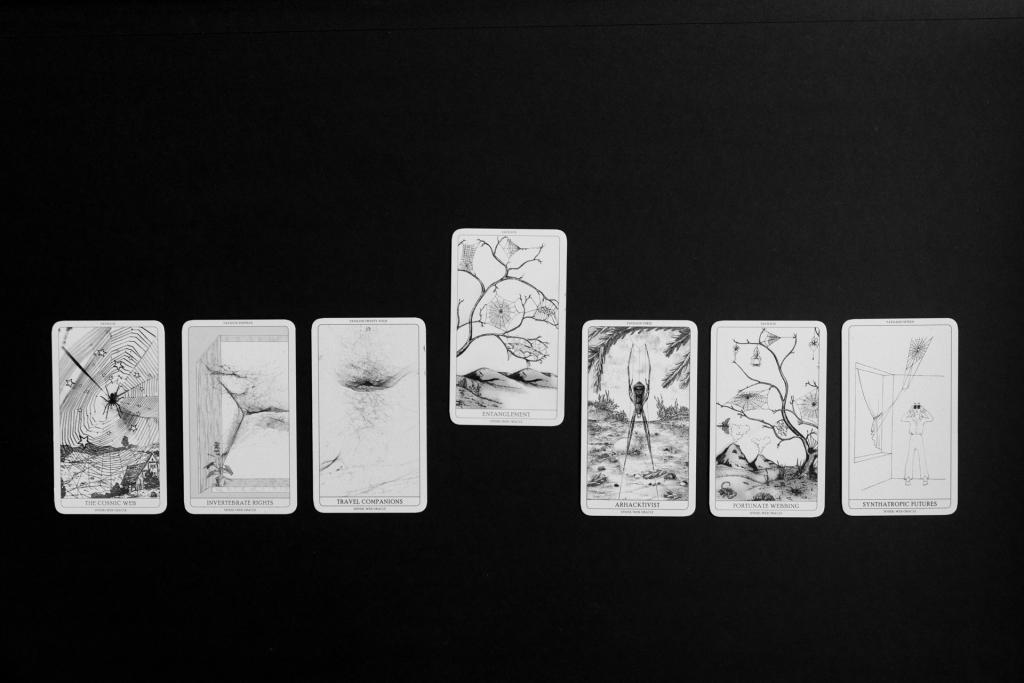
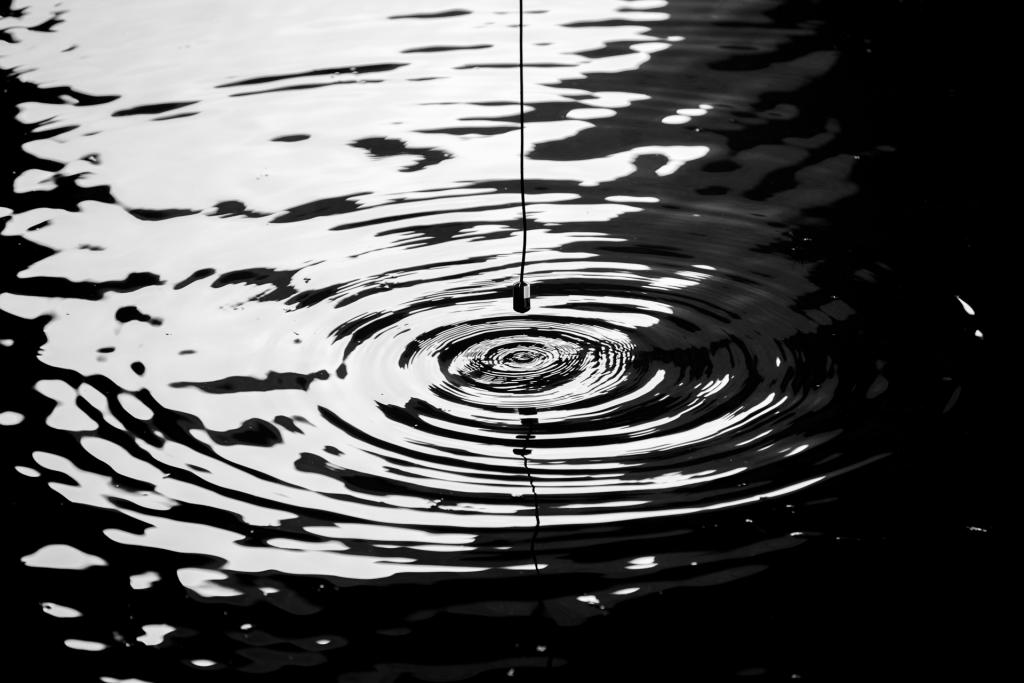
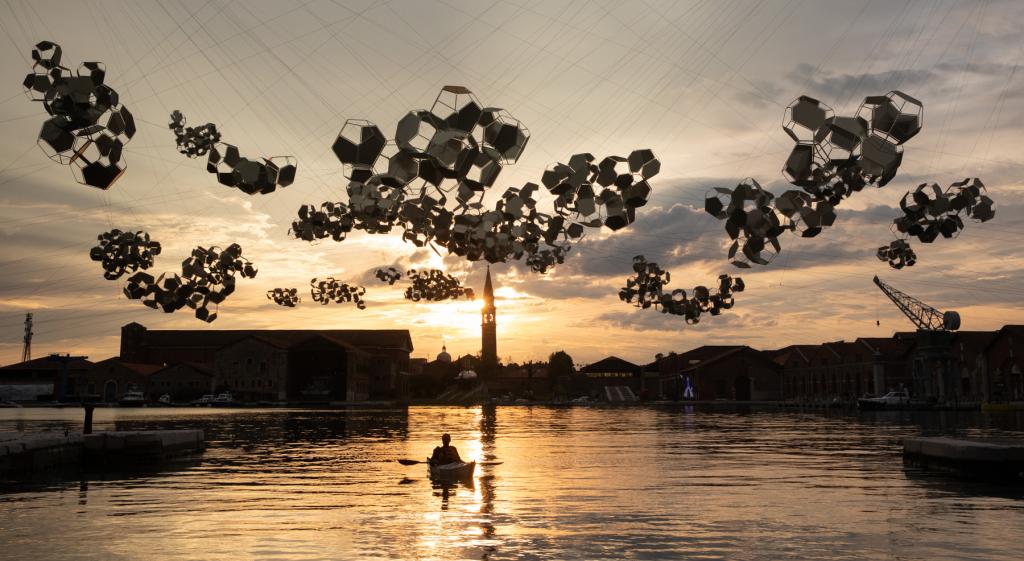
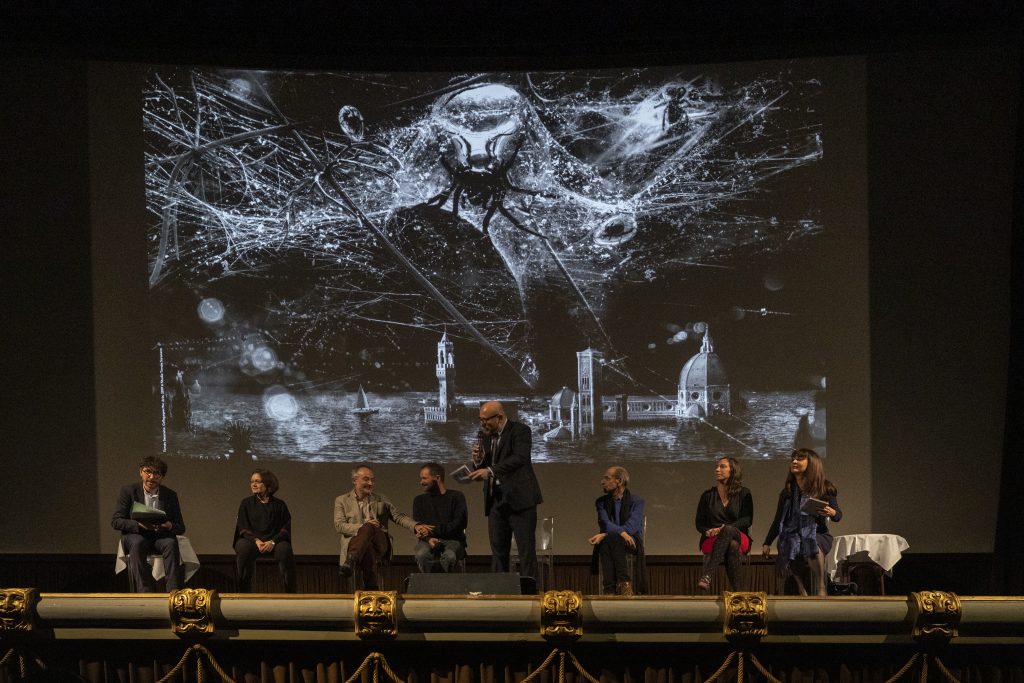
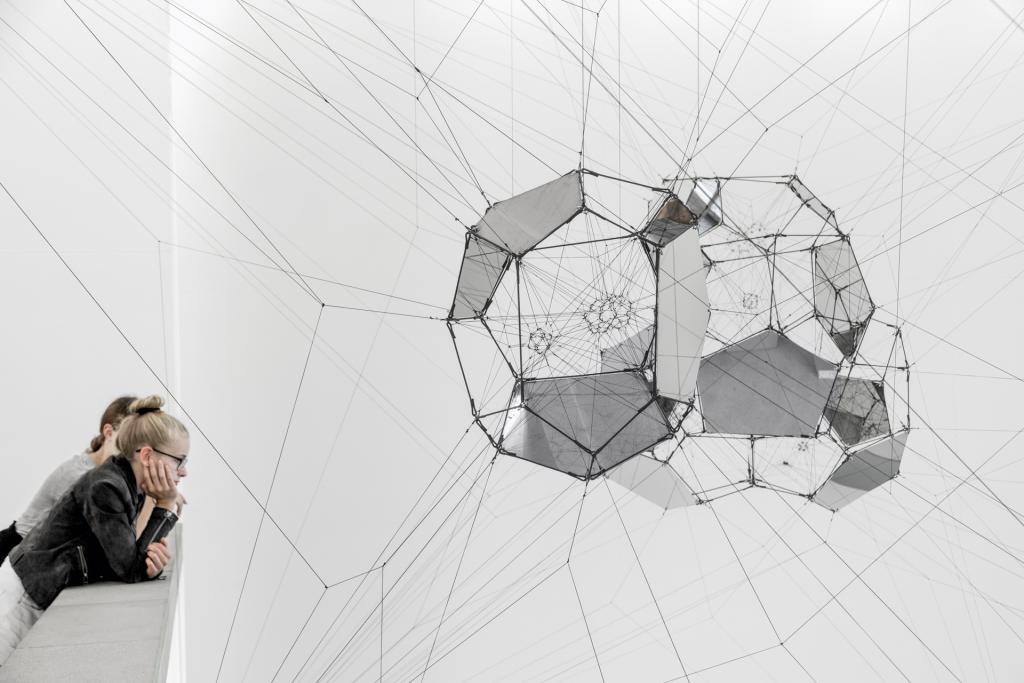
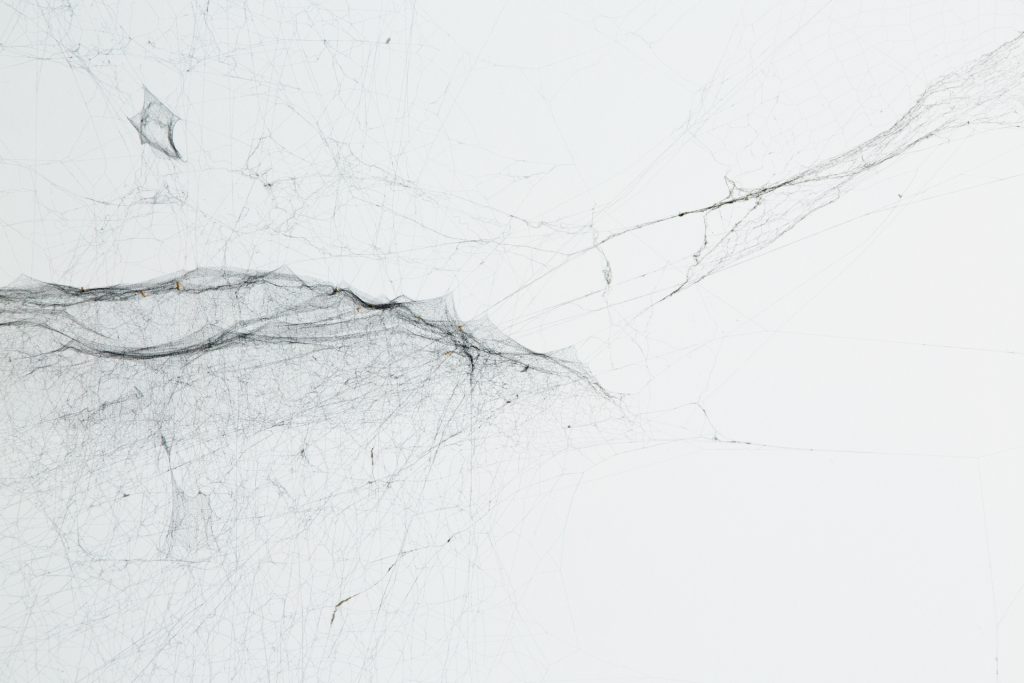
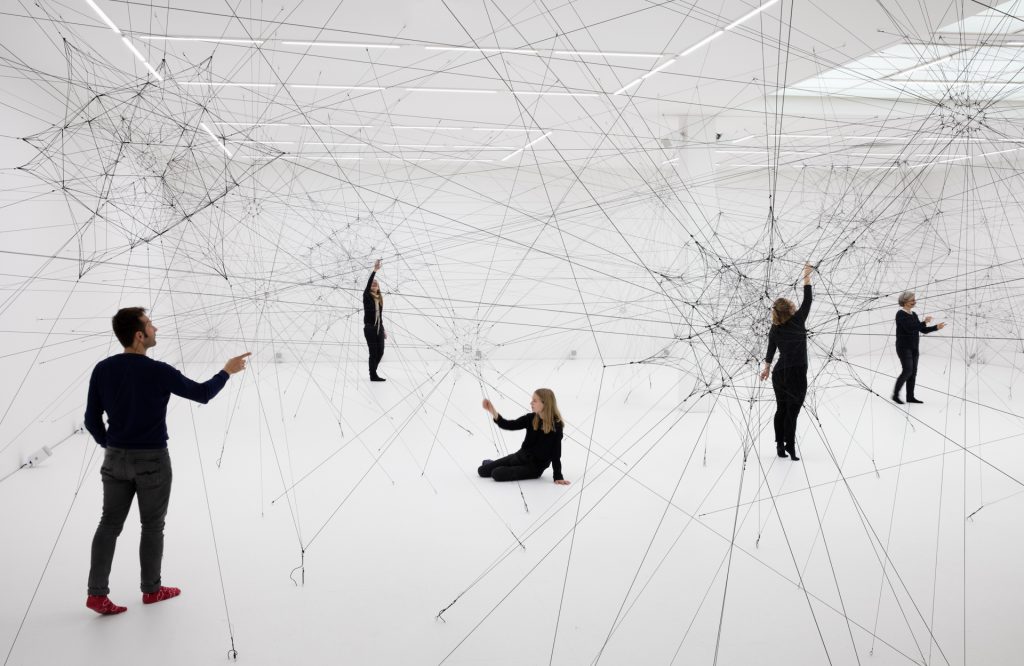
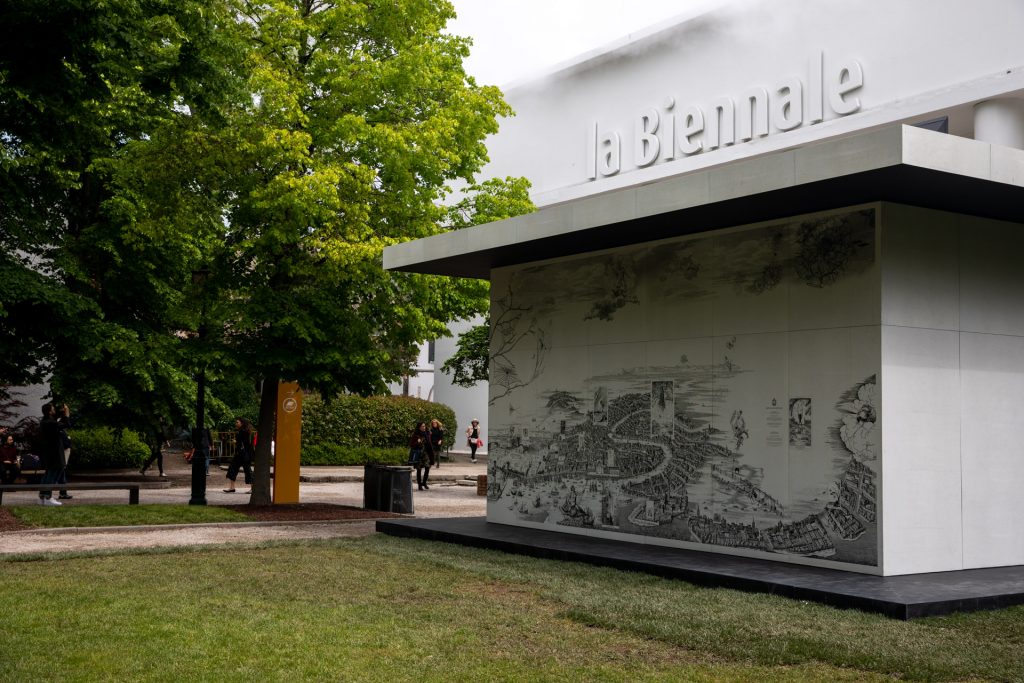
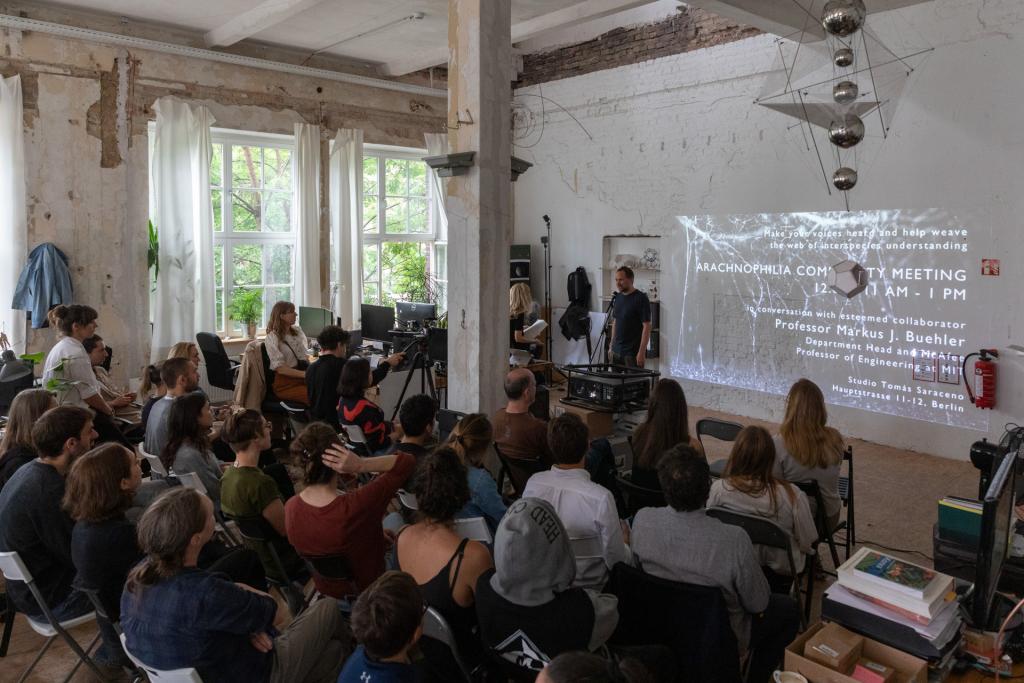
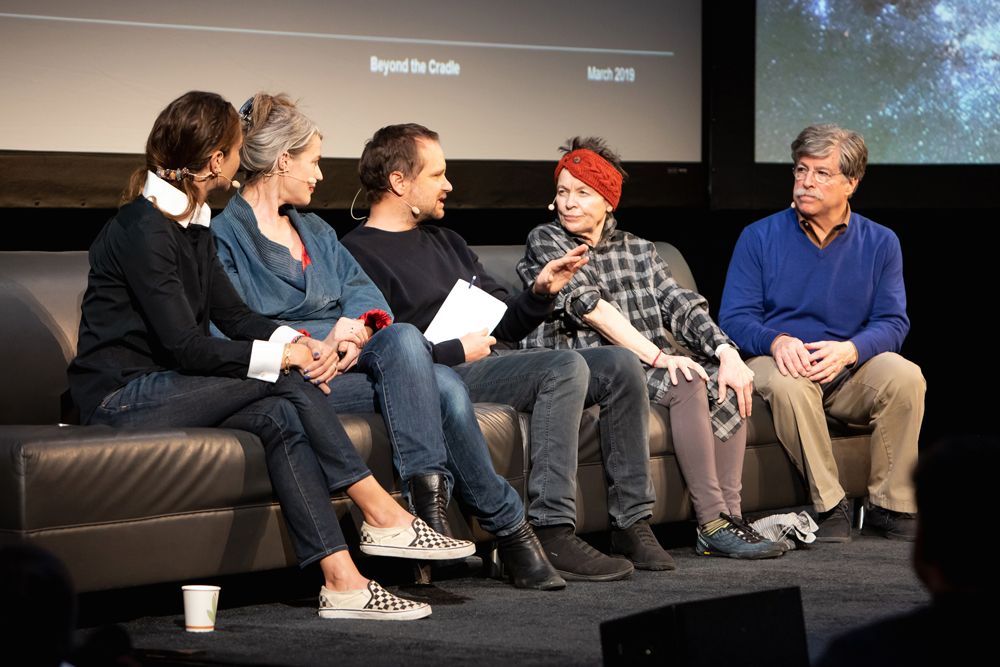
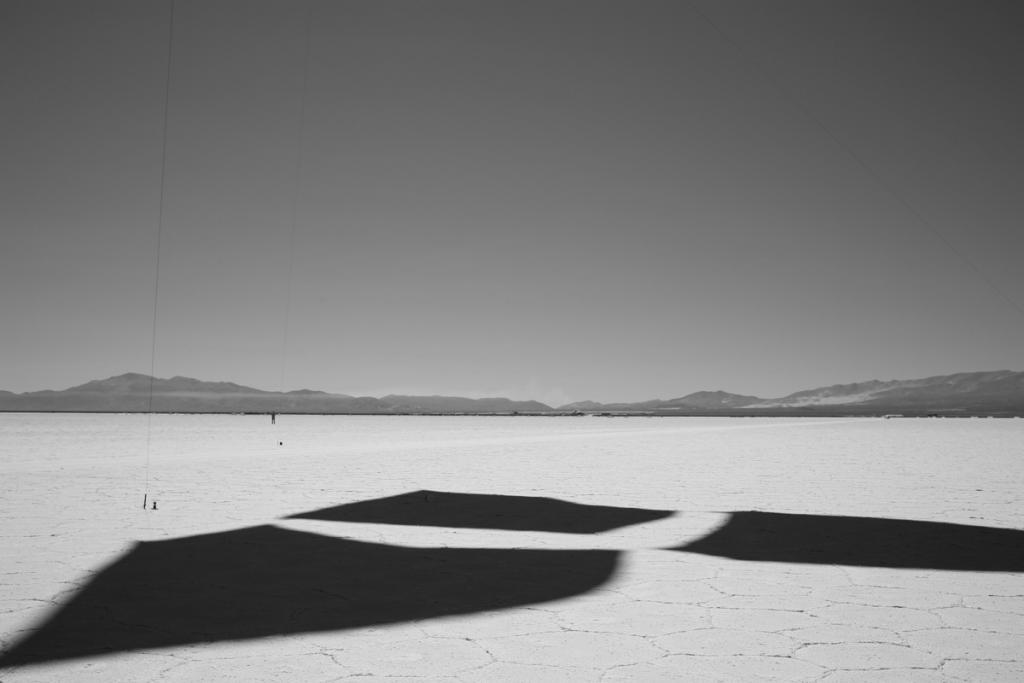
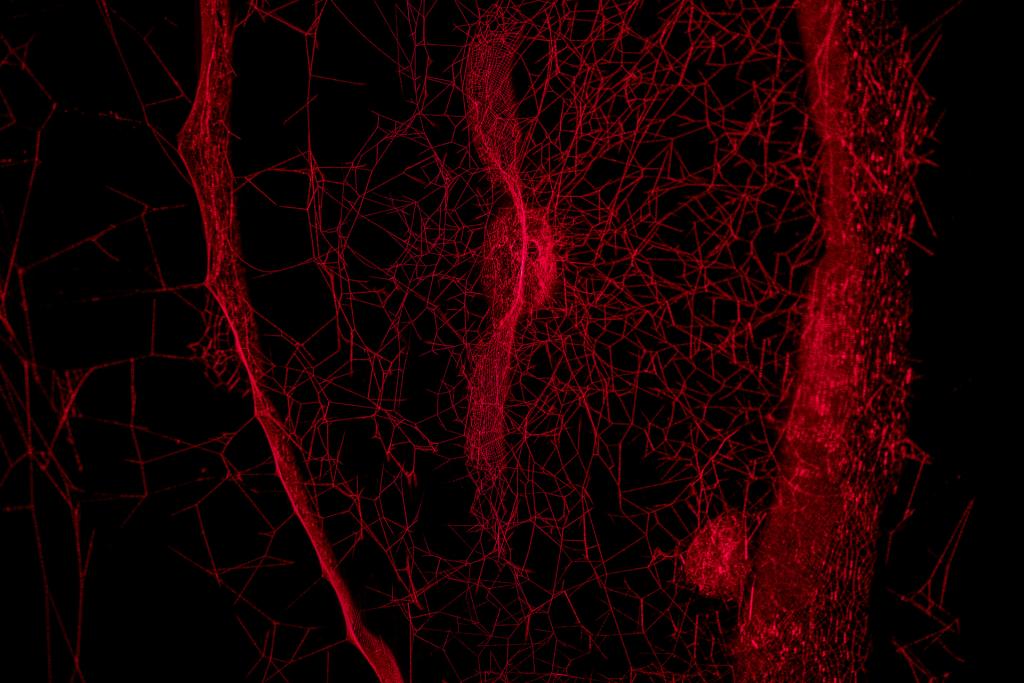
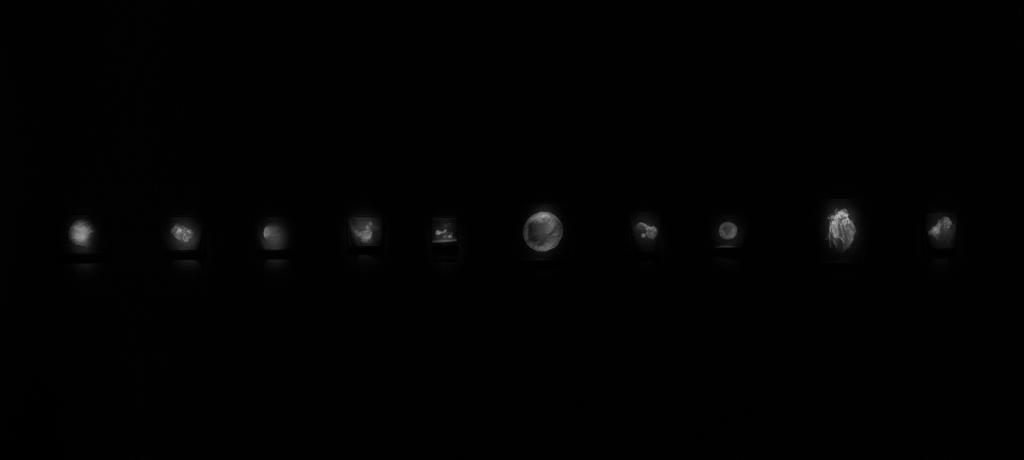

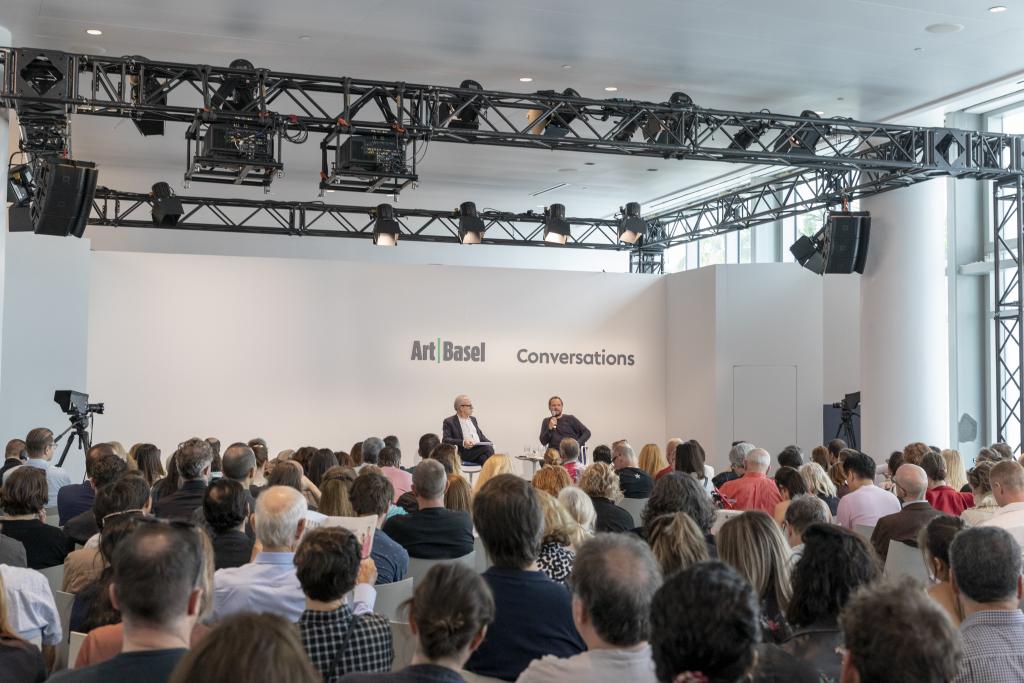
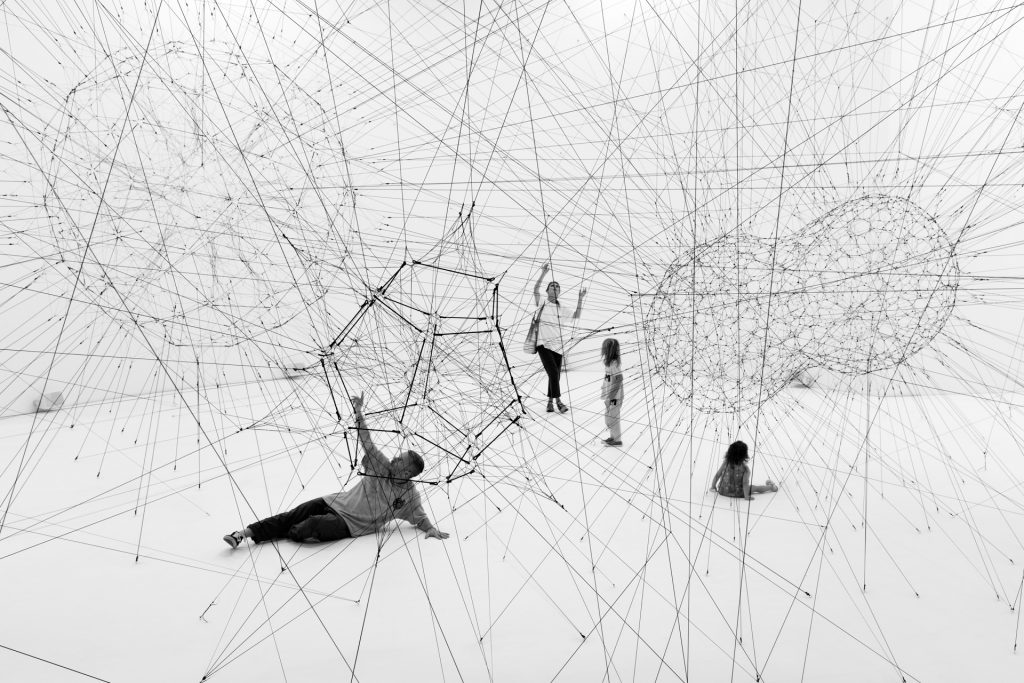
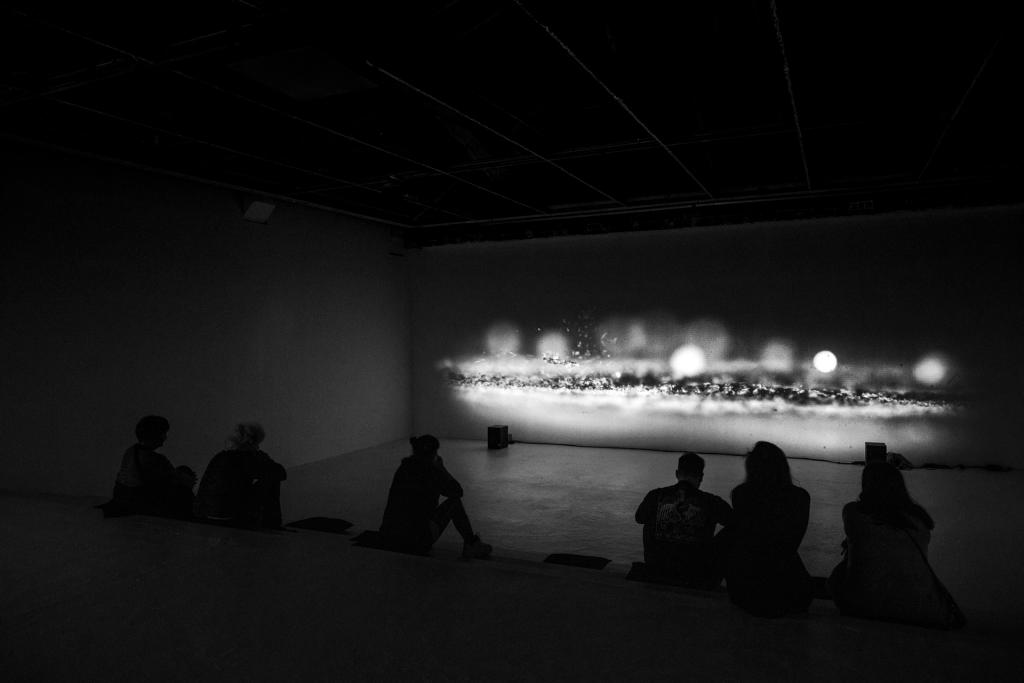
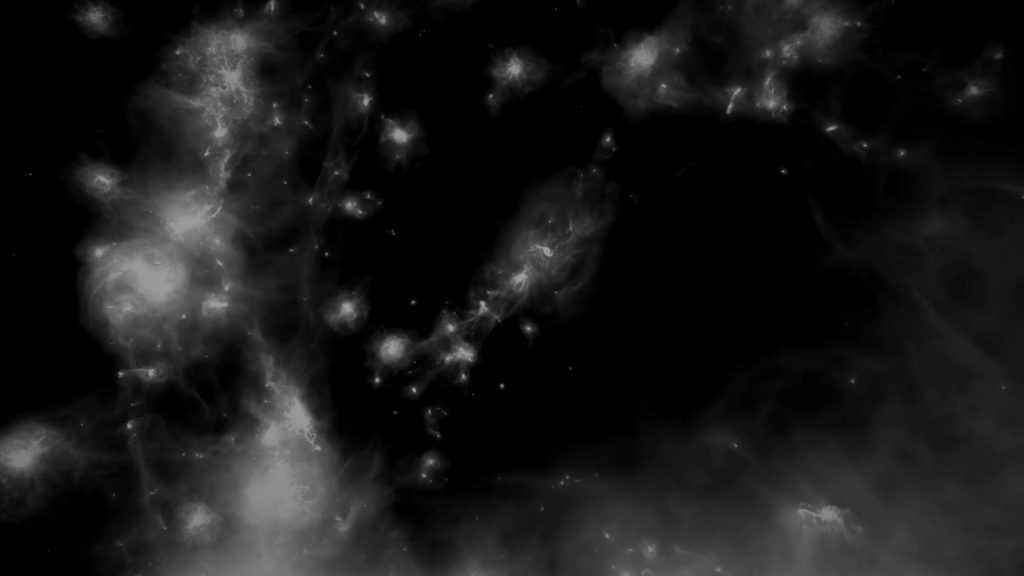
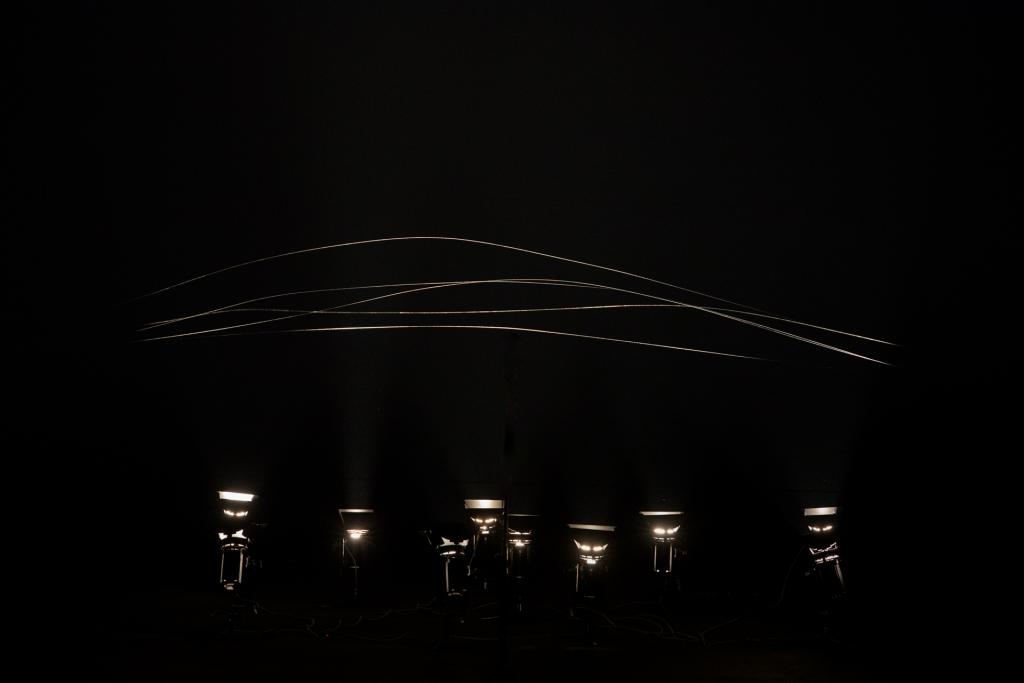
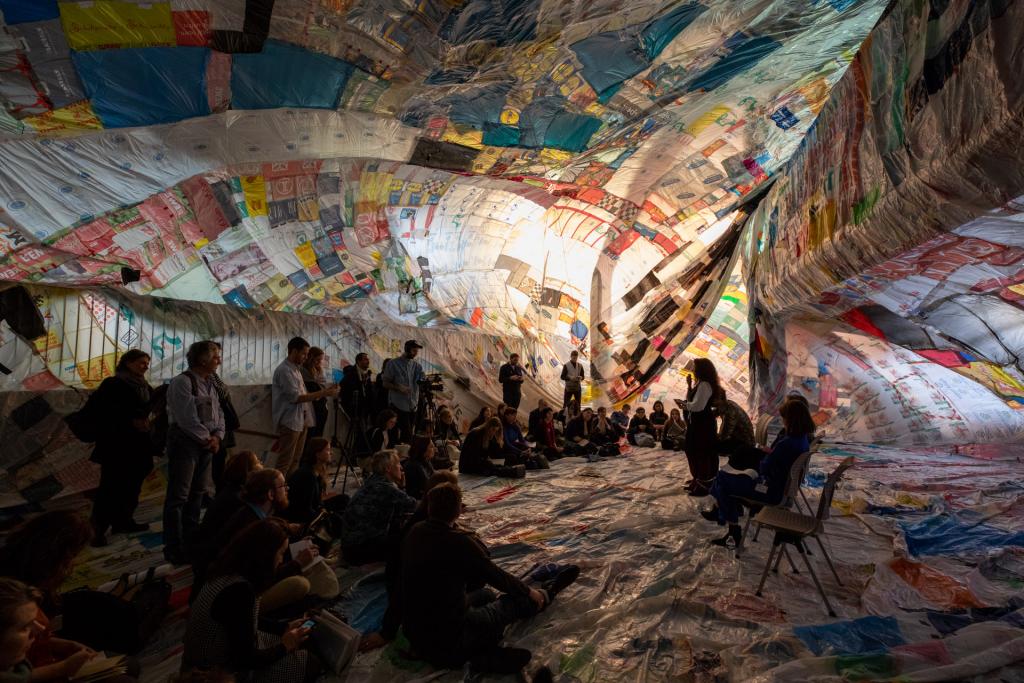
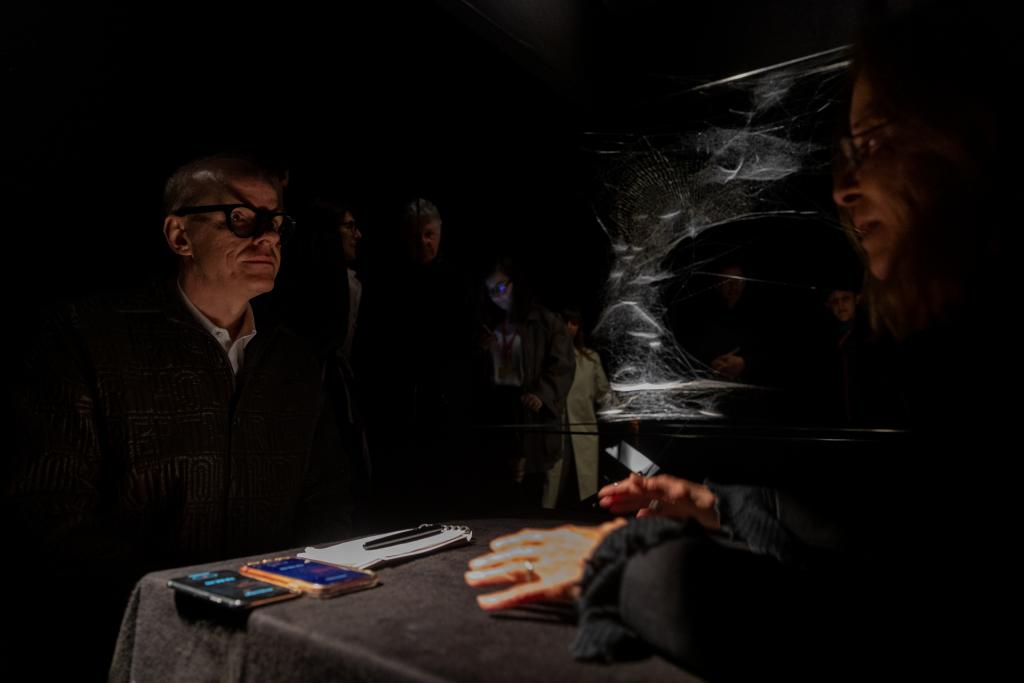
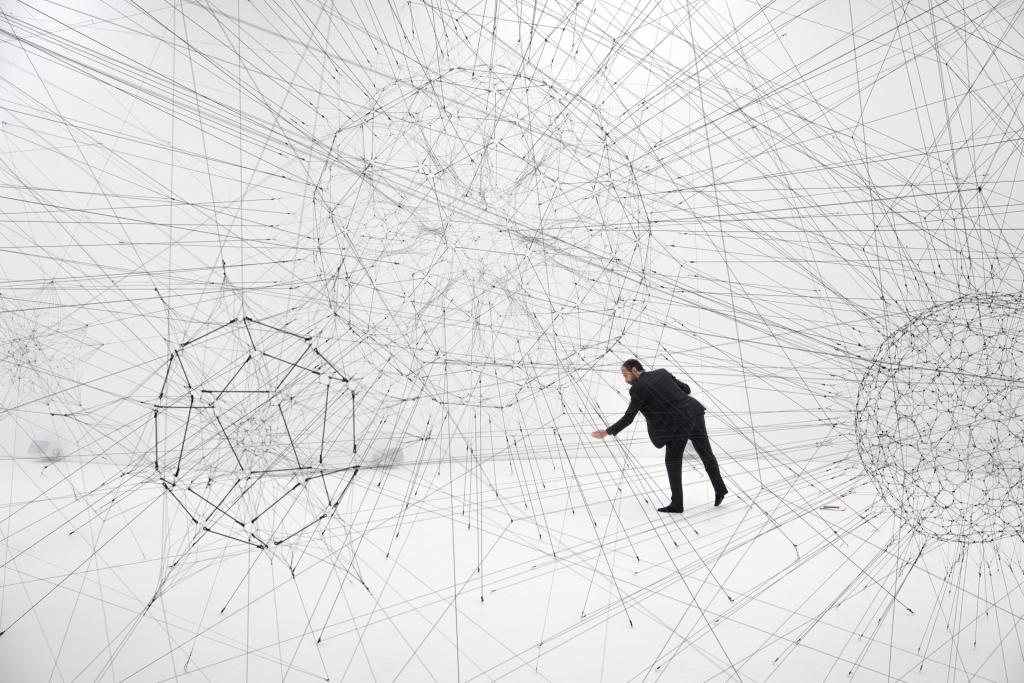
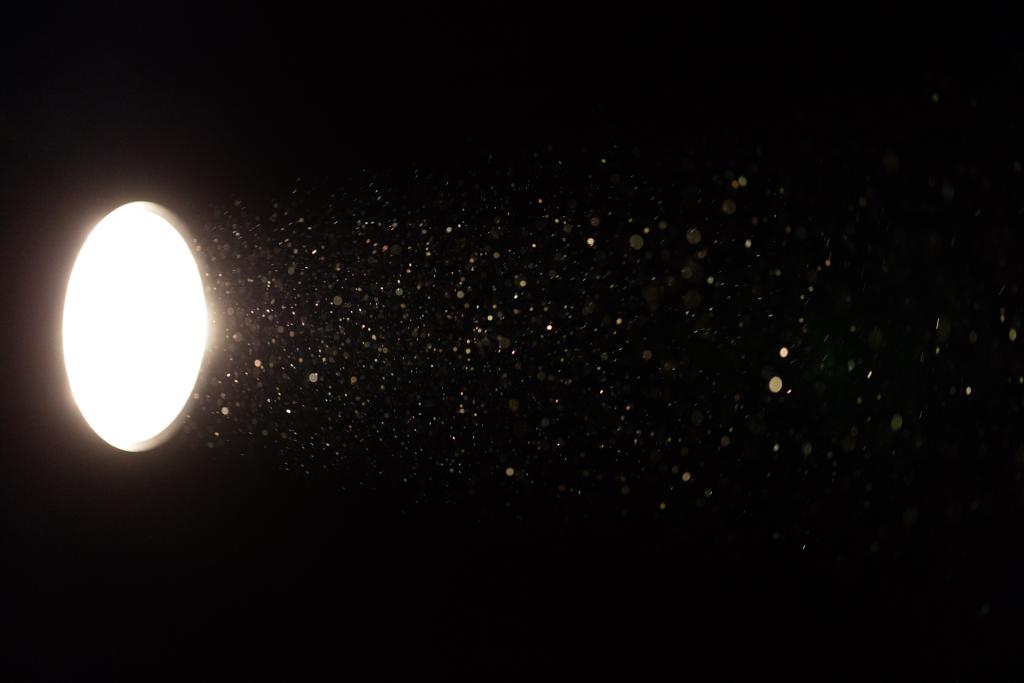
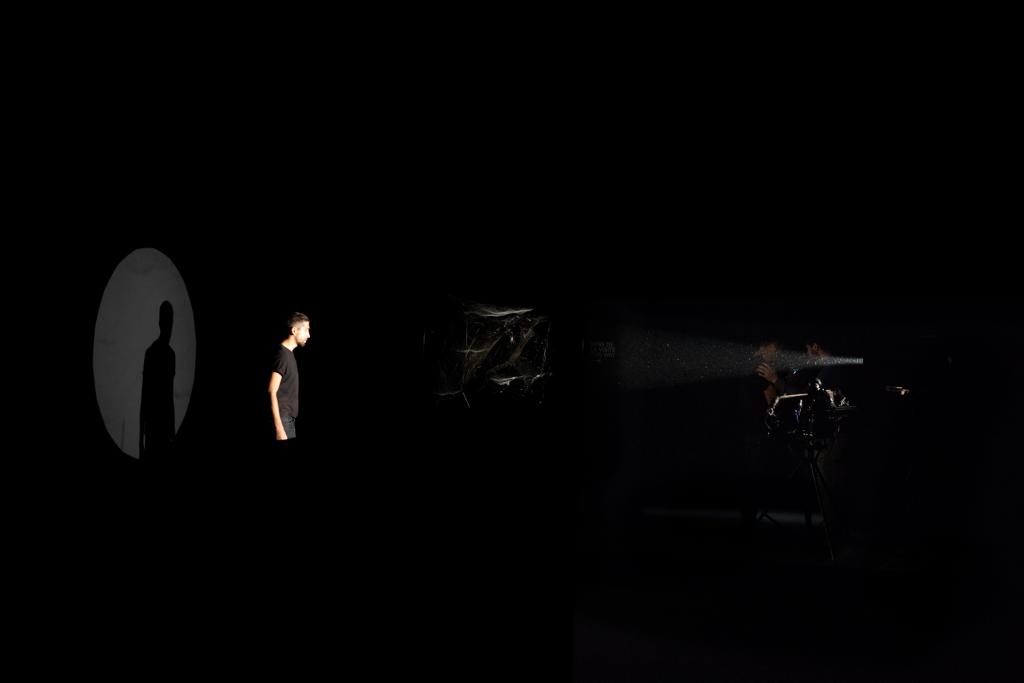
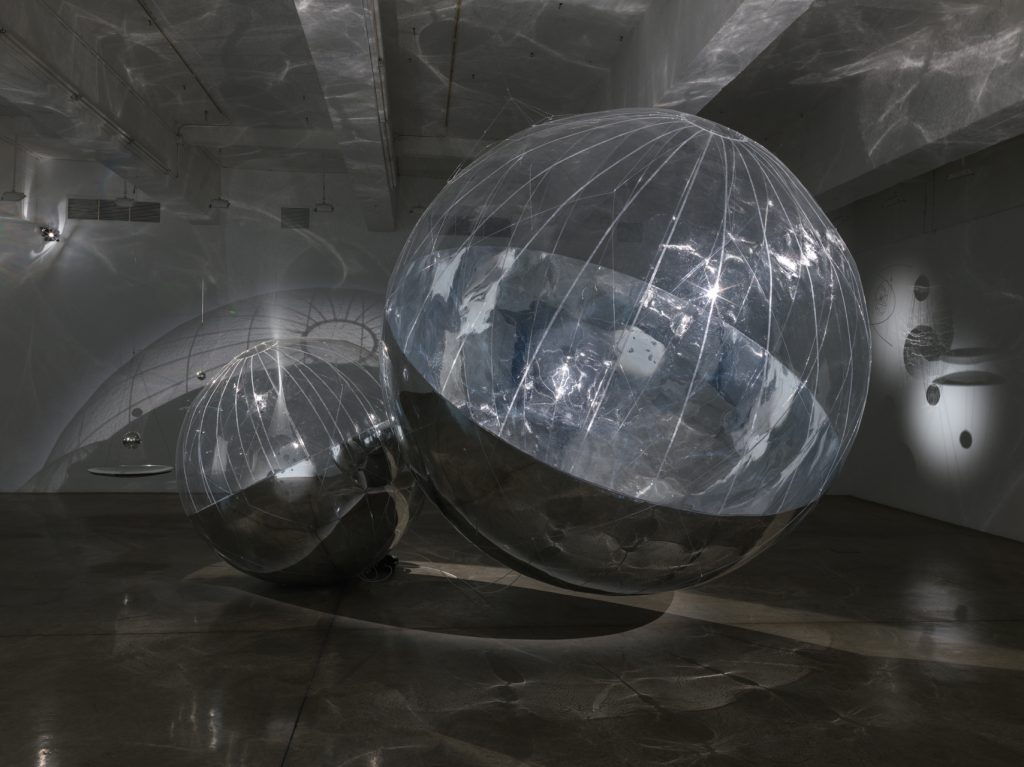
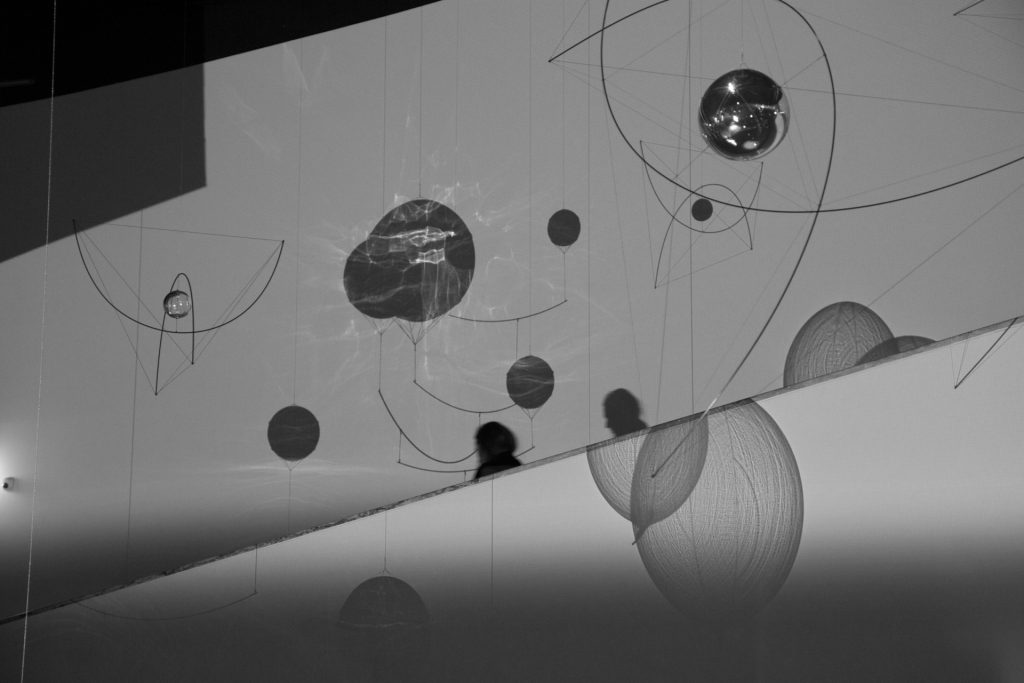
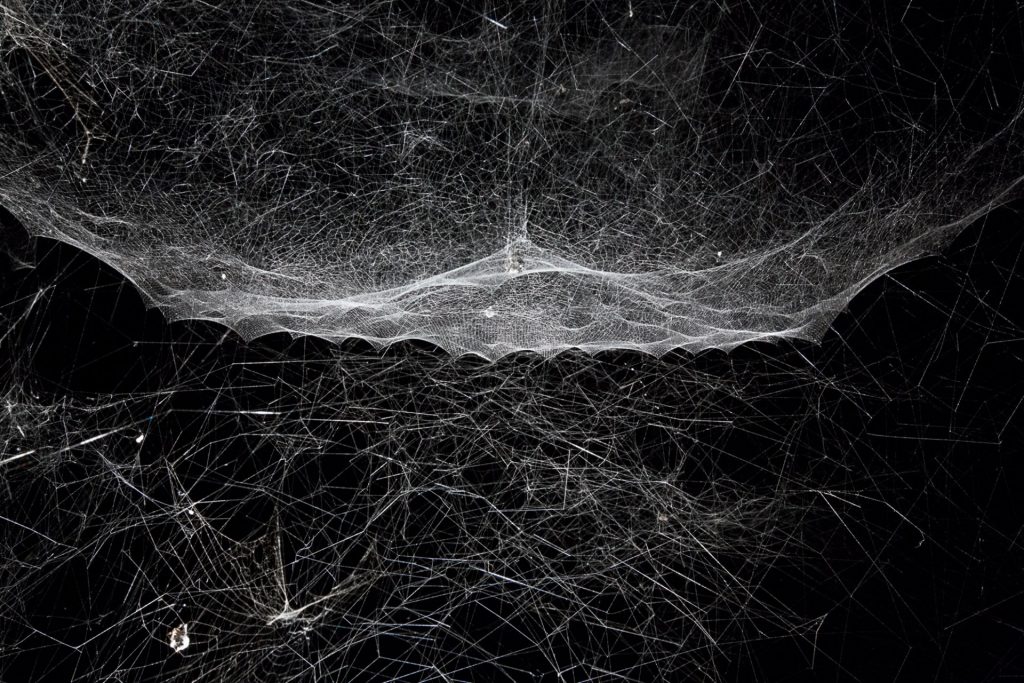
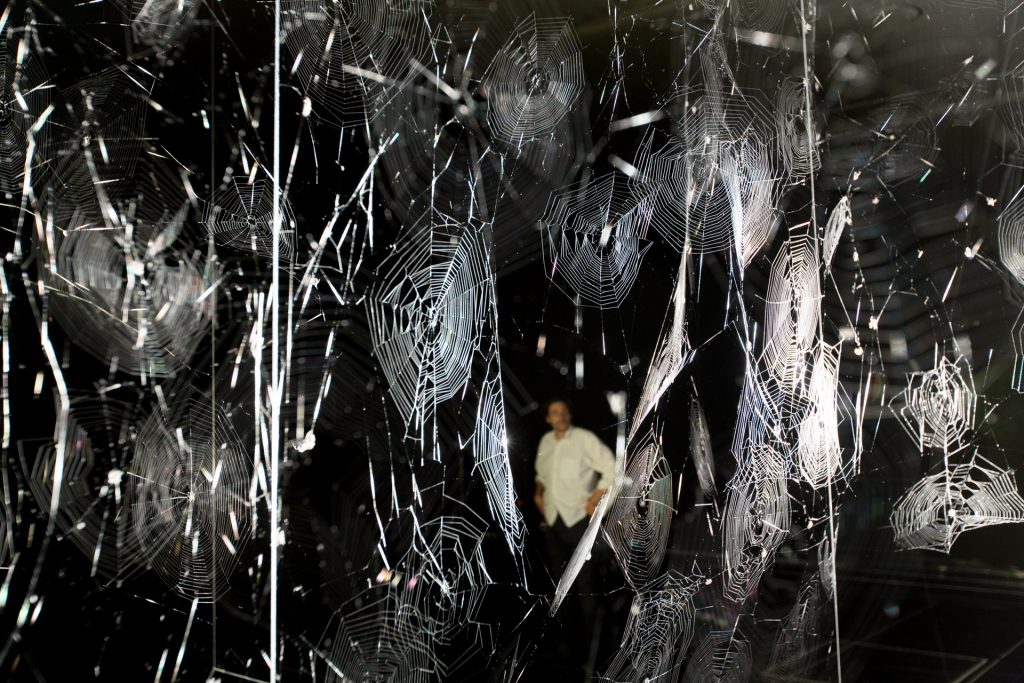
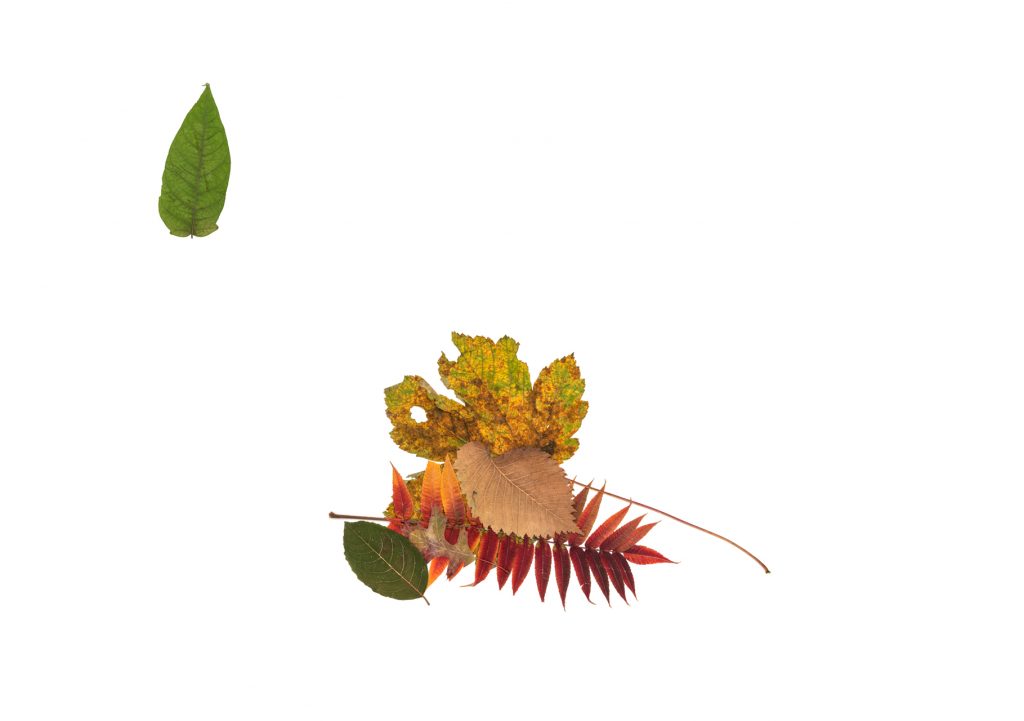
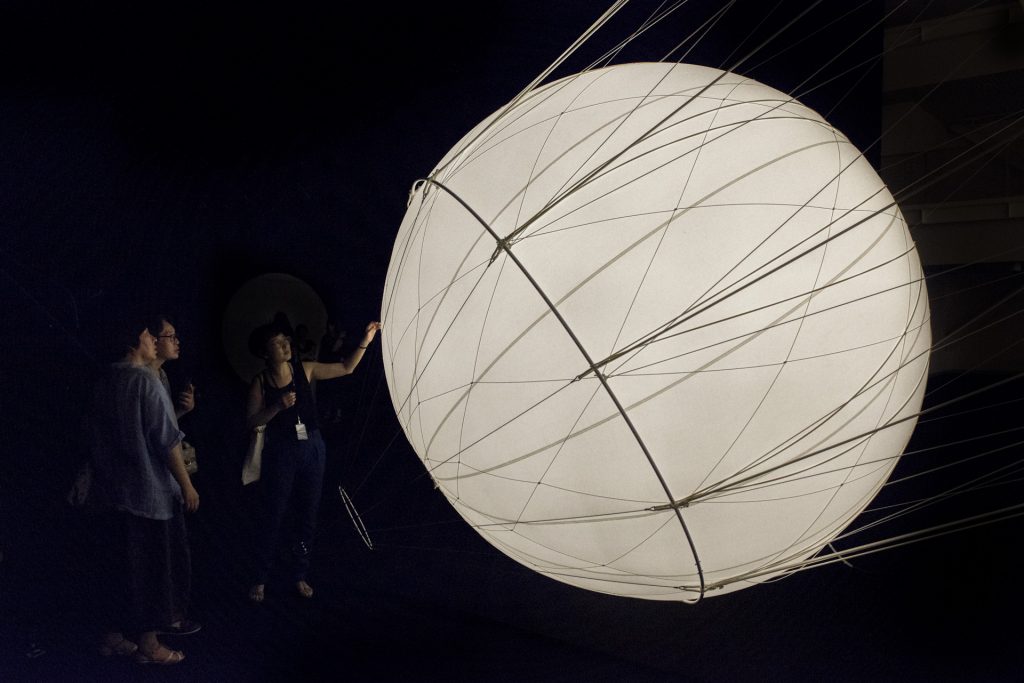
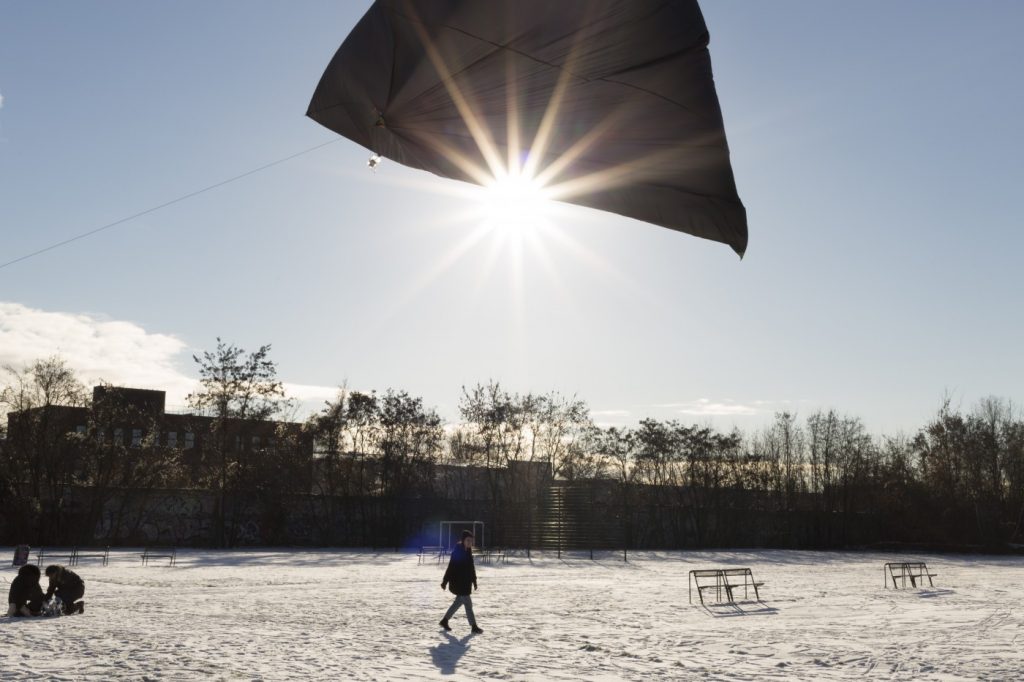
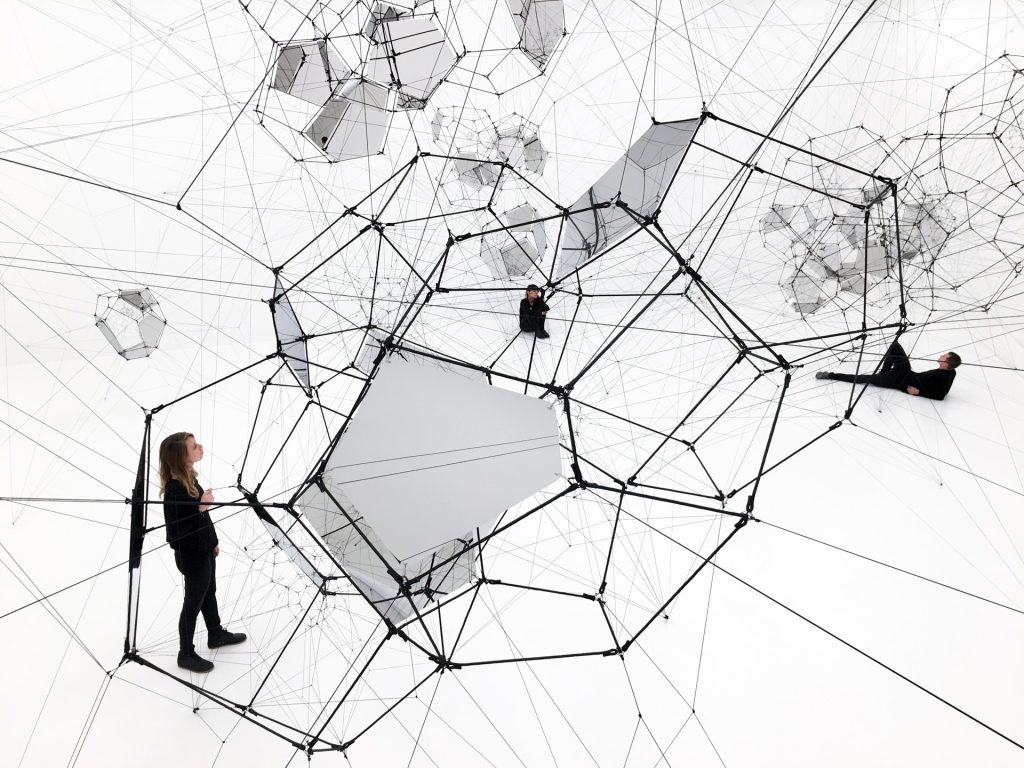
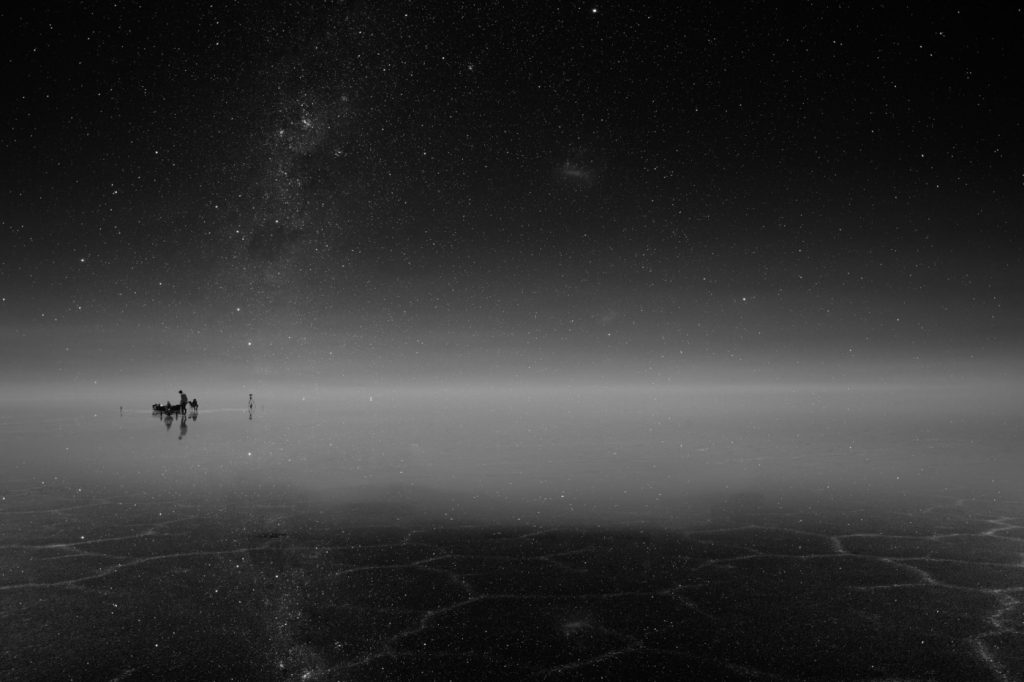
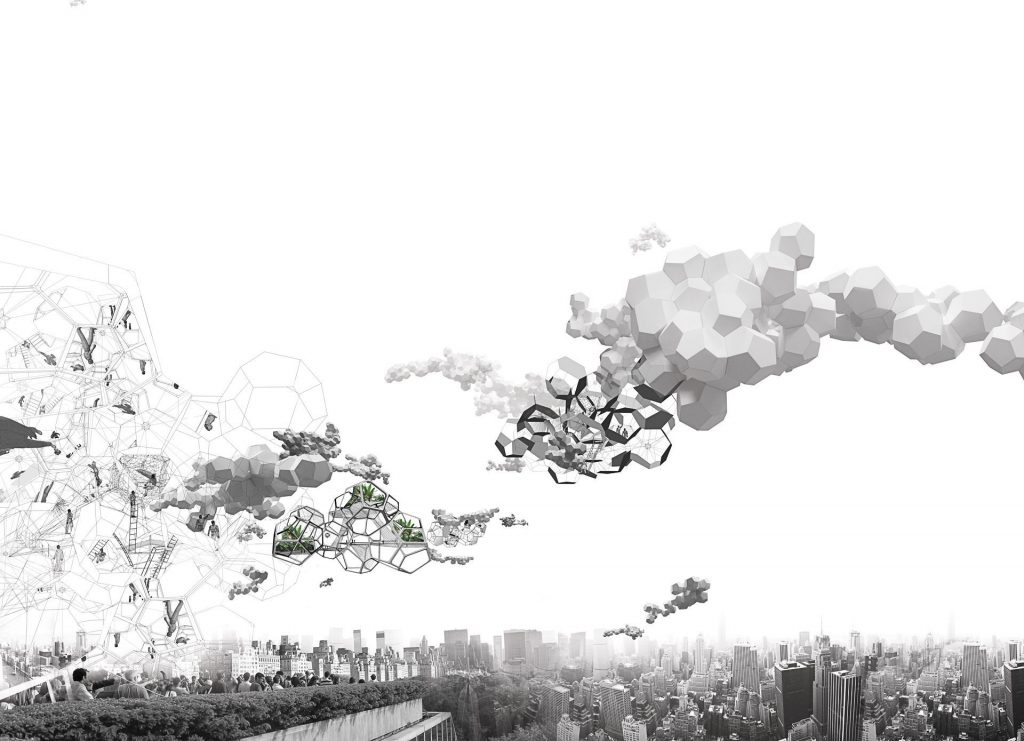
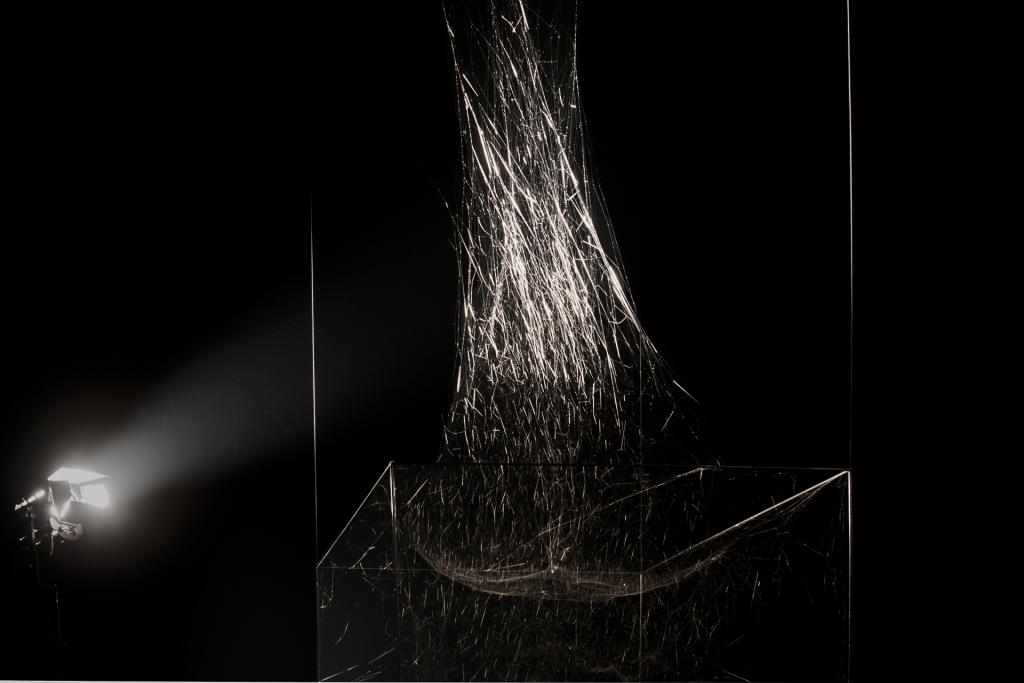
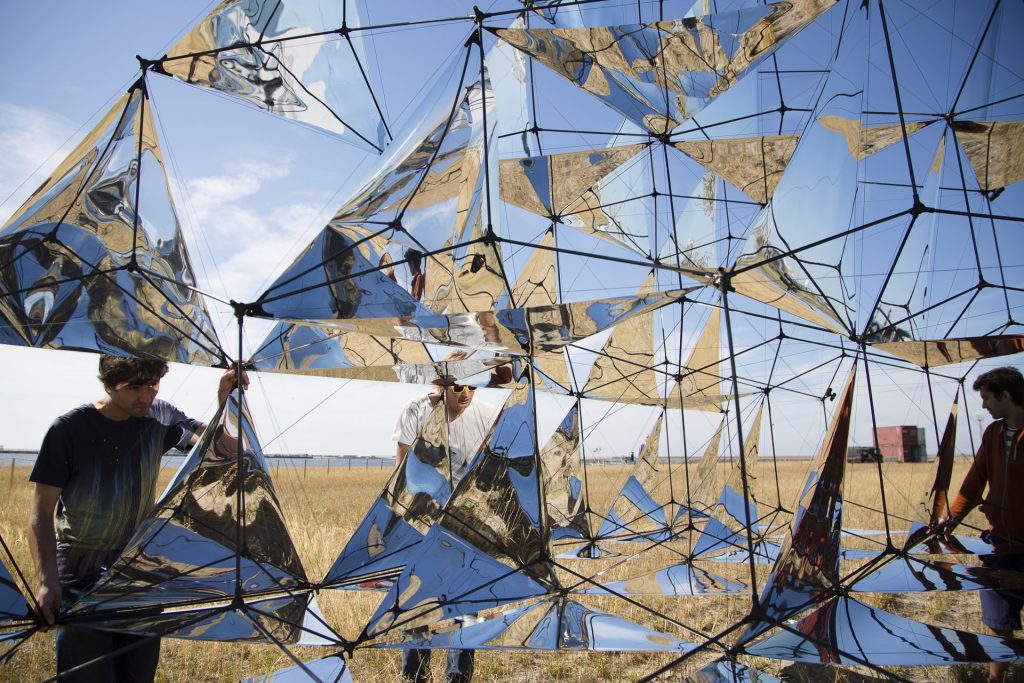
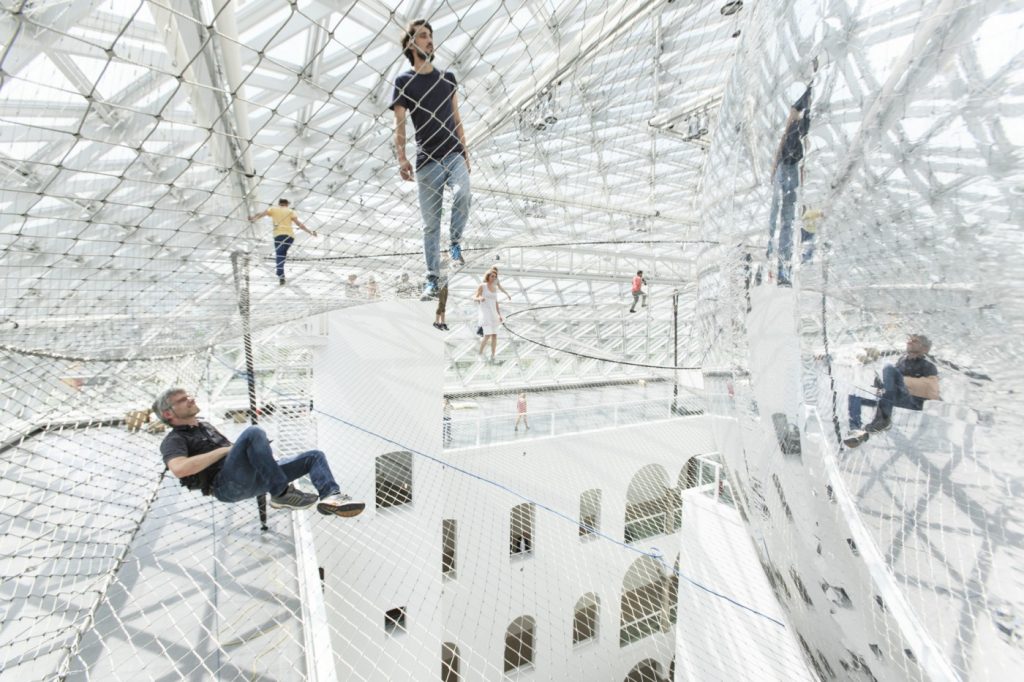
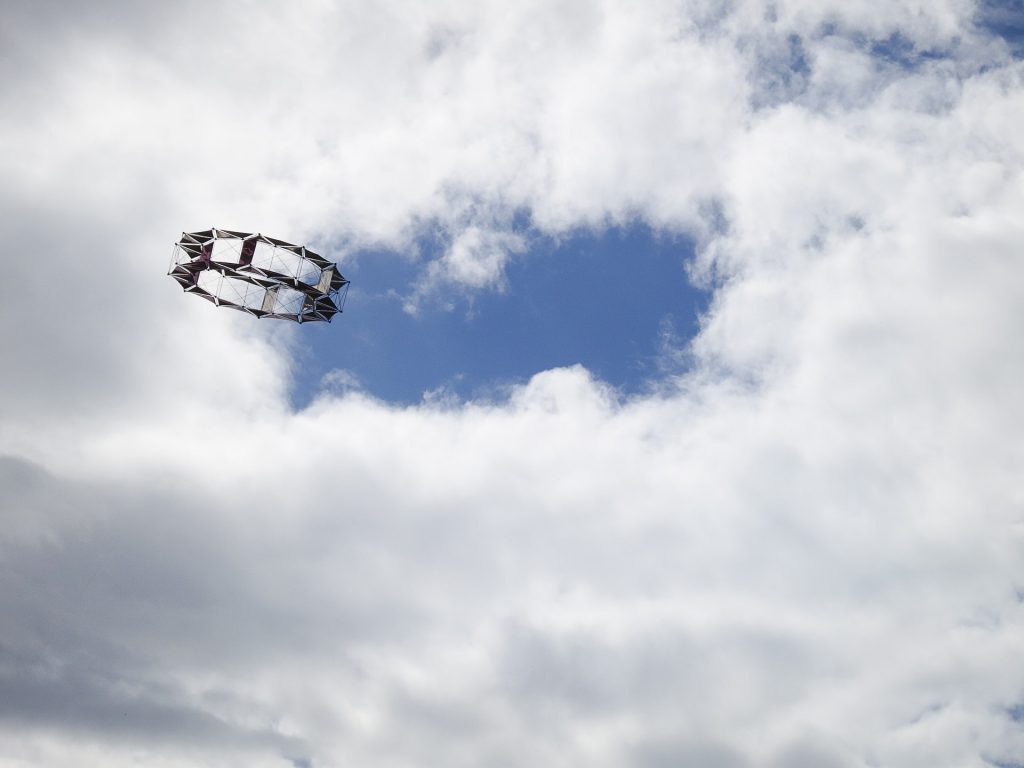
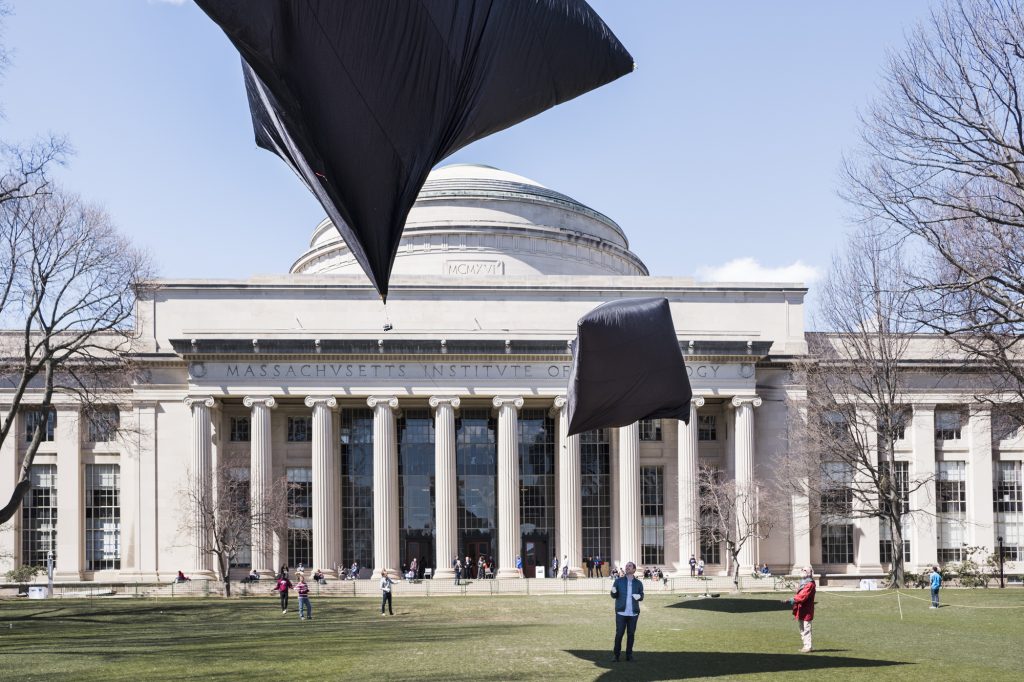
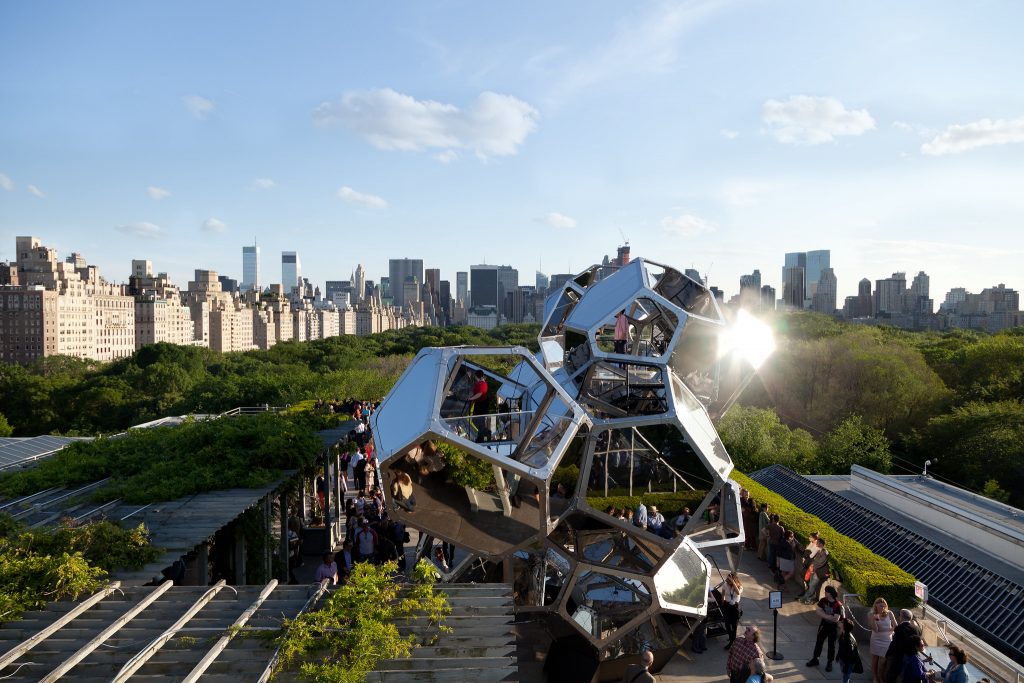
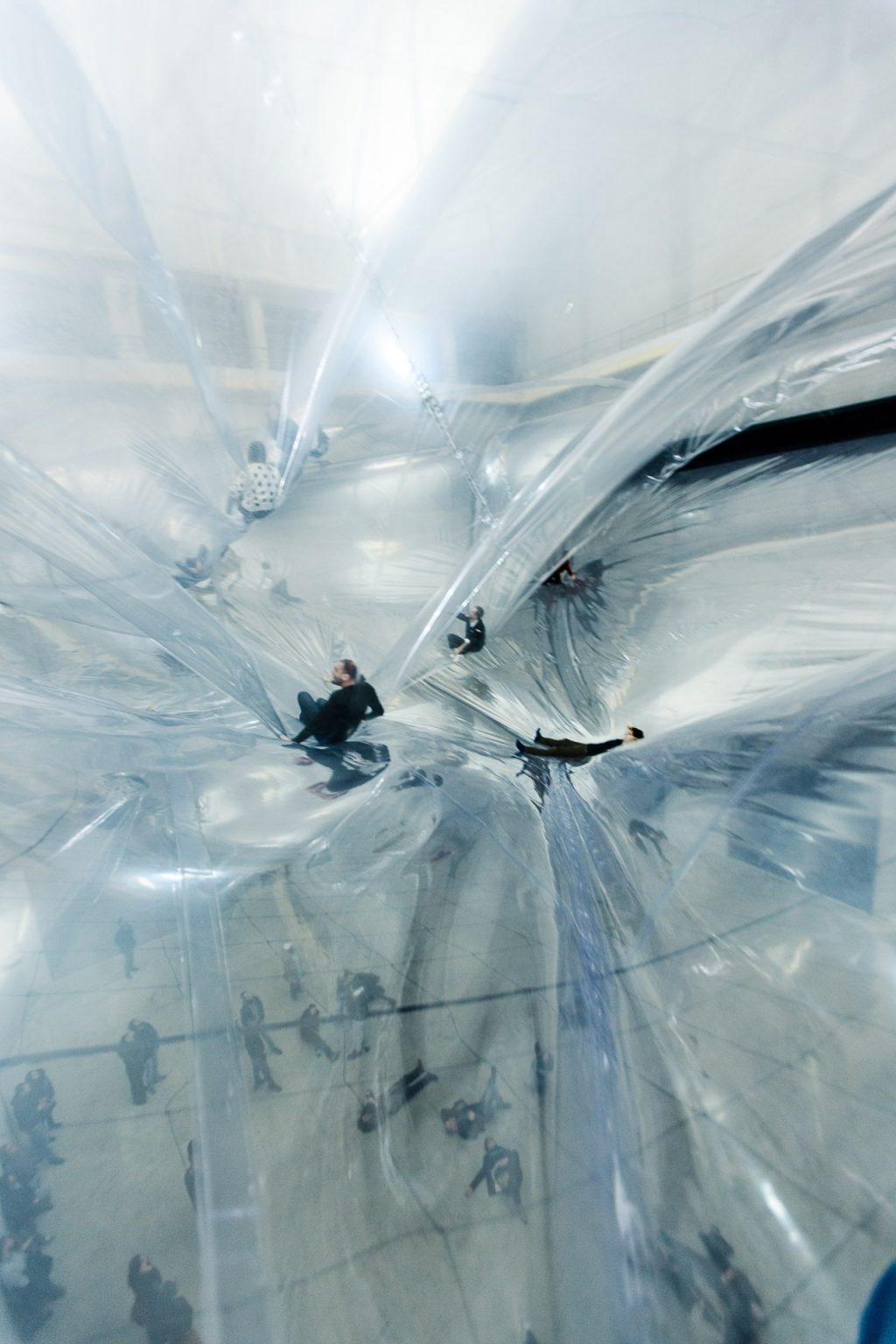
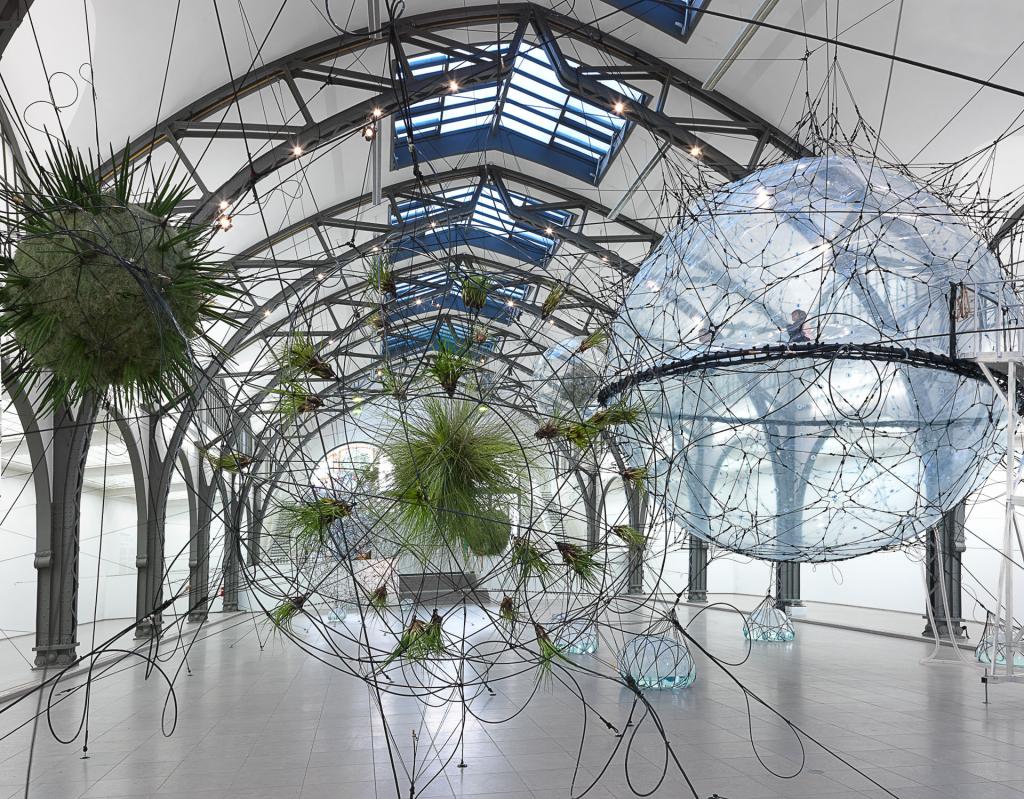
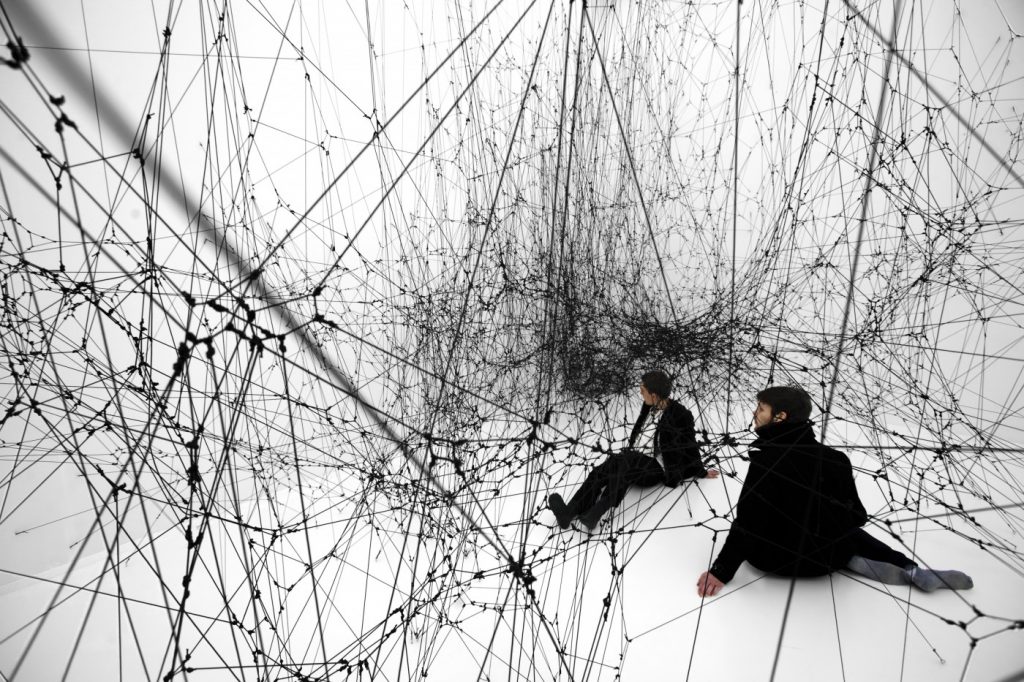
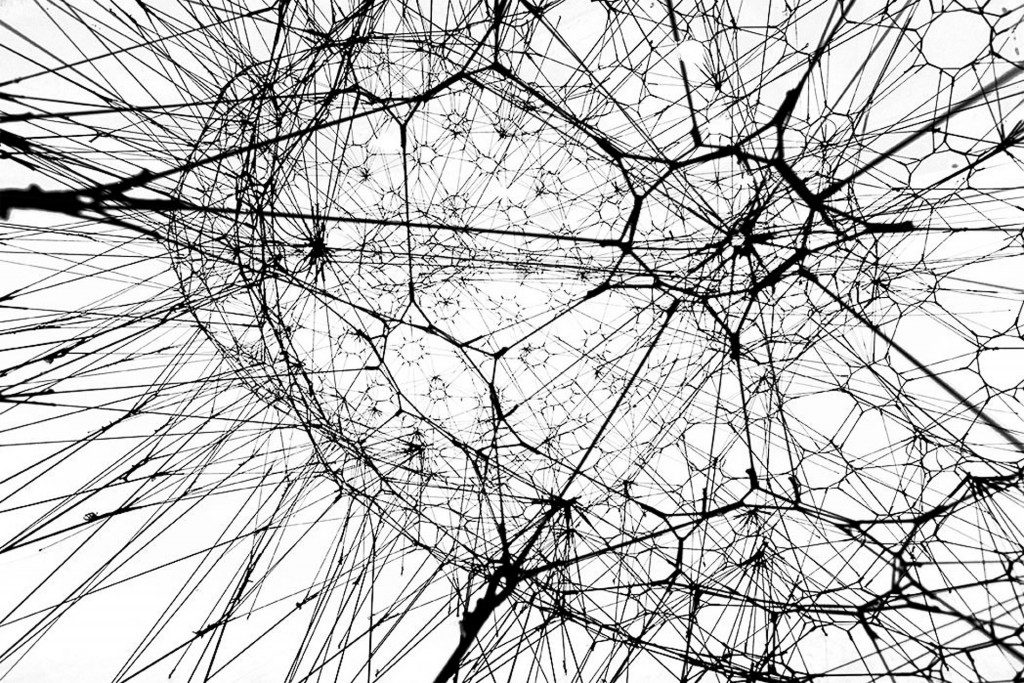
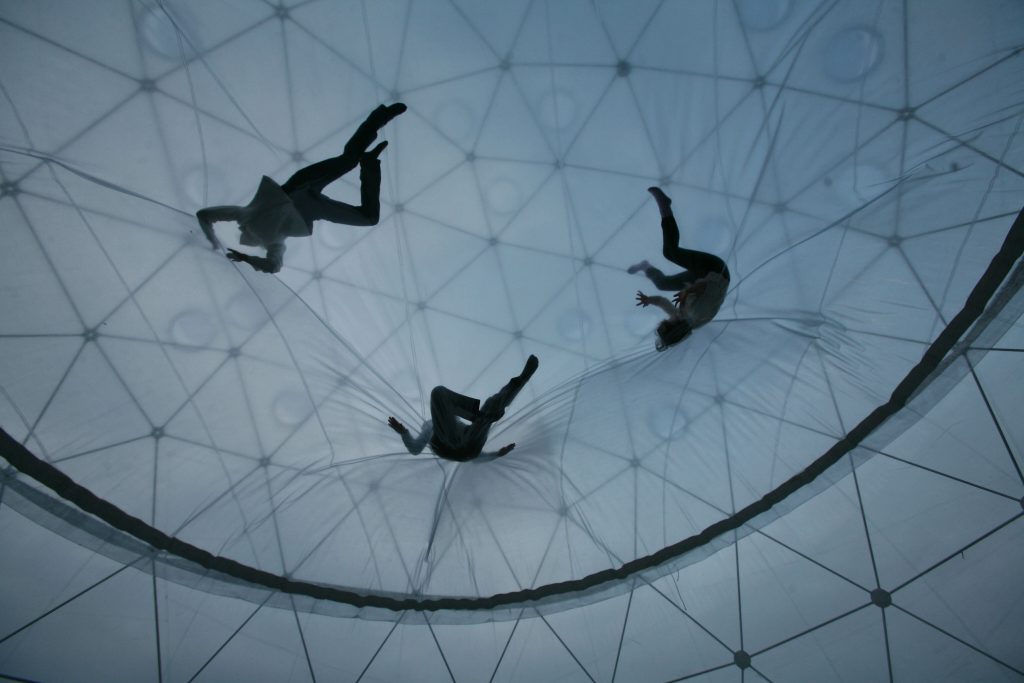
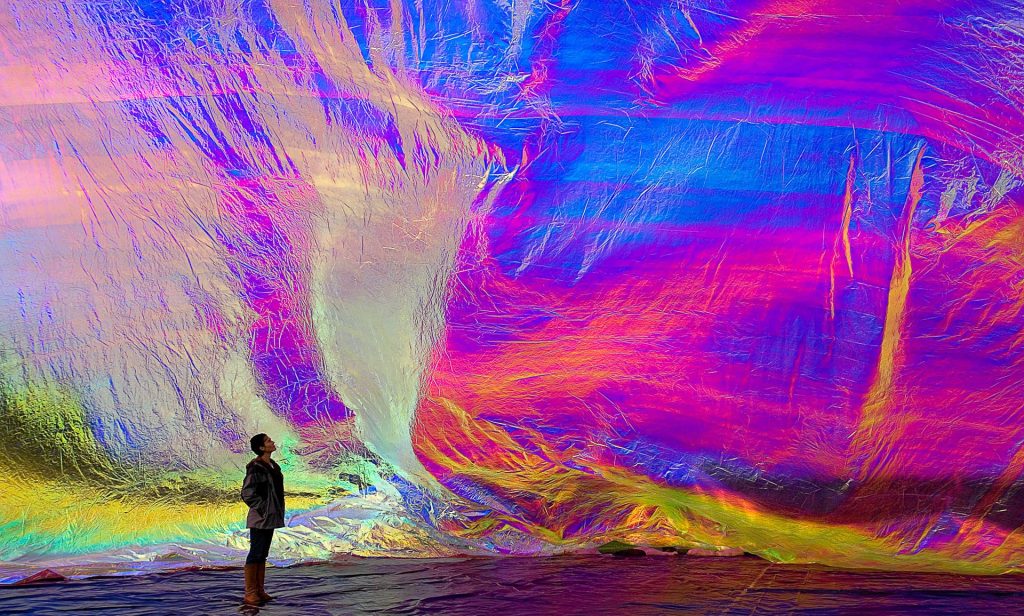
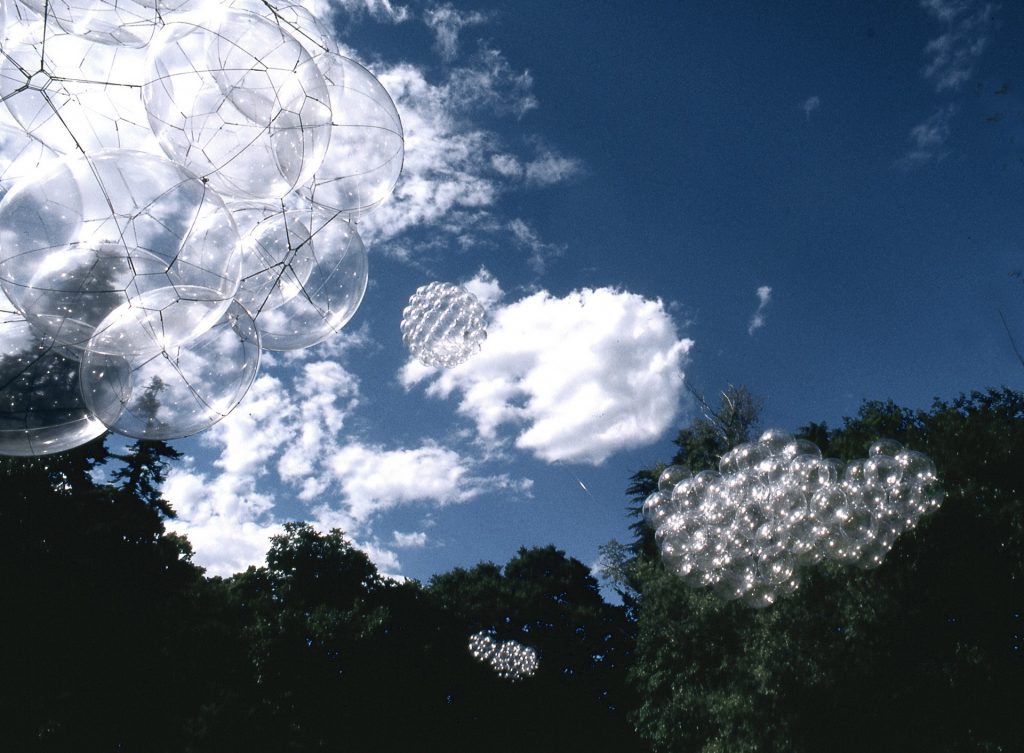
Tomás Saraceno in collaboration
The Royals Parks, Serpentine South, and online via websof.life
01.06 – 10.09.2023
This summer, the spiders that live in the basement of Serpentine will be free from the hum of the A/C. Their spider/webs, masterful artworks themselves, will vibrate differently in the quiet. At the front desk, humans can book a guided tour to enjoy their exhibition.
Above, we’ve turned the list of species in decline into our guest list. Swifts, sparrows, dogs, cats, phones squirrels, foxes, rays of sun, gusts of wind, friends and foes, flies, butterflies, bees, the raindrops on spiderwebs, the spiders who wove them, and many others are the creative collaborators of Web(s) of Life. Some have travelled thousands of kilometres, crossing borders visa-lessly above the Brexiteers; we wait for them impatiently. Specially designed sculpture-habitats have been installed on the roof and around the park to welcome them. We hope the magpies will be queuing to enter…One for sorrow , two for joy … Eight for a wish, Nine for a kiss, Ten for a bird you must not miss! Nearby, humans are offered a glimpse of their present-futures: spiders may be open for questions, whether you encounter them in the park or through the diviners in Somié, Cameroon.
Parts of this exhibition are free from mobile phones and lithium batteries. Under weather vanes and waning weather, the veins of lithium contained inside mobile phones are traced back to the salt flats and wetlands of Jujuy, Argentina, and those who fight to protect them. On site, a Ballad of Weather Dependency intervenes in the gallery building’s energy supply, making the Serpentine wholly reliant on solar power from panels installed on its roof. As the sun disappears behind a cloud, artworks may switch off. This performance is an invitation to human and other-than-human participants in London, online, and elsewhere to reconsider their habits and relations. What behaviours need to change to maintain a stable climate for all inhabitants of these worlds? Power always comes at a cost; better not run on credit.
Independence from the effects of climate change is expensive, and therefore unequally distributed. Even the so-called ‘green transition’ to renewable energy is premised on the development of new technology, which only exacerbates this tendency further. Weather independence in one place produces climate catastrophe in another. For dependency to be shared, this transition must be understood, not only in terms of technology, but also as a highly political matter of social relations. Staging a syncretic encounter across videos, sculptural installations and performative interventions, the exhibition brings attention to the neocolonial structures of extractivism and its ecosocial consequences, as well as to the systems of belief and knowledge that can work against the profiteers of the Capitalocene towards just cohabitation within the Web(s) of Life.
Opening hours (Humans)
Serpentine South: 10:00 – 18:00 (weather and energy supply permitting)
The Royal Parks: 05.00 – 00.00
Wider World Web: 24/7 (pedal permitting)
The Air Condition has been switched off. Since we do not all breathe the same air, let’s condition habits instead. All energy for the exhibition is generated by solar panel sculptures installed on the roof. This means opening hours and exhibition modes will alter: in Cloudy Mode, some artworks and spaces will hibernate, and during heat waves only the West Gallery and outside will remain open. Spiders in motion, rainy commotion: ask your fellows to find out about the opening hours or consult the book of proverbs. Reject false solutions and new forms of energy colonialism advancing in the name of a green transition. We don’t need a night sun to keep the exhibition going, we can produce enough social energy to change the power systems.
Whose opening hours? (Other-than-humans)
Serpentine South and the Royal Parks: 24 hours/day, 7 days/week (weather, size and revolt permitting)
The animal kingdom is revolting against the King! Queen bee hotel sculptures go into total anarchy, when foxes jump the fence outside the opening hours, and flies break the (spider ) web servers of multinational corporations. This is a royal park no more! Inhabitants of the park and those who travel by air, or are small enough to enter through fences and cracks – birds, flies, mosquitoes, and other beings – this exhibition is already yours. If you are a spider/web in the basement, humans might consult your ancient wisdom. During human opening hours, dogs are welcome in the West Gallery where a special artwork has been prepared for them. Meanwhile migratory birds arrive from the south with a check in their mouth: the Global North has an outstanding bill for colonialism and natural extraction. It’s a topsy-turvy world and the compass has gone haywire this previously royal, now wild, wild park!
Ballad of Weather Dependency
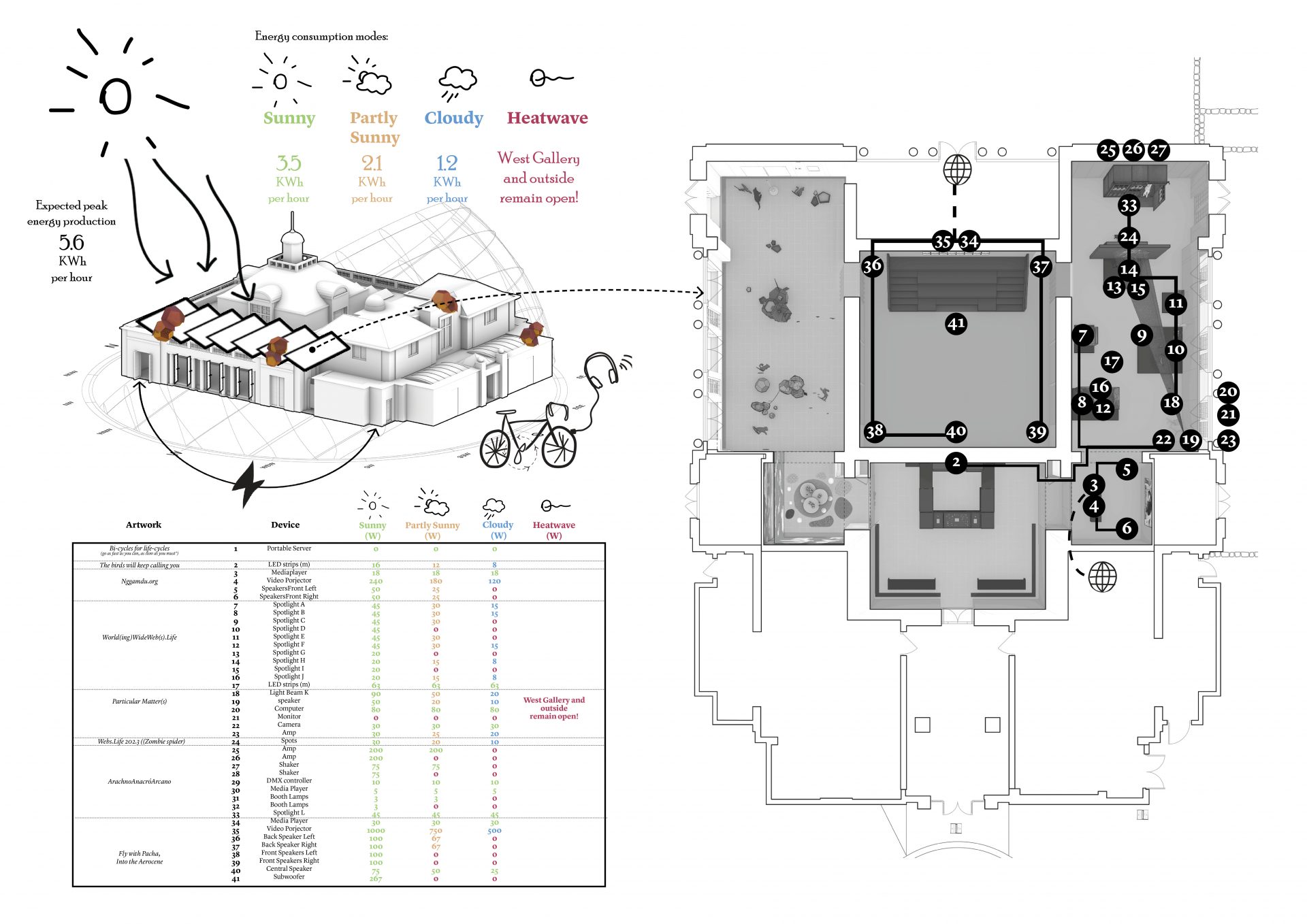
Ballad of Weather Dependency is an intergenerational, cross-cultural, multispecies performance that urges visitors to adapt, change, and modify their activities according to the rhythms of the planet, as many other human cultures, animals and plants already do. The performative work signals a behavioural shift in the way exhibitions are produced and consumed, where visitors become direct interlocutors of energy through their active and responsive participation across its production and consumption.
Web(s) of Life is wholly reliant on solar power from newly installed 27m2 sculpture panels on the Serpentine’s roof. At its peak it produces 5.6 kWh, supplying 8 artworks with a required total of 3.5 kWh, feeding the surplus 1.9 kWh into the national grid. Web(s) of Life is an exhibition that generates more energy than it consumes! Depending on the weather, the exhibition functions in different modes—Sunny (3.5 kWh), Partly Sunny (2.1 kWh), and Cloudy (1.2 kWh)—in which certain installations will switch off, or run at lower frequency to adapt to the available power supply. In Heat Wave Mode, the indoor galleries will be partially closed to humans, who are invited to join other participants, such as birds, spiders, bees, and squirrels in enjoying the multispecies sculptures spilling out of the west wing of the gallery and into the park.
The ability of participants to swing with these rhythms is part of the performance! As such, they are not limitations or inconveniences, but conditions that gesture to our inescapable and necessary connectedness with other beings and places. No energy is clean, but by generating power for the exhibition on site, its various costs—monetary, social, and ecological—become more immediate. We may have gone solar, still we don’t need a night sun to keep the exhibition going, but can produce enough social energy to change power systems. Technology should be world-changing, not world-ending: join us in weather dependency!
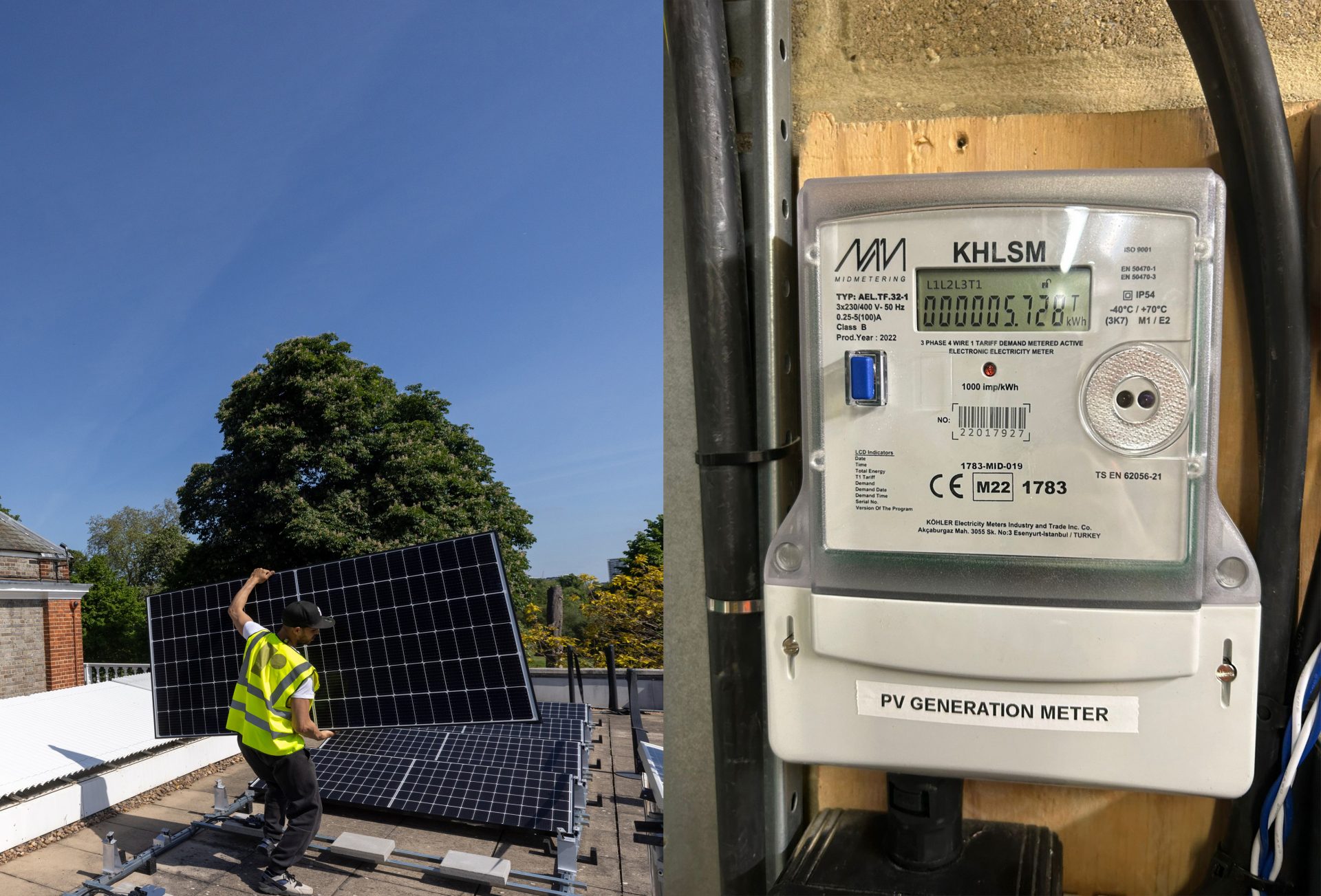
Ballad of Weather Dependency, 2023. Installation view at Tomás Saraceno In Collaboration: Web(s) of Life, Serpentine, London, 2023. Photography by Studio Tomás Saraceno.
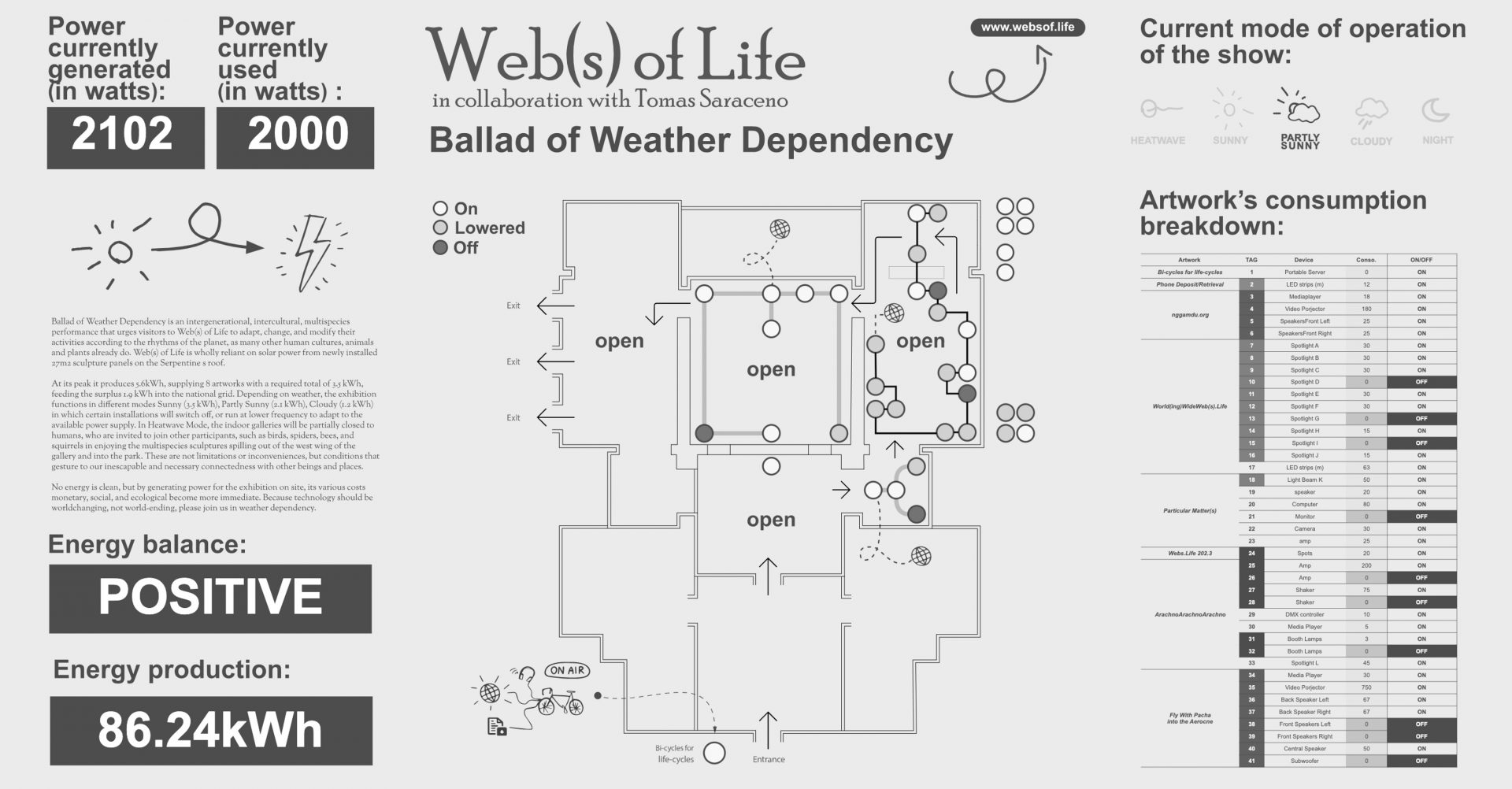
Ballad of Weather Dependency, 2023. Screenshot for Tomás Saraceno In Collaboration: Web(s) of Life, Serpentine, London, 2023.
Bi-cycles for life-cycles
(Go as fast as you can as slow as you must*)
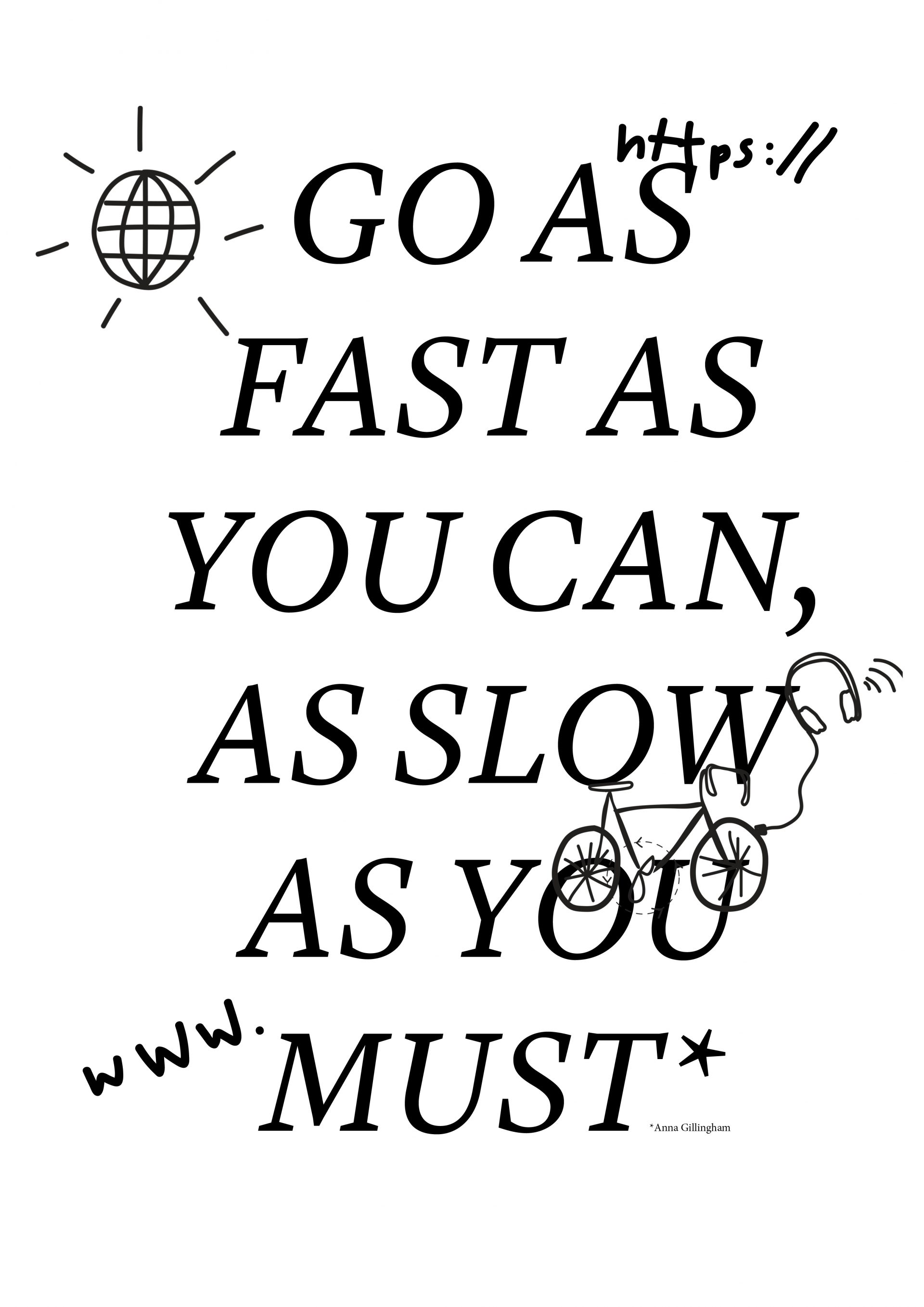
Bi-cycles for life-cycles (go as fast as you can, as slow as you must*) invites visitors to generate the energy required to listen to an audio recording of the Manifesto for an Ecosocial Energy Transition from the Peoples of the South by the Ecosocial and Intercultural Pact of the South, which “rejects false solutions that come with new forms of energy colonialism, now in the name of a green transition”. The recording is read by renowned Malian writer, filmmaker, cultural theorist, scholar and art historian, Manthia Diawara.
For those pedalling, the cost of energy and water regimes is made immediate and physical, as their pedal power will also help to stream the reading of the manifesto to an online audience (via websof.life) through the integrated cycle-powered web server. Without enough pedal power, the manifesto will not be audible. While a leisurely cycle produces 60W of energy, an intense one creates upwards of 300W. These amounts are insignificant compared to the hundreds of terawatts required to serve today’s ‘gigabit generation’ of users. Instead, this artwork encourages listeners to accept a ‘slower’ connection with the internet and question our dependency.
Read the Manifesto via exhibition portal websof.life
* Title taken from a quote by American educator and psychologist Anna Gillingham
The birds will keep calling you
At the South entrance of the exhibition, participants are asked to surrender their mobile phone in an act of a temporary severance. In exchange, those who agree are given an elemental token taken from the periodic table. What results is a display that recalls a taxonomic logic of the Enlightenment; that scientific mapping of knowledge amounts to mastery, or even ownership. Except here a networked technology, reliant on the neocolonial extraction of minerals and data, is re-imagined as a historical practice—a thing of the past.
Entering Web(s) of Life without access to camera and network, participants might instead become sensitive to what cannot be captured through a lens, or shared with the push of a button. In consideration to the ways in which digital steps also leave footprints, this performance invites participants to embrace a digital detachment: what is the ecosocial impact of our screen life? One movement sends vibrations through the webs of life: from the phone in your pocket to the lithium mines in Jujuy, Argentina, this battery-fuelled power dynamic helps prop up a digital memory whilst it erodes another, ancestral cache at the expense of the land and its people.
When visitors return to retrieve their phones, they are invited to offer their signature as an endorsement to the ‘Manifesto for an Ecosocial Energy Transition from the Peoples of the South’ and collect a copy of the Aerocene Newspaper II. The birds will keep calling you is conceived in solidarity with the indigenous communities of Salinas Grandes and Laguna de Guayatayoc, who are fighting against industrial lithium mining on their ancestral lands and with whom the artist has developed an ongoing, collaborative relationship for over seven years.
Nggamdu.org
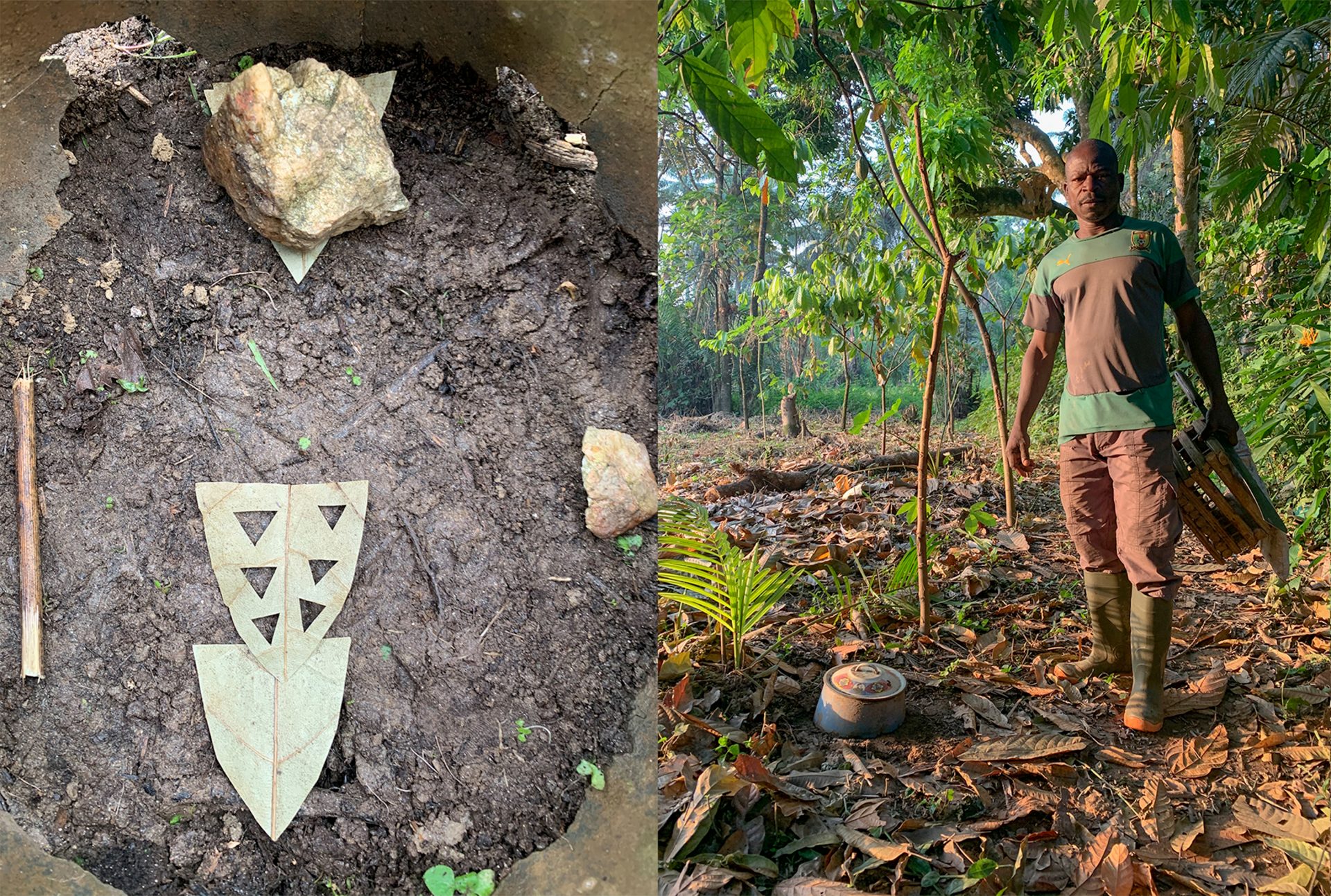
“Hello. I am a Cameroonian citizen. I live in Somié. I divine together with the ŋgam dù, the spider that lives in the ground, using leaves cut out with a series of symbols. So if you have a problem… you call me! I’ll consult the spider, and I’ll ask her your question. I work with a friend, my friend [Iréné Nguea], who films what I do with the spider. He can send you the result of the consultation as a film. So if you want to know more, check out our website: nggamdu.org”
—Bollo Pierre ‘Tadios’
Nggamdu.org is a web portal by the spiders and diviners of Somié, Cameroon, made at the request of Bollo Pierre ‘Tadios’ following a visit to Somié in 2019 by Tomás Saraceno and Maximiliano Laina, led by the guidance of anthropologist David Zeitlyn, with contributions by the filmmaker Iréné Nguea, Ollie George, Penny Fraser and Denis Ndeloh.
Request your consultation with the spider via nggamdu.org in exchange for a set fee that goes towards the spider diviners’ practice and their community needs.
World(ing)WideWeb(s).Life
In various cultures across the world the spider occupies a central place as a source of wisdom and divination: from ancient Nazca civilization of Peru to contemporary Cameroon. For over a decade, Tomas Saraceno has worked with arachnids and their built environment as part of the Arachnophilia community. World(ing)WideWeb(s).Life showcases their meshwork as both model and metaphor for more-than-human technologies of settlement and networking. Webs are at once an extension of the spiders’ bodily cognition and a materialisation of the ties that connect them to their environments. They are their home, the fruit of their labour, and what they give to the ecosystem of which they are part.
In the most recent development of this work, spiders suspend their webs between the branches of a tree; one of nature’s ingenious architectures built upon the next; one life slotted into another. What we see here is a welding of authorship, and a blurring of the lines between body, home and technology. To some, the spider/web connotes decay and abandonment, even danger. But here it appears as an object of a mysterious, otherworldly kind of beauty, as well as an intricate masterpiece of engineering.
The Arachnophilia community is an interdisciplinary network and research archive that seeks to make connections between scientific, philosophical and cultural perceptions of spiders and find ways to “connect and converse with arachnid kin”. For further information visit arachnophilia.net
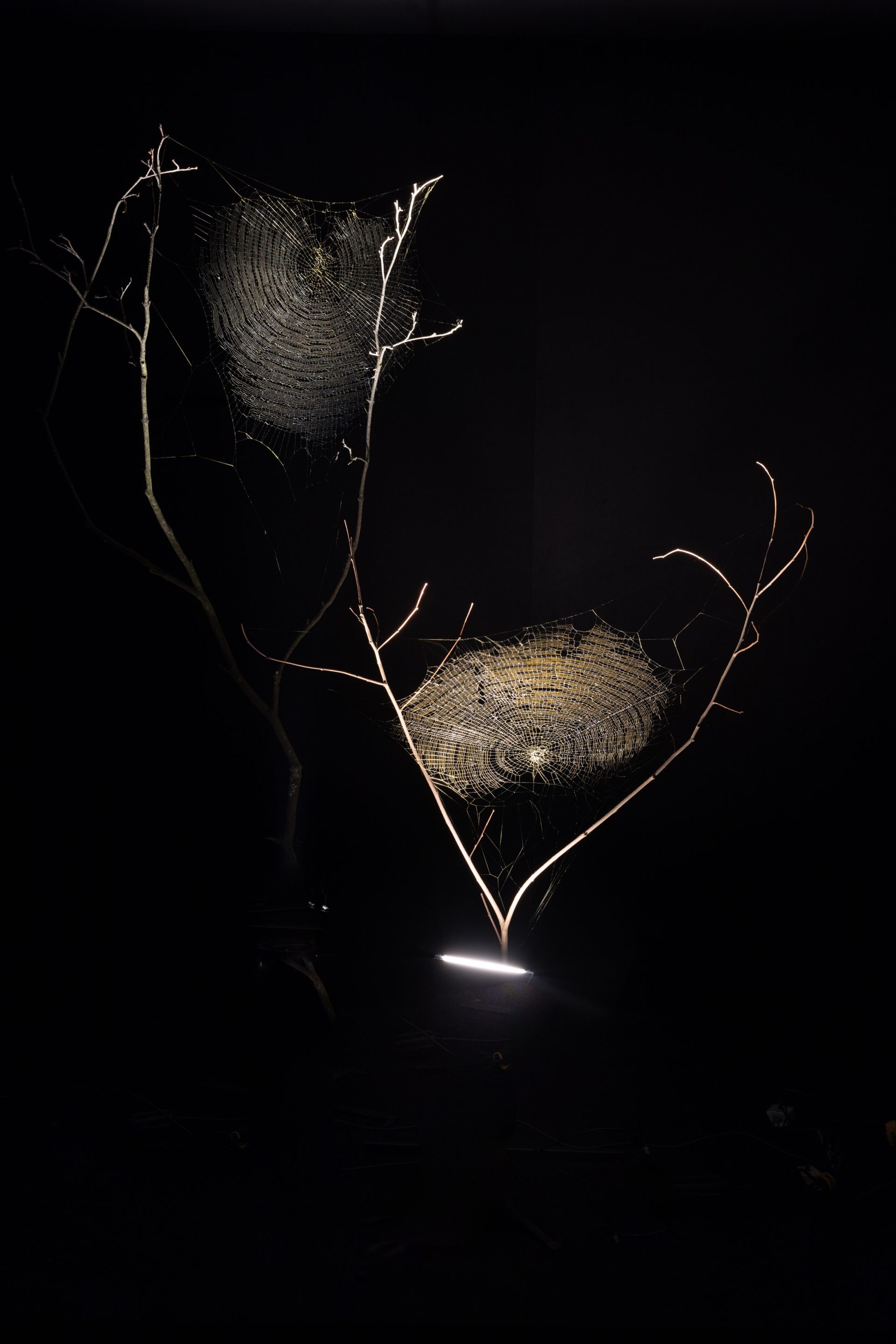
World(ing)WideWeb(s).Life, 2023. Installation view at Tomás Saraceno In Collaboration: Web(s) of Life, Serpentine, London, 2023. Photography by Studio Tomás Saraceno.
ArachnoAnarcóArcano
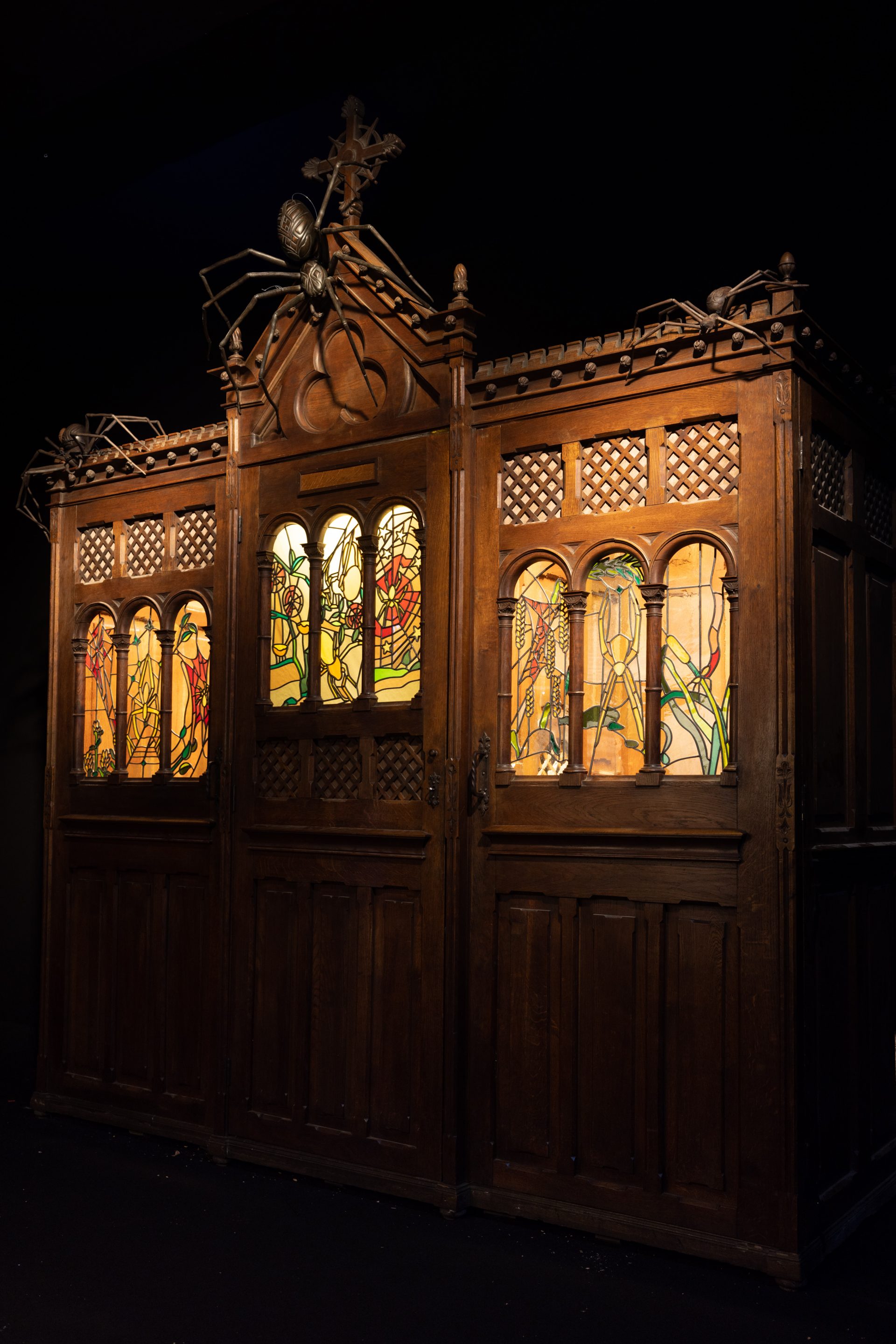
In your last encounter with a spider’s web, what greetings were exchanged? What might you say if you could talk to one another? ArachnoAnarcóArcano invites you to open a dialogue with another world, the world of the spider/web. Here, a Catholic confessional box has been repurposed for a syncretic encounter with a form of knowledge that far predates the Christian cosmology. In place of the priest, there is a spider/web, and in place of the endless cycle of sin and redemption is an opportunity to sense the spider’s vibrations, and learn from its wisdom.
The web-building spider communicates with the world through the vibrations it sends and receives through its web. The study of these seismic signals belong to the field of biotremology, which the Arachnophilia community, a research group founded by Tomás Saraceno in 2015, has been active in developing. Purpose-made microphones and a pair of shakers installed in the floor transmit the subtle vibrations to the threshold of human perception. Take your time and listen. Give in to arachnophilia.
Webs.Life 202.3 (Zombie spider)
Certain species of female wasps usurp spider/webs for their nests by laying an egg on the back of the spider, which, as it grows, co-opts the spider’s nervous system. The spider’s attention is then turned away from maintaining its own web, and onto building a resting place for the larvae. Once complete, the larva moults and kills the spider, spinning the zombie web into a hanging cocoon for its own rest in the days ahead.
Under the influence of the wasp, the spider weaves highly characteristic webs of a thicker thread and a different pattern than its usual one. Webs.Life 202.3 (Zombie spider) is a series of embroideries based on these mutant webs, which showcase the brutality, sophistication and beauty of an encounter in which one organism benefits at the expense of another. This dynamic abounds in digital spheres – notably across the ‘World Wide Web’, where the few wield the data of the many and is often accepted precisely for its seductive allure. But how do we resist manipulation, and maintain agency? Can you tell the difference between the spider’s own web and that of its zombie kin?
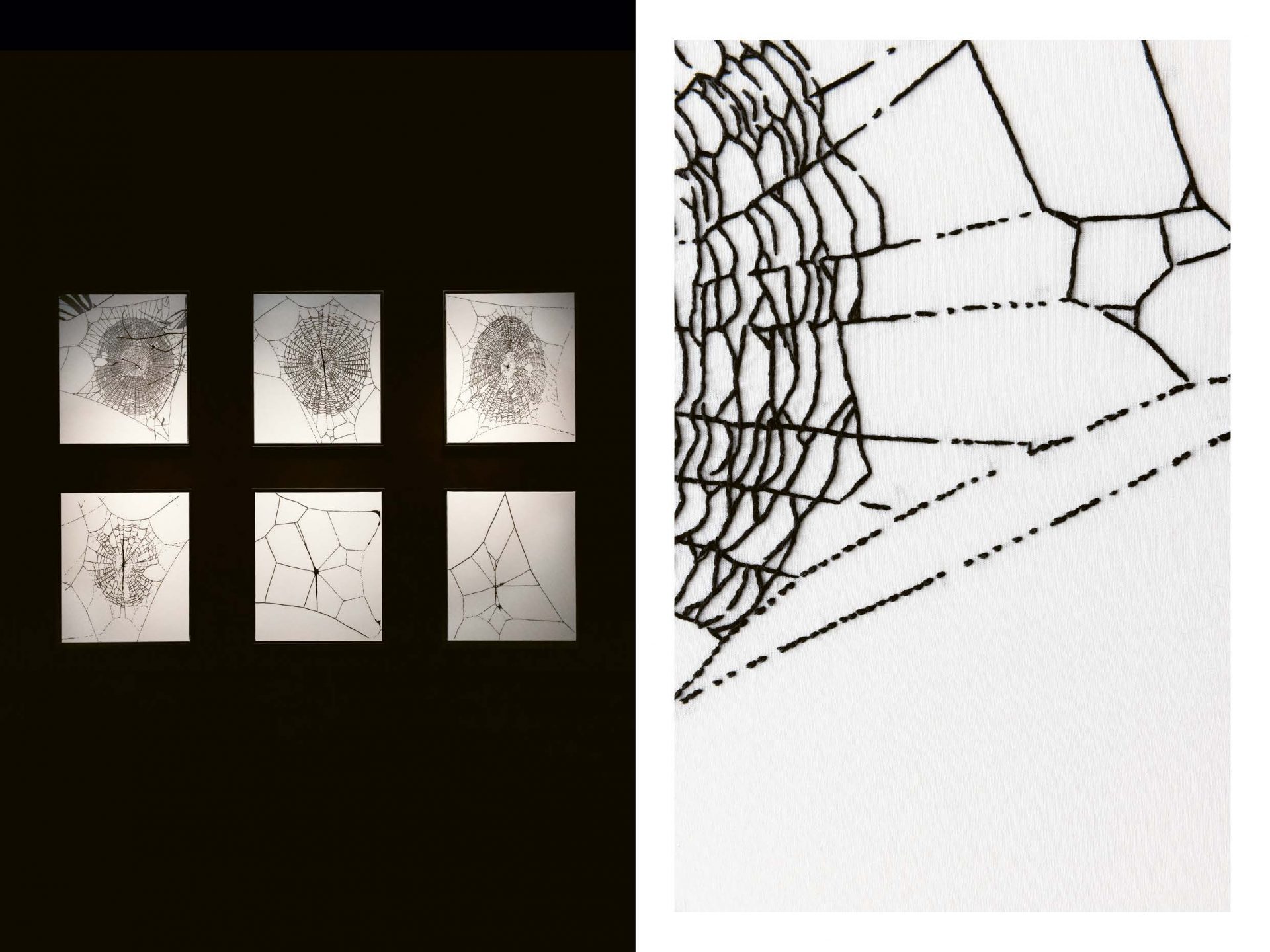
Fly with Pacha, Into the Aerocene
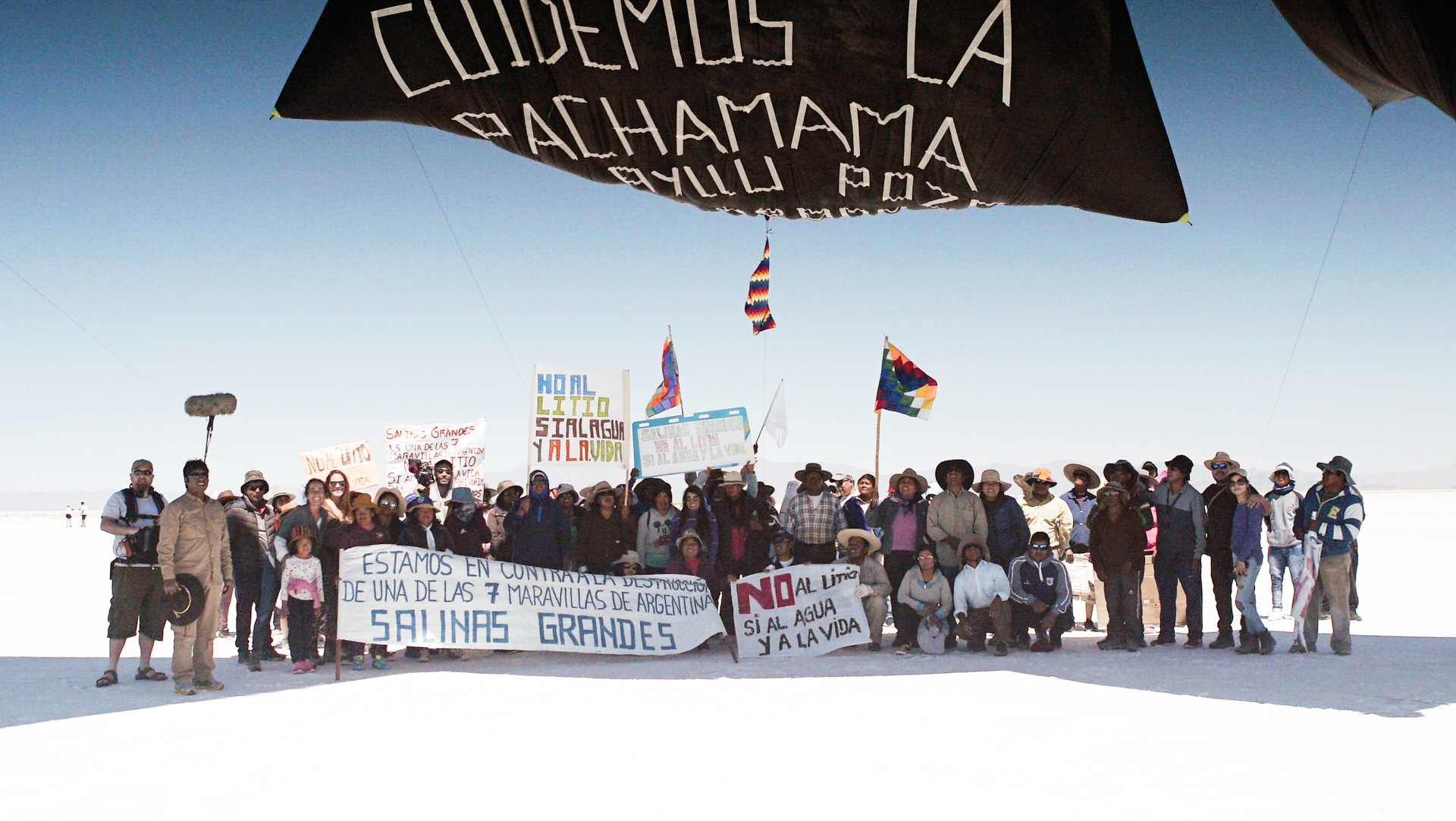
Pacha is an ongoing audio visual project that portrays the long-standing relationship between the artist, the Aerocene community he founded and the Communities of Salinas Grandes and Laguna de Guayatayoc, in Jujuy, Northern Argentina, who are fighting to protect their land against the rapid corporate extraction of lithium from the Salt Flats, driven by the demand for batteries, which is depleting water resources in the region and contaminating the Earth.
In Jujuy in January 2020, the aerosolar sculpture Aerocene Pacha rose using only the air and the sun, completely free from fossil fuels, batteries, lithium, helium, and hydrogen, becoming the most sustainable flight in human history. This journey set 32 world records, recognised by the Fédération Aéronautique Internationale (FAI), with Aerocene pilot Leticia Noemi Marques who flew with the message “Water and Life are Worth More than Lithium” written by the Indigenous Communities of Salinas Grandes and Laguna de Guayatayoc, Jujuy, Argentina.
Three years later, in January 2023, we gathered once again, as national and international geopolitical and commercial interests continue to pressure the basin. Faced with the worsening of the climate crisis and the urgency of the energy transition, the message is: We no longer want to be a sacrifice zone. The transition cannot reproduce the same extractivist, neocolonial politics that have been imposed on the Peoples of the South, amplifying social, ethnic and environmental inequalities. The Rights of Nature movement is striving for rivers, lakes, and mountains to bear legal rights in the same, or at least a similar, manner as human beings. We must listen to the voices of the territories, in defence of water, salt flats and the commons, for an ecosocial energy transition!
Full credits for the film can be found here.
Endorse your support for the communities via exhibition portal websof.life
Cloud Cities: Species of Spaces and Other Pieces*
There are birds you no longer see in the park around the Serpentine. Even the fairly ordinary house sparrow is listed in decline. The spotted flycatcher, the marsh tit and starling, too, are suffering from the proliferation of human settlements. What are the requirements for cohabitation and what can we do to enable them?
Cloud Cities: Species of Spaces and Other Pieces*, is a series of new sculptures installed inside the gallery, on the roof of the building and within the park. Developed in consultation with ornithologists and wildlife organisations, the sculptures provide specially-designed habitats for a range of animals, both native species and visitors to the park, some of which are in decline or in danger of extinction. The sculptures stand as meditations on biodiversity that imagine alternative models for interspecies encounters: nests and water baths for birds, houses for hedgehogs, objects conceived for dogs, nooks for invertebrates, and steps for squirrels to climb. In the event of their sale, the artworks’ contractual agreement includes a certificate of cohabitation that instantiates the animals and plants as co-owners and fellow stewards of the work.
The sculptures’ forms are inspired by cumulonimbus clouds, more commonly known as thunderclouds, which forewarn of stormy weather and occur more frequently as a result of climate change. These works are part of Saraceno’s long-standing project Cloud Cities. This proposal for an alternative form of urbanism brings together constellations of geodesic modules and is inspired by principles within the universe that affect the groupings of cosmic clouds and soap bubbles. Saraceno asks what forms of assembly and urban architecture might emerge when large cities are not only built from a human perspective.
This series is designed in consultation with: Ornithologist Anton Thøger Larsen, Mads Nørgaard Madsen, Butterfly Ambassador for Aalborg Municipality in Denmark and member of the Danish Society of Nature Conservation (DN), Martin Sloth Andersen, Chairman of DN.
*Title taken from French novelist Georges Perec’s collection of writing Species of Spaces and Other Pieces (1974)
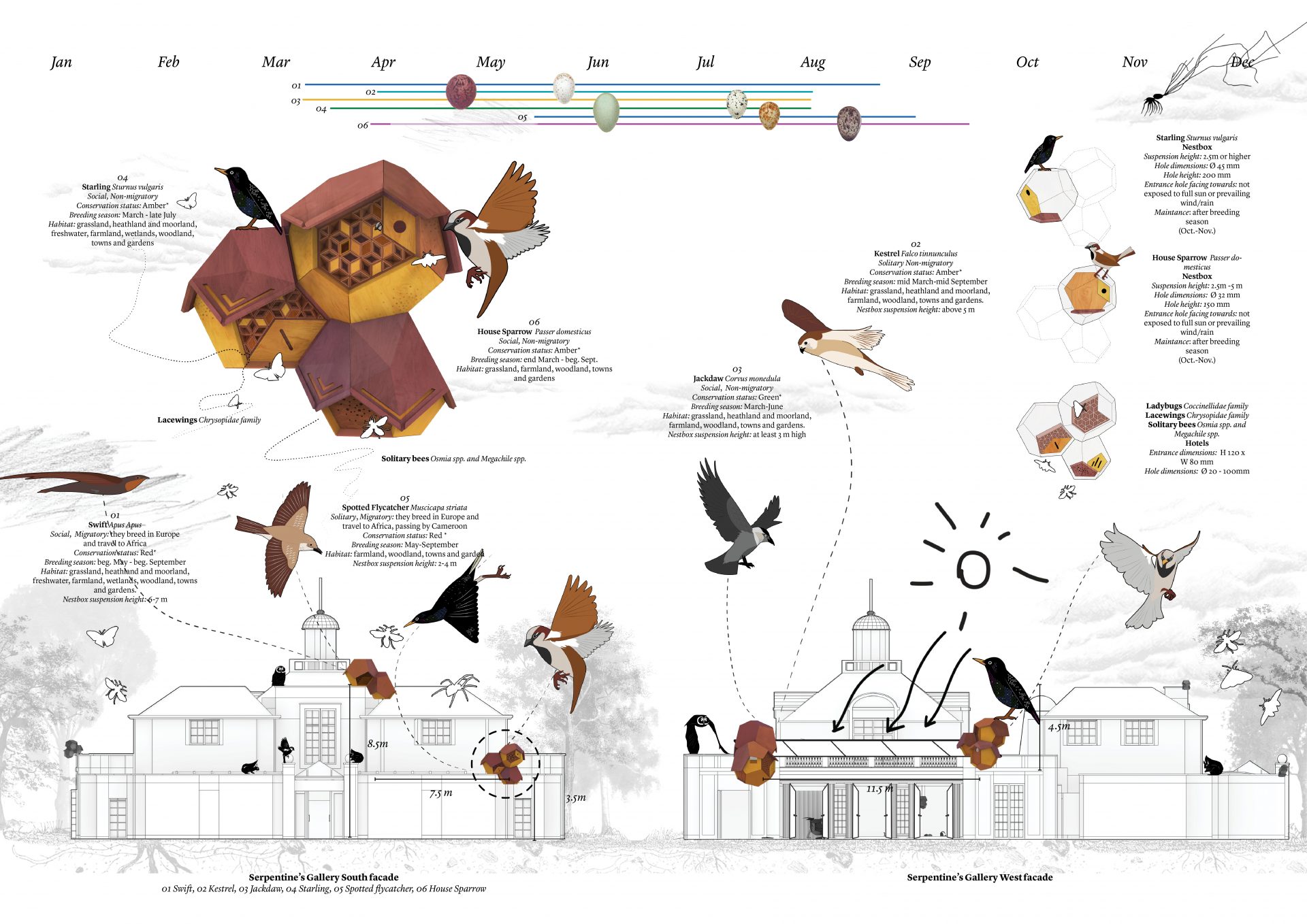
Cloud Imagination
What do we see in the clouds? What latencies are contained within their waters? As harbouring forms of the atmosphere, clouds have come to shape our imagination in both their physical and digital ubiquity; their various morphologies carry with them messages of weather-presents and futures, as bodies of water in the ocean of air that surrounds us. For the Indigenous communities of the Salinas Grandes and Laguna de Guayatayoc in Jujuy, Argentina, water is life. Crucial to their guardianship and life upon this land, they have long-defended its environment against industrial lithium mining that extracts, per tonne of this ‘white gold’ as much as 2 million litres of groundwater. Lithium mining is water mining.
Over the duration of Web(s) of Life, children were invited to create their own cloud drawings, and optionally donate them as inspiration for a new collective artwork. This evolving project will compose and relate the imagination of children from Jujuy with those in London who participate. Leaning into the fluidities of water, life and imagination, the ocean of air wields a canvas upon which other worlds of ecosocial justice and interspecies conviviality await their reveal.
The project is also an experiment in a new economic approach called Partial Common Ownership (PCO), as developed by Serpentine’s Future Art Ecosystems, RadicalxChange—a movement for 21st century political economies, and Studio Tomás Saraceno. This piece will not be traditionally owned by anyone, but will instead be stewarded by various parties to advance the Salinas Grandes communities in their own stewardship efforts to protect and maintain their biodiverse land.
For further information, please visit cloudcities.org

Acknowledgements
I would like to thank, first and foremost, the communities of Salinas Grandes and Laguna de Guayatayoc, in Jujuy, Argentina, and the spiders and diviners of Somié, Cameroon, who have offered to share their stories of resilience, modes of knowing and being in the world, with me over the last seven years. Without their reciprocity to open and sustain a dialogue of care and hope, this seeded book, exhibitions, web pages, newspaper, screenings, declarations and gatherings, would not exist.
Thank you Hans Ulrich Obrist, with whom it has been a pleasure to collaborate again after twenty years of friendship, and to Bettina Korek. Thank you also to Lizzie Carey-Thomas, Chris Bayley, Lucia Pietroiusti, Mike Gaughan, Lou Raggett, Nicolas Smirnoff, Rebecca Lewin and the outstanding team at the Serpentine, for helping me, the spiders, the communities, the air, the sparrows, the sun and many others to unite voices and dialogues in this collaborative, interspecies exhibition. I hold deep gratitude for the support of Espace Muraille, Eric and Caroline Freymond, who have helped to realise the dreams of the Aerocene Foundation, and who were crucial in making this exhibition possible.
To Verónica Chávez, President of the Community Santuario Tres Pozos, for her incredible activism and community organising that keeps uniting the communities together. To Joaquín Ezcurra and Maximiliano Laina, who have given their time and heartfelt commitment to the Aerocene—an era-in-the-making, a community, a non-profit foundation, a movement for all—and have brought its stories to life in Fly with Pacha, into the Aerocene. To Maristella Svampa, for her participation in the Aerocene gatherings and for enabling many of the alliances that give strength to this movement for ecosocial justice. Thank you!
A heartfelt thanks to all the communities of Salinas Grandes and Laguna de Guayatayoc Basin, the Aerocene and Museo Aero Solar communities, Action Collective for Ecosocial Justice, the Mirá Socio-environmental Collective, the Geopolitics and Commons Study Group, the Environment and Natural Resources Foundation, the Argentine Association of Environmental Lawyers, and the Ecosocial and Intercultural Pact of the South.
Thank you for dreaming of flying together to free the air, especially: Natividad Vilte, Inés Katzenstein, Graciela Speranza, Wolfgang Kaleck, Melisa Argento, Alicia Chalabe, Pia Marchegiani, Mariana Lumi, Laura Lumi, Antonia Alampi, Gabriela Cabezón Cámara, María Laura Castillo Díaz, Gastón Chillier, Marina Otero Verzier, Godofredo Pereira, Janine Randerson, Enrique Viale, Claudia Aboaf, Iosi Havilio, Hector Jaquet, Gabriela Sorbi, Alejandro Ortigueira (ADF), Paulo Sebastián Cazón, Marcelo Campitelli, Guillermo Eduardo Leniek, Jorge Vidal Sarmento, Fernando Ribero, Mariana Delgado, Lucas Ulecia, Abril Ayala Siman, Alejo di Risio, Nazarena Inés Tolaba Vercellone, Florencia Montoya, Camille Valenzuela, Olivia Laina, Taylor Rees, Agustin Kazah, Anna Sofie Hartmann, Manuel Fernandez Lorea, Juliana Manarino Tachella, Margarita Ezcurra, Jonas Weber, Margarita Ezcurra, Nubia Campos Vieira, Javier Hick, Santiago Mourino, Leonel Pazos, Paz Guevara, Mark Peranson, Adriano Salgado and Fernando Ribero, Martín Torres Manzur, Ezequiel “Kelo” Laina, Alcides Alcón, Churay Churay, Federico Baglietto, Virginia Vilte, Aurora Nélida Liquin, Saraí Arjona, Rafael Arjona, Mariana Cayón, Beatriz Pichi Malen, Miguel Lucio Cruz, Catriel Montano, Luciano Pablo Tacchino, Manuel Villalobos, María José Barbagelata, Carlos Andrés Bernal Skinner, Gato, Gabriela Olarieta, Triton Sonido, Manuel de Andrés, Micaela Ritacco, Alejandro Marani, Alejandro Marani, Manuel de Andrés, Alejandro Marani, Ignacio de Andrés, Lautaro Abrego, Chowa, Leandro ¨Jacha¨ Brignone, Manuel de Andrés, Micaela Ritacco, Gonzalo Nuñez, Ivanna Hryc and Maria Boughen, DaeHyung Lee and BTS, Alberto Pesavento, Till Hergenhahn, Leticia Marqués, Verónica Fiorito, Sasha Engelman, Jol Thomson, Emma Enderby, Rebecca Lamarche-Vadel, Yasmil Raymond, Francesca von Habsburg, Bronisław Szerszyński, Pablo Suárez, Nick Shapiro, Garance Primat, Carlos Almeida, Bill McKenna, Ludovica Illari, Daniel Birnbaum, Molly Nesbit, Sven Steudte, Barbara Bulc, Violeta Bulc, Josep María Llaidó.
Additionally, to the Arachnophilia community and archives, thank you for the never ending journey of sensitivity, learning to live with our nonhuman neighbours, especially to Bollo Pierre ‘Tadios’, Iréné Nguea and the people of Somié, Cameroon, ŋgam (the spider), David Zeitlyn, Penny Fraser, Denis Ndeloh, Peter Jäger, to Carolina Berro with the support of Mariana Lumi and Laura Lumi and her team, and many many more on arachnophilia.net.
I would furthermore like to thank the spider/webs, those living already at the Serpentine and in Kensington Gardens, in Cameroon, and beyond: Pisaura mirabilis, Erigone atra, Araniella cucurbitina, Pumpkin Spider, Centromerita bicolor, Misumena vatia, Salticus scenicus, Araneus diadematus, Platnickina tincta, Anelosimus vittatus, Philodromus albidus, Steatoda grossa, Pardosa palustris, Steatoda grossa, and Amaurobius similis, as well as Nephila senegalensis, Psechrus jaegeri, Cyrtophora citricola, Holocnemus pluchei, Larinioides sclopetarius and Uloborus plumipes, Heteroscroda crassipes. Also to the fox, the house martin, the sparrow, the bees, the wasps, the butterflies, the flies, the hedgehogs and squirrels, the dogs and cats who have been an inspiration, I hope you all feel welcome.
With thanks to Peter Tietz, A Production for their craftsmanship towards ArachnoAnacróArcano and also to Painting Srl, Luzzara RE, Italy, Carlo and Isabela Clavarino, Genova, Foundation Candido and Carla Fendi Speroni, Rome, Hofima SPA, Erica Roberts, Teresa A. L. Bulgheroni, Michele E.A. Codoni, and Paolo and Olimpia Falcone for the Falcone Foundation for the Arts, Palermo/Rome for their generous support.
At Kensington Gardens, thank you to Lucy Kellet, Charlotte Cass, Ian Rodger, and Andy Williams. The series Cloud Cities: Species for Spaces and Other Pieces*, 2023 (*Georges Perec), is designed in consultation with: Ornithologist Anton Thøger Larsen, Mads Nørgaard Madsen, Butterfly Ambassador for Aalborg Municipality in Denmark and member of the Danish Society of Nature Conservation (DN), Martin Sloth Andersen, Chairman of DN, and Alexandra Horowitz head of the Dog Cognition Lab, Barnard College. A heartfelt thanks to David Buck and Fridolin Rudolph, Domingo Del Sante, Ben Clark, Bernd Euler and team, Torsten Herzog and team, Raffaele Acquaviva, Elisa Baumgartner and the collective Lovely Projects, Sebastian Drucos, Pedro Serrano, Max Hausmann, Lucas Mateluna, Raquel Fernandez, Julius Heinrichs, Jan Wohlgemuth, to Klass der Rycke, Paul Covillault and Vishnukumar Rajasekar.
For the Ballad of Weather Dependency, 2023, thank you to Paul Hunter, Chris Nolan, and Mick Hunt from Railton Renewable Energy Limited, and Zeeshan Ahmad, from Aecom for the installation of the solar panels. For Bi-cycle for life-cycles (go as fast as you can, as slow as you must*) thanks to Zoë Louizos and Colin Tonks from Electric Pedals, The Bike Project, to Jin Lee, Valerian Blos and Graciela Melitsko Thornton who built the Pedal Server out of the Solar Server. The Solar Server was partly built with the ethos and documentation of project Solar Protocol by Sven Steudte, Ullrich Hergett and Sven Budkereit, to Ken Richards from 4billion, Hartmut Göpfert from Move Green, and Werner Schönewolf from banlabs and to Reduced Listening. A huge thank you to the Ecosocial and Intercultural Pact of the South for their manifesto and to Manthia Diawara for his reading of it, and to Sara Smith and Ant Marlow from ADi Audiovisual.
From my studio, with whom we never stop dreaming, an incredible thanks to the leading members Lars Behrendt, Sarah Kisner, Manuela Mazure Azcona, Claudia Meléndez Rivera and Jillian Meyer. For their enduring commitment to pushing our creative limits together, thank you to Miriam Aller, Gustavo Alonso Serafin, Duncan Anderson, Mateo Argerich, Victoria Bosch, Lucía Cash Beare, Thomas Charil, Filippo Corato, Maria Cristina Crespo, Carola Dietrich, Manie Du Plessis, Meike Fischer, Christian Flemm, Ollie George, Jan Grupp, Sven Hoffmann, Georgi Kazlachev, Dario Lagana, Tomás Matamala, Olivia Moore, Lea Nikou, Jaime Norambuena, Max Parnell, Tania Patritti, Matthew Raven, Patrick Reddy, Jazmin Schenone, Anna-Sophie Schmidt, Judith Straßenberger, Ilka Tödt, Alberto Vallejo, and Davide Zucco. As well, for their contributions to the exhibition, Francisco Alvarez, Giulia Ambrosini, Kelli Berg Mcllroy, Carolina Berro, Ally Bisshop, Sascha Boldt, Nicholas Boncardo, Vanessa Boni, Charles González, Samantha Grob, Alice Hall, Nemanja Kordic, Erik Mladenov, Paul Benjamin Oswalt, Martina Pelacchi, John Rohrer, Francisca Saavedra, Niki Sidirourgou, Lasse Skafte, Kristian Vistrup Madsen, and Philipp Weber.
With the endless support and commitment of my galleries: neugerriemschneider (Berlin), Tanya Bonakdar Gallery (New York / Los Angeles), Pinksummer Contemporary Art (Genoa), Andersen’s Contemporary (Copenhagen), and Ruth Benzacar (Buenos Aires).
And to my family, friends and supporters,
Thank you!
Tomás Saraceno
...